

Historical Hampi – a complete travel guide
Architecture , Karnataka
Last Updated on: Nov 2, 2017
Hampi was in our bucket list for long. The place has everything that could possibly pull us towards itself – the story of a lost kingdom, architectural marvels from our past that we could boast of and a rugged yet alluring landscape. Hampi being a UNESCO World Heritage site was an added attraction (my love for these old, dull, decaying structures is now well known to my readers). So Hampi had to be in our trip when we visited Karnataka this year.
Table of Contents
Where is the historical city Hampi?
Hampi, the historical and mythological city is located in Karnataka. From Bengaluru, the distance of Hampi is about 365 km and from Hyderabad, it is 380 km. So you can easily access the place from both Bengaluru and Hyderabad. Hospet is the nearest town. Thus Hampi can serve as a great weekend destination from Bangalore and Hyderabad.
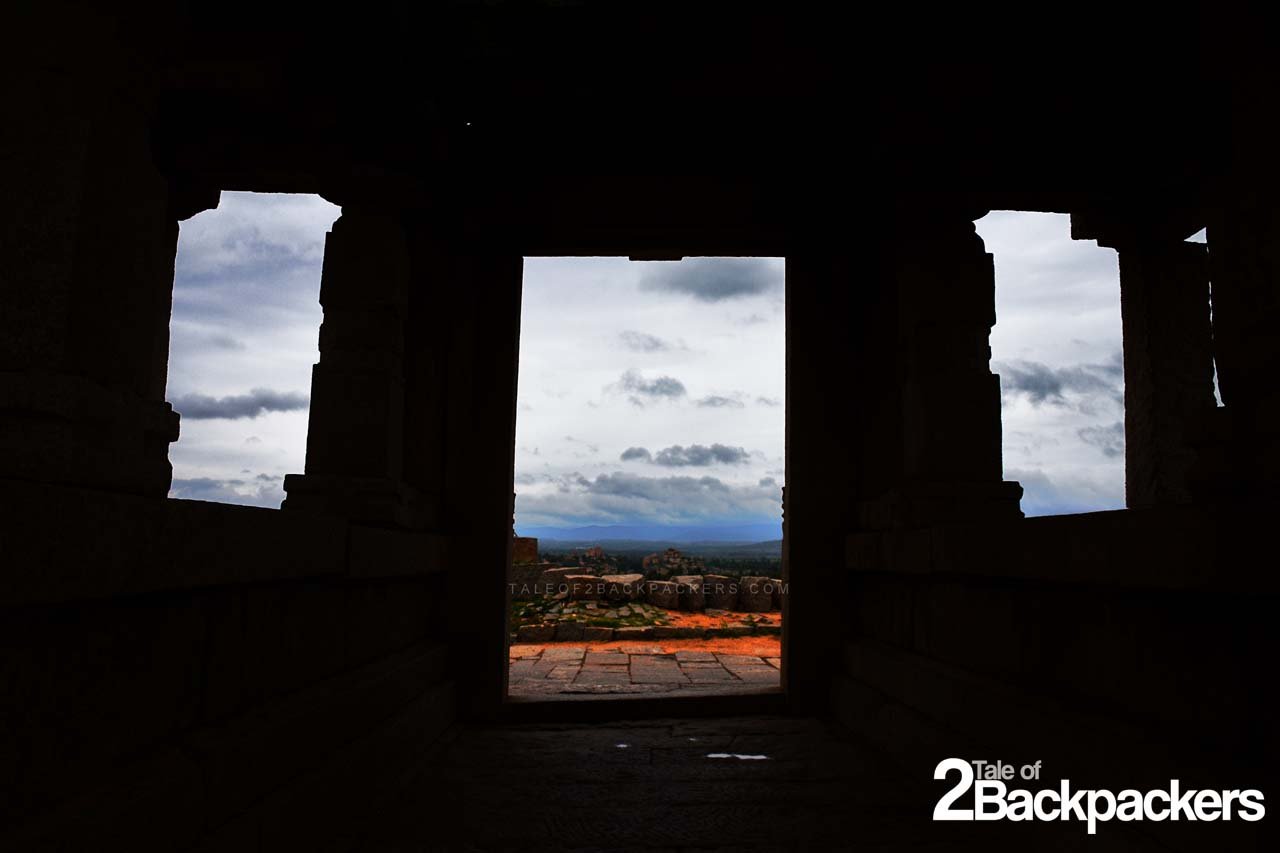
What is the History of Hampi?
Hampi is full of stories – stories from the historical past as well as the mythological anecdotes. Infact, the history of the place gradually mingles with the folklore and then subtly blends with mythology.
Hampi is also known as the Pampa Kshetra and Kiskinda Kshetra. These magical stories of Hampi are inexorably linked with the Hindu mythology.
Pampa was the daughter of Lord Brahma. She was a fierce devotee of Lord Shiva. The Lord pleased with her devotion wanted to grant her a boon. She wanted him as her husband. Lord Shiva had to give in to Pampa’s demand, but before marrying her, the Lord did penance at the Hemakuta Hills (He was already married to Parvati). And then it rained gold on the hill. “Hema” is the Sanskrit term for gold and hence the hill came to be known as Hemakuta Hills.
Hampi is also known as Kiskinda Kshetra. It is said that the Vanara kingdom of Kiskinda of the Ramayana was actually here. The Kiskinda episode of the Hindu epic Ramayana was based here at Hampi. Infact, it is believed that Anjaneya Hills was the birthplace of Hanuman, the faithful devotee of Lord Rama.
Those were the mythological stories around Hampi. The history starts with the popular folklore that two local chieftains Hakka and Bukka were on a hunting expedition when they viewed an unusual sight. A hound was chasing a hare which was normal. But suddenly, the hare became all-powerful and started chasing the hound. Hakka and Bukka reported this strange incident to their guru (master) Vidyaranya. The Guru could foresee the place to be special and asked his disciples to shift their local capital to that very place. Thus one of the richest and most beautiful kingdoms were born. This was during 1323 when the two brothers laid the foundation of the Sangama dynasty, the first rulers of Vijaynagar, the City of Victory. From 1323 to 1565 for almost 200 years, four dynasties ruled over Hampi and made the Vijaynagar empire one of the richest and famous empires. Hampi was also one of the biggest trading centres of those times and the markets of Hampi were always abuzz with traders and merchants not only from India but also from other parts of the world. No wonder that we see so many market areas in Hampi!
Hampi had reached its pinnacle during the reign of Krishna Deva Raya of Tuluva dynasty who ruled between 1509 to 1529. Hampi at that time reached great heights under the progressive and international trading practices. Also, the art and architecture flourished with beautiful and magnificent temples being made around the city.
But the golden era of Hampi did not last long. The empire was brutally attacked by the Deccan Sultans during 1565 and Hampi fell under their attack. The Deccan Sultans looted and ransacked the city for almost six months leaving only mass destruction everywhere. The temples were damaged and the markets were robbed; ultimately nothing left of the great empire. The empire was ruled by different kings after the massive attack, but it could never regain its lost glory. Gradually, the city lost its strategic importance and gradually lost into oblivion. The city became a ghost city.

The story about the boulders of Hampi:
The boulders in Hampi has the composition of granite. They belong to what is known as Eastern Dharwar Craton. A craton is a piece of the Earth’s crust that has existed as a solid, without being modified by plate tectonics, since they were formed. These boulders are highly metamorphosed.
However, Hindu mythology has a more dramatic and colourful answer to the boulders of Hampi. The place was believed to be Kiskinda and there was a battle for power between the two monkey brothers Bali and Sugreeva. In the fierce battle between the two brothers, the army threw boulders at each other and thus these boulders were piled up all around Hampi. Well, almost everything in India has a mythological essence linked to it.
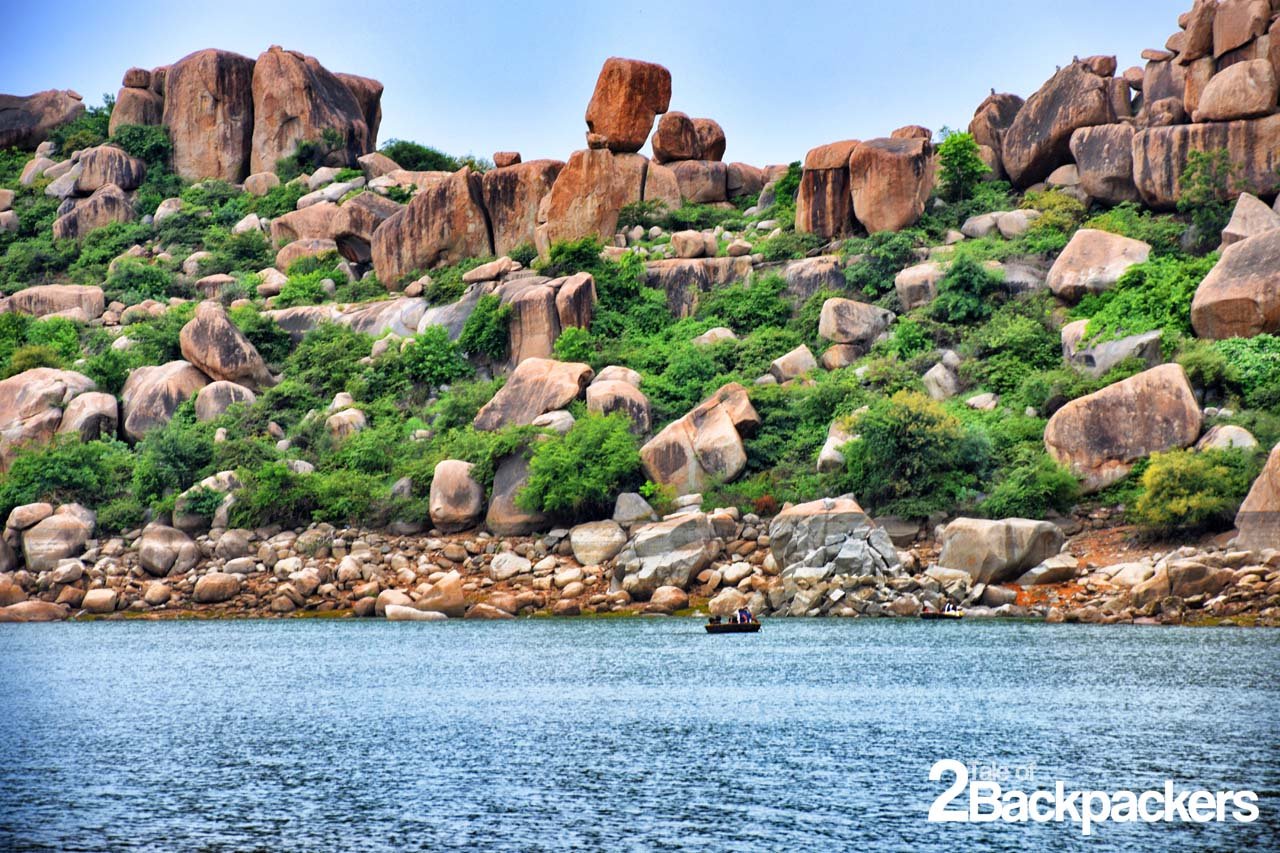
What is Hampi famous for?
Hampi is a wonderland. The place is like an open museum – you just have to explore the place at your own pace and discover its charm. And be ready to get surprised even at nondescript places; because even in ruins, Hampi is charismatic. So we have collated a list of places that should not be missed while you are at Hampi.
- The Virupaksha Temple
One of the most prominent structures of Hampi is the Virupaksha Temple located on the southern banks of the Tungabhadra River. Standing tall near the market area, it is not easy to miss the temple. It is an important place of worship for all the Shiva worshippers. The temple is a grand structure sprawling over a large area with many smaller shrines, pillared halls and gateways. The temple also has an interesting engineering marvel – working of one of the first pinhole cameras can be seen here.
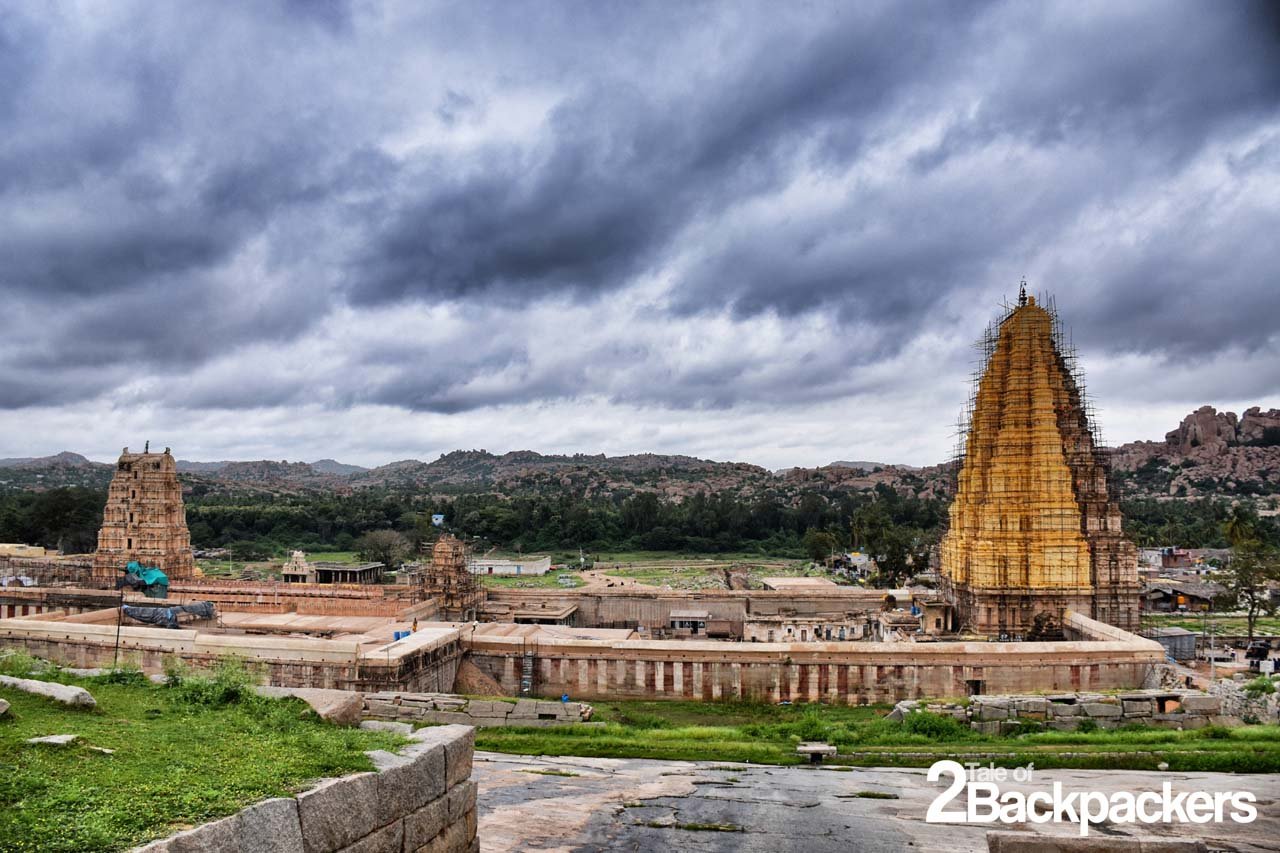
- The Vijaya Vittala Temple
The Vijaya Vittala Temple is the most extravagant architectural wonder of Hampi. The temple is spread across a large complex where there are numerous halls, pavilions and gateways. Outside the main temple complex, there are other ruins also. Seems like an entire town had been set up there. In fact, it is the remains of the ancient town of Vittalapura. Vittala, another form of Lord Vishu was worshipped in the temple. The most extraordinary feature of this temple is the stone chariot.
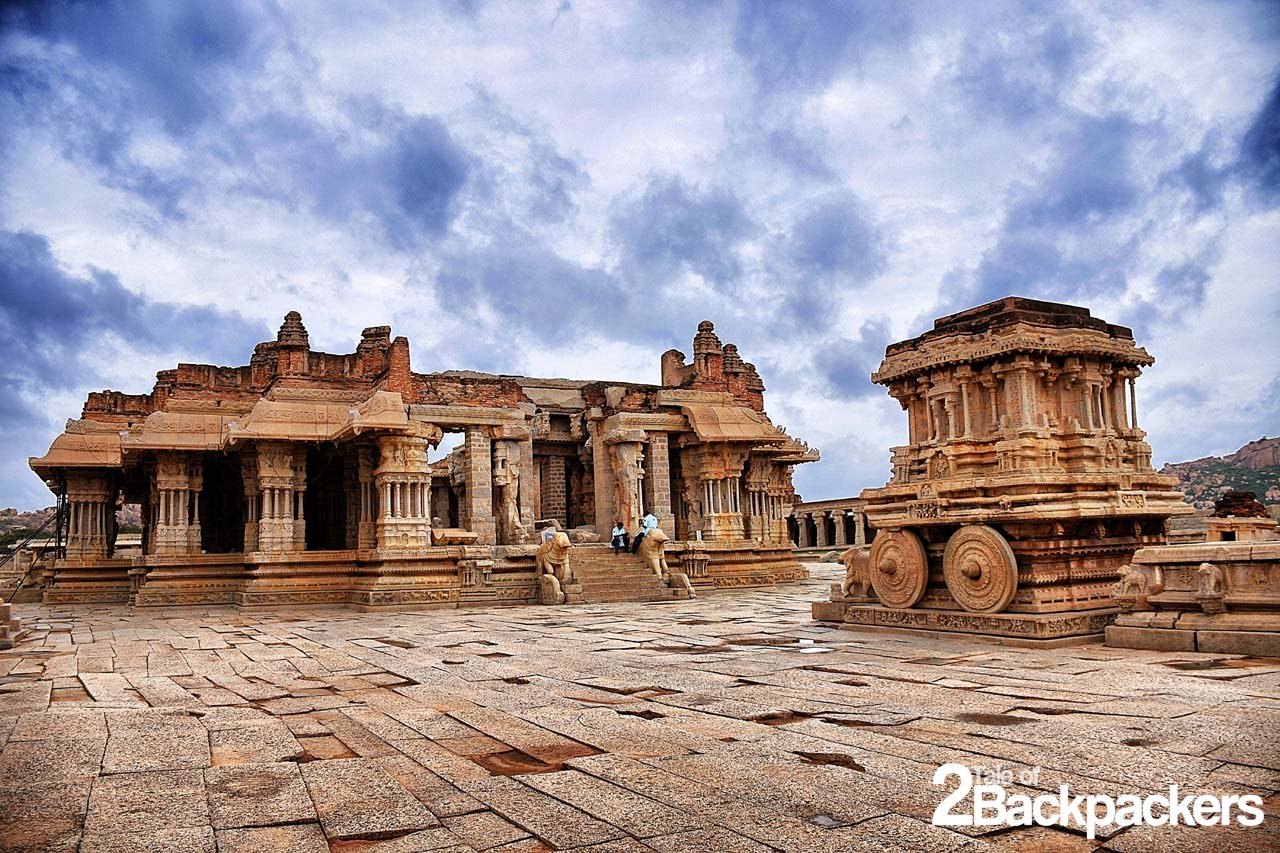
- Hampi Bazar
Near the present day market of Hampi, also stands the old Hampi Bazar. The bazaar is also known as the Virupaksha Bazar and is located in front of the temple. The sides of the street are lined by old pavilions that used to the yesteryear markets.

- The Lakshmi Narasimha Temple
The Lakshmi Narasimha statue is the largest statue in Hampi. Narasimha is sitting on the coil of Seshnag, a giant seven-headed snake. The statue presents a menacing look of Lord Vishnu in his Narasimha avatar (incarnation). The original statue had Goddess Lakshmi sitting on the lap of the God. But the statue was damaged heavily during the fall of the Vijaynagar empire.

- Krishna Temple
The Krishna Temple was built by the King Krishnadevaraya in 1513 AD to commemorate his victory over the kingdom of Udaygiri or Utkala (in the present day Odisha). The main idol inside the temple was the figure of Balakrishna (Lord Krishna as an infant). This idol is now displayed in the state museum at Chennai. There is a huge slab inside the temple that tells the story of the conquest of Utkala.
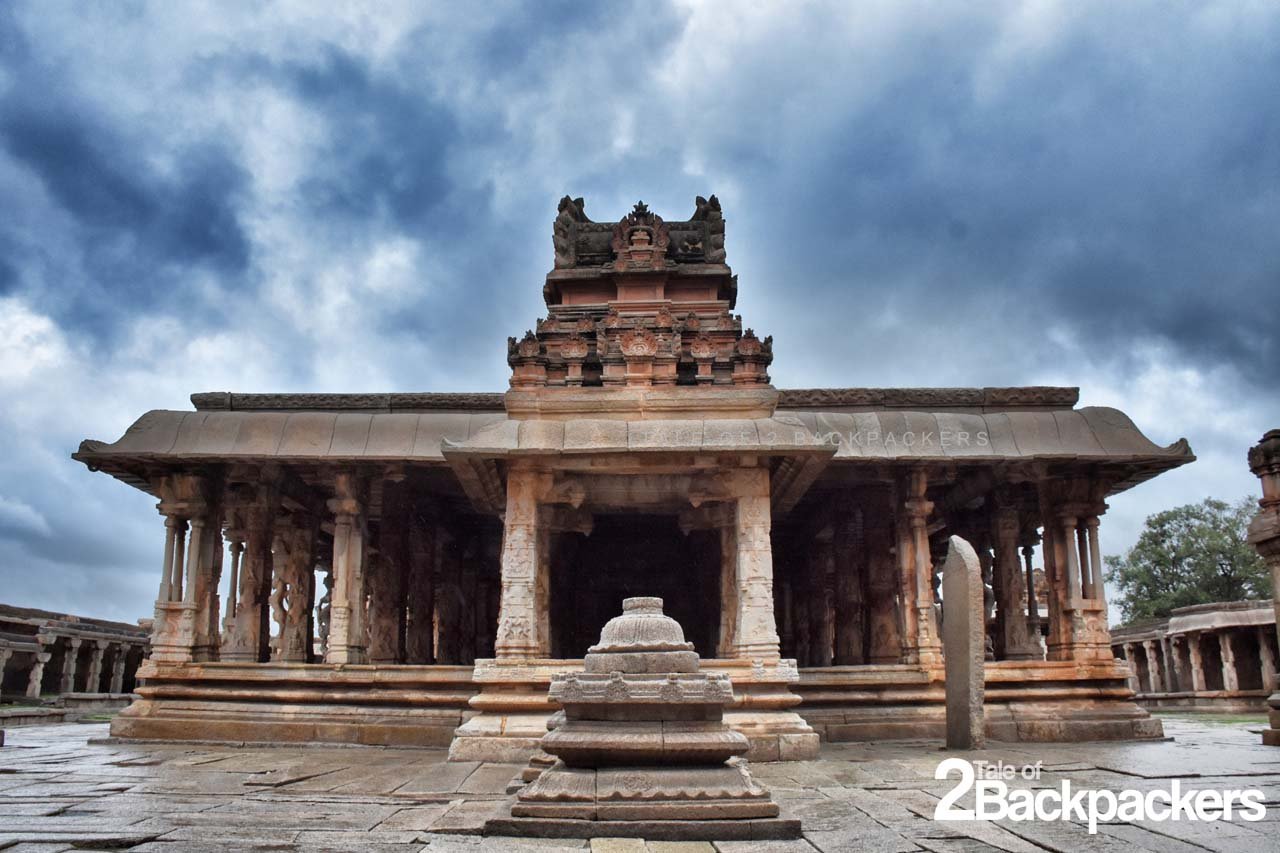
- Hemakuta Hills
The hill is just near the Virupaksha Temple. The hill provides a gorgeous sight of the Virupaksha Temple and the other ruins of the Vijaynagar empire. The hill itself has a large number of ruins of temples, archways and pavilions. This is one of the places to view the splendid sunsets at Hampi.

- Sasivekalu Ganesha
The temple is situated very near to the Hemakuta hills and a little south of the Kadalekalu Ganesha Temple. This is a giant statue of Lord Ganesha.
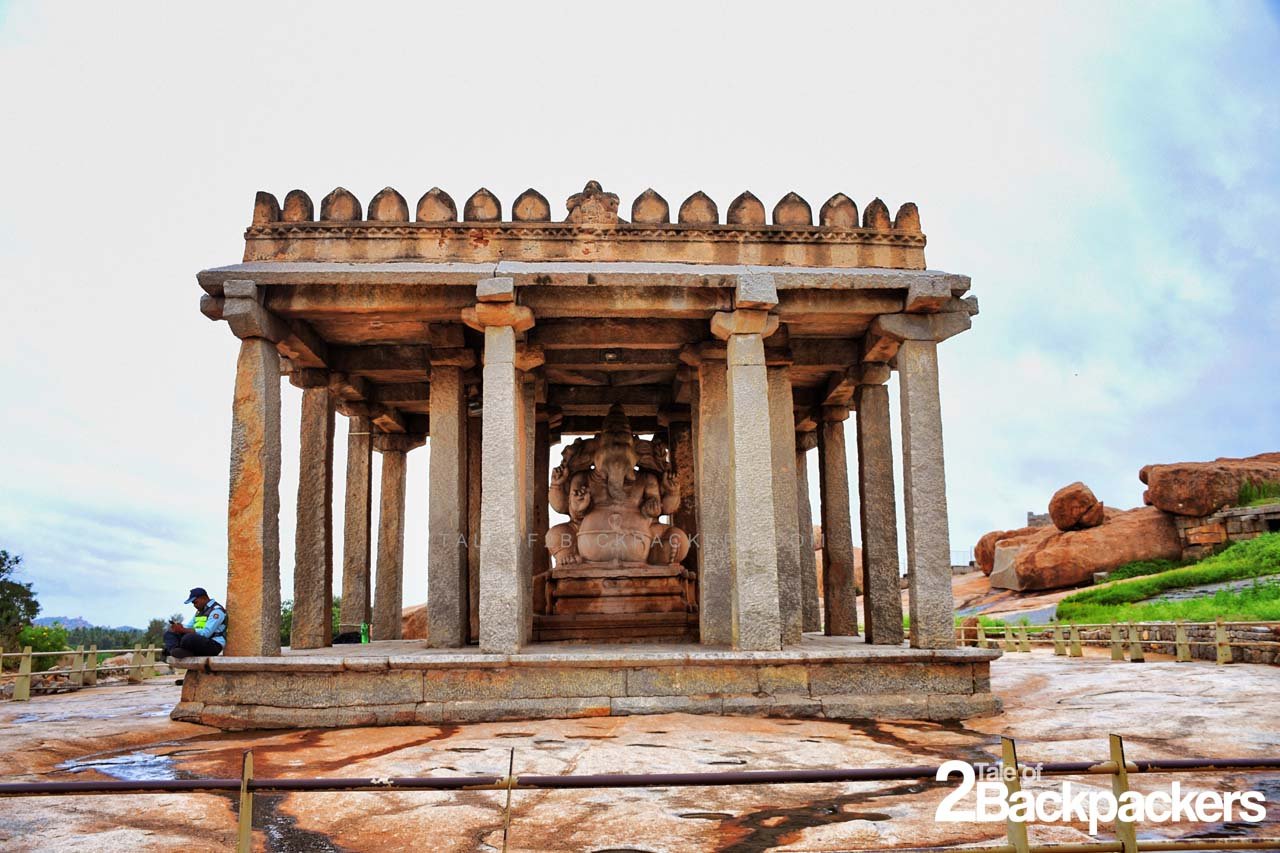
- Kadalekalu Ganesha Temple
This temple is situated on the north-eastern slope of the Hemakuta Hills. Here a giant statue of Lord Ganesha is present that is carved out of a single stone.The belly of this statue resembles a Bengal gram (Kadalekalu, in local language) and hence the name.

- Matanga Hills
The Matanga Hill is just at the centre of Hampi and you can get a bird’s eye view of the entire place from here. while at Hampi, do not forget to view the spectacular sunset from the Matanga Hills. We missed the sunset at Hampi this time because it was raining heavily on both the evenings of our stay!
- Hazara Rama Temple
The Hazara Rama Temple was built in the early part of the 15 th century by Devaraya II, the emperor of Vijaynagar. This small but beautiful temple is located in the centre of the royal area. The temple once served as the private temple of the royal household of the Vijaynagar empire. The “Hazara Rama” literally means “a thousand Rama” and the temple carries the story of Ramayana carved on stone. The relics found in this temple is one of the most extensive ones found in India.
- The Anjaneya Hill and Temple
The Anjaneya Hill is believed to be the birthplace of Lord Hanuman. The hill is located on the other side of River Tungabhadra on the Anegondi Area. There is a temple on the hilltop dedicated to Lord Hanuman.
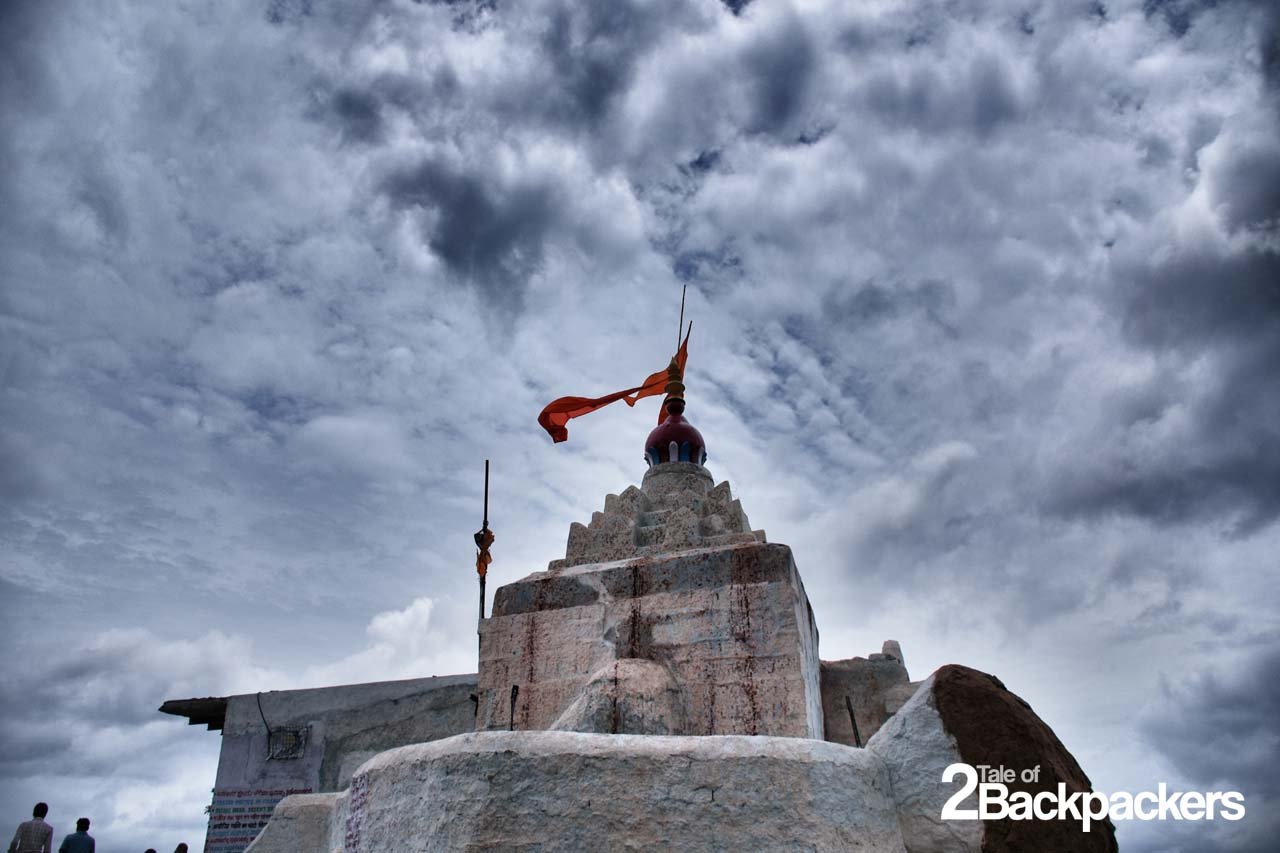
- Pampa Sarovar
The Pampa Sarovar is one of the sacred ponds among the Hindus and is located near the Anjaneya Hills. There is a temple dedicated to Lord Shiva and his consort Pampa Devi beside the pond.

- Durga Temple
The Durga temple is also located on the Anegondi side on a small hillock. The temple is located at the base of a fort. Hence it is also believed that its name is derived from the word “Durg”, meaning fort. We moved further from the temple towards the gate of the fort. There were a number of tombs belonging to the Vijayanagar dynasty. We trekked a further up and came to the edge of a rock. The place was simply out of the world. The whole of Hampi was in front of us – we got a panoramic view of the whole place. Didn’t I tell you that Hampi would surprise you at the strangest of places? We never thought that the place would be so beautiful.
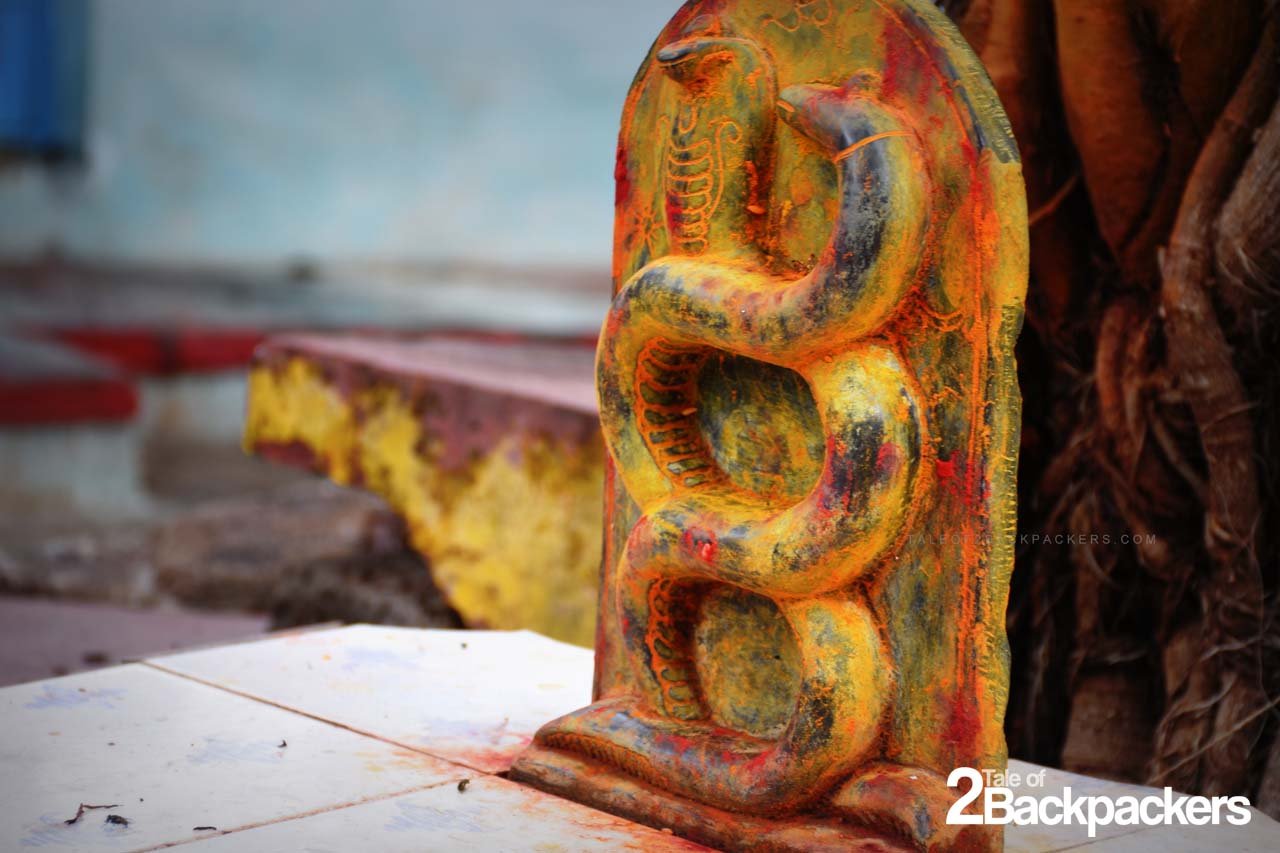
Other places of interest at Hampi are the Queen’s Bath, Mahanavami Dibba, Zenana enclosure, Courtesan’s Street, Royal enclosure, Sugreeva’s cave and Bhima’s Gateway.
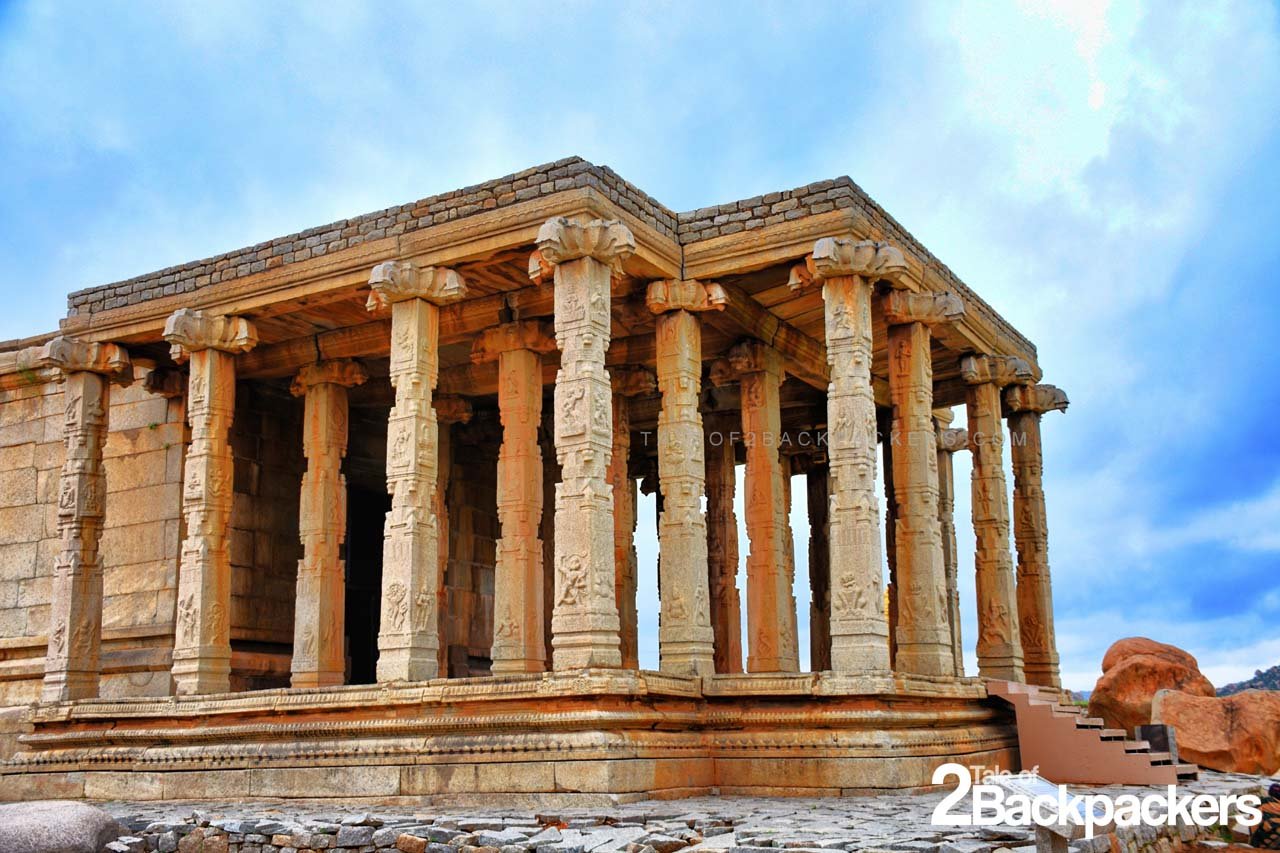
How to Reach Hampi?
The nearest railhead to Hampi is Hospet. Hospet is well connected to Bangalore by buses and train. From Hospet, you can take an auto to Hampi. We took an overnight bus from Bangalore to Hospet. From Hospet we took an auto to Hampi. The auto took Rs.150 from us. There are local buses from Hospet to Hampi that you can get from the Hospet bus stand.
The nearest airport to Hampi is the Bengaluru airport.
Places to stay & eat:
Hampi has a lot of accommodation options for various ranges. You can stay near the market area near the Virupaksha Temple where you will find a lot of options according to your choice. We stayed at the Rocky Guest House.
You can also opt to stay on the other side of the Tungabhadra River. There are a number of homestays in this area. This area has a Goa like feel to it. The foreigners mostly stay in this part.
Hampi has a number of restaurants for eating out. Most of the guest houses have restaurants on their top floor where you can eat.
If you want cheaper eating options, the best places are the roadside shops. We had great South Indian fares at the roadside at a very cheap rate.

What is the best time to Visit Hampi?
Hampi can be visited all round the year. but given that you have to roam around a lot around Hampi, the winter season are the preferable time. Also, the Hampi Festival is held during the month of November.
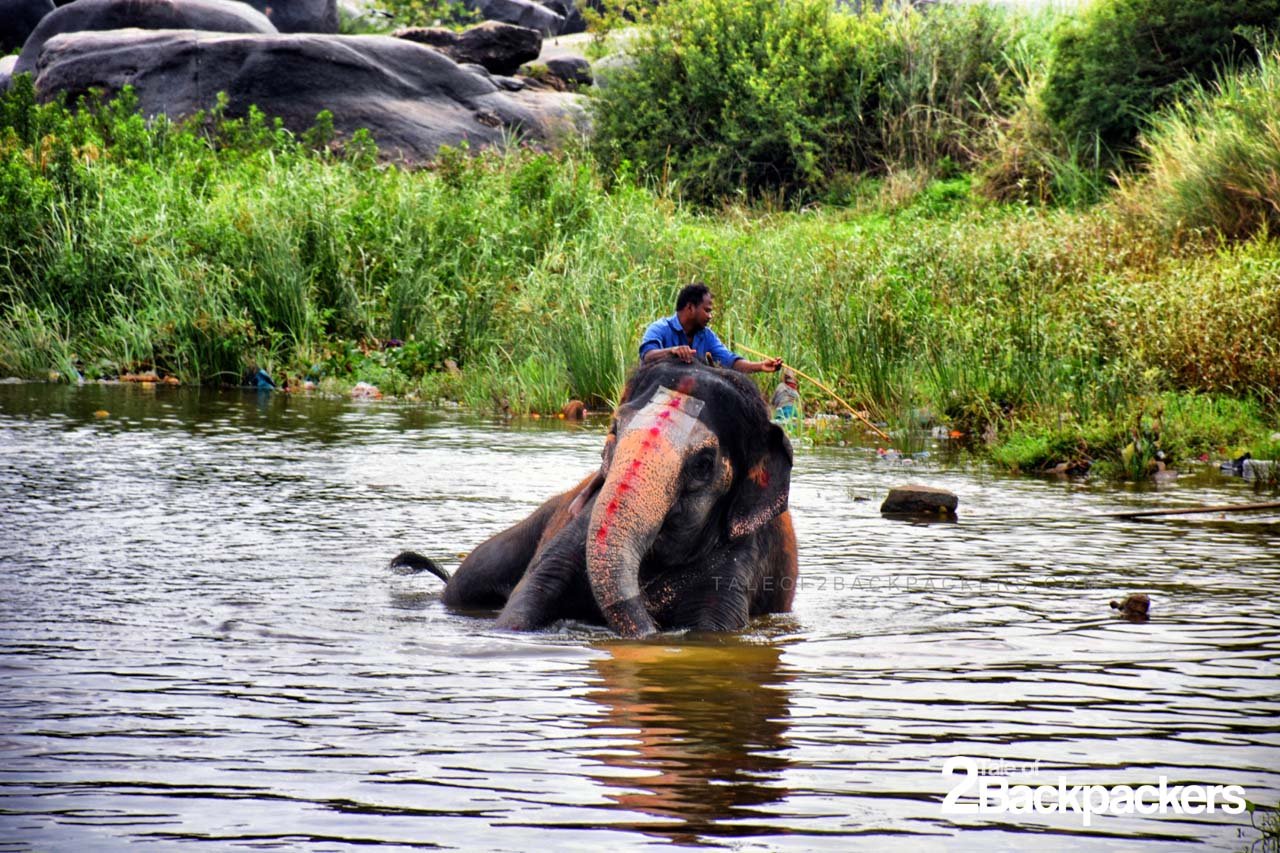
What is the best way to travel around Hampi?
Hampi is a place that should be explored and discovered by yourself. At Hampi, you will get bicycles at rent at very cheap rate. You will get bicycles without gear at Rs.100/- per day and with gear at Rs.150/- per day.
You can also get moped for rent at Rs.200/- per day. You will not get scooty and bikes for rent at the temple side of Hampi.
At the Anegundi site, you will get scooty and bikes for rent at Rs.250-400/- per day depending upon your vehicle.
The rate of the vehicles may also vary with seasons.
There are also autorickshaws that you can take to see the various places in Hampi.
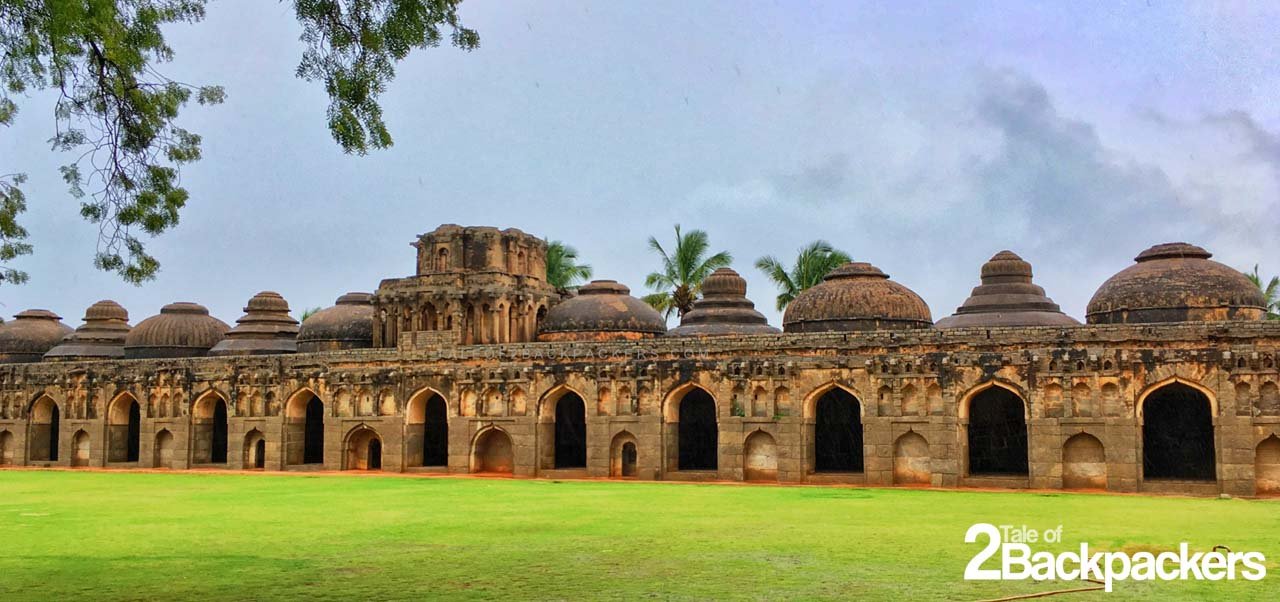
Why should you visit Hampi?
If heritage and history is your thing, if you get intrigued by the stories of the past, then Hampi is a place that you must visit. Each stone in Hampi tells a story, be it stories about the Vijaynagar kingdom or the mythological stories that are so good to listen.
If you like the architecture of the past, visit Hampi. The Virupaksha Temple and the Vittala Temple are the finest examples of architectures. You will simply get awed by the intricate designs and craftsmanship of these structures.
If you like adventure, then you must visit Hampi. You will get wonderful opportunity to do bouldering. The coracle ride at the Tungabhadra river is also a beauty.
If you love nature, visit Hampi. A small temple town beside the Tungabhadra river dotted with numerous boulders seems a playground for nature’s architecture.
Simply visit Hampi. Unless you visit the place, you will definitely not know why you should visit Hampi.
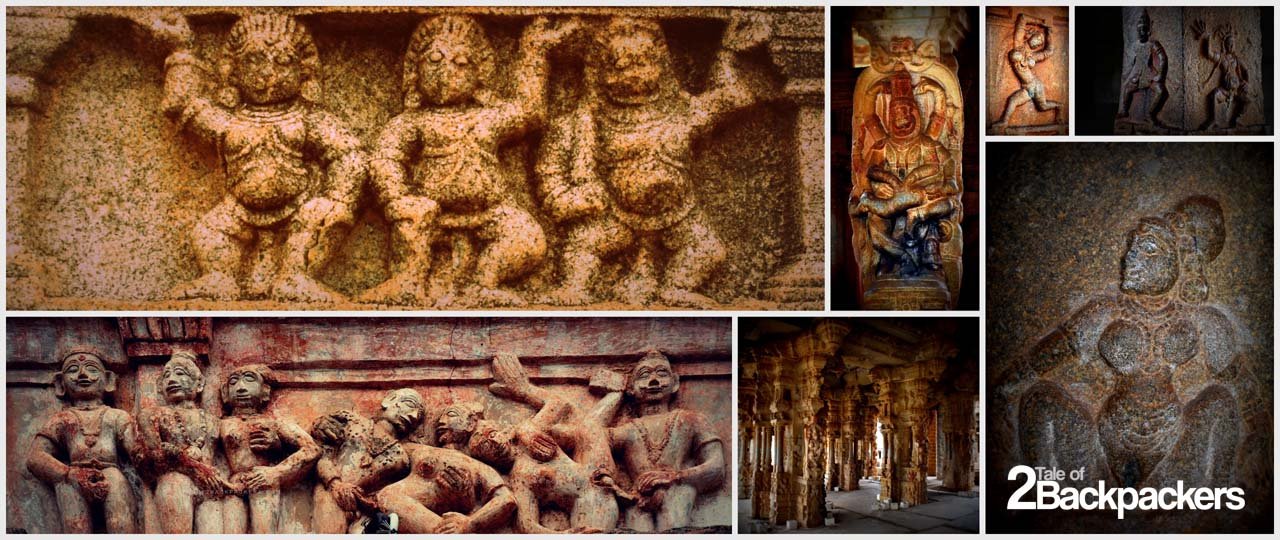
Some important tips:
- Ideally, it would take around 3 days to visit Hampi. But you can see most of the important places in two days. We did a two days trip to Hampi and covered almost all the places. Unfortunately, we had to miss the Matunga Hills as it was raining heavily in the evening on both the days.
- Most of the places are opened from sunrise to sunset.
- Wear comfortable clothes and shoes as you have to roam around a lot in Hampi. That is why shoes are very important.
- Reserve one day for the Anegondi side of Hampi. Believe me, this also a wonderful place. The views from the Anjaneya Hills and the top of the Durga Temple is simply breathtaking.
- While at Hampi, do not forget to take a coracle ride at the Tungabhadra River. This is going to be an experience of a lifetime.
- Do not forget to meet Lakhsmi, the elephant of the Virupaksha temple. Lakshmi goes for a bath every morning at the Tungabhadra River. try not to miss the scene.
- You can cross the Tungabhadra River near the Virupaksha temple to go towards the other side. There are motor boats that take Rs.25/- per head. And if you want, you can also get a coracle to cross the river to the other side.
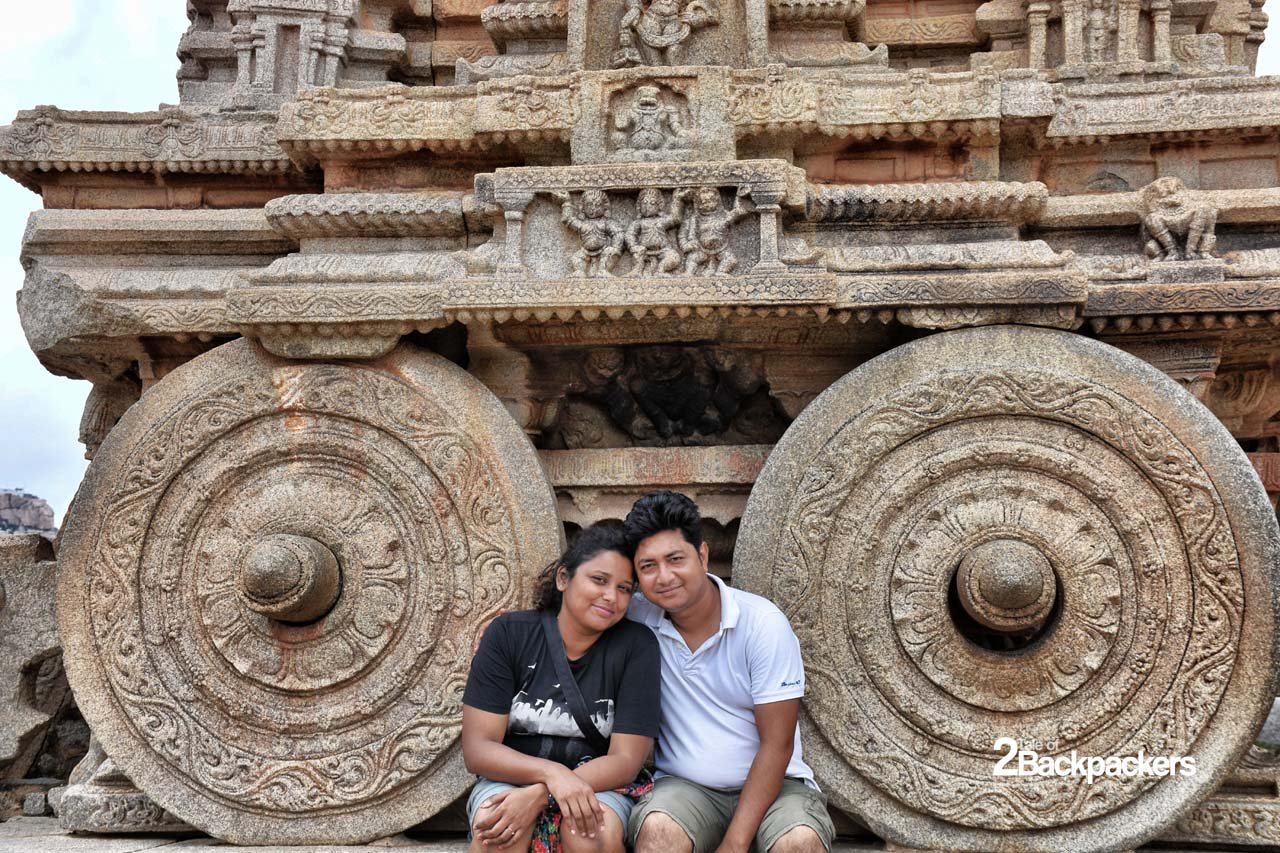
Did you like the post? Please share your views by commenting below. We would love to hear from you. Also, contact us if you need any help in planning your trip to Hampi.
Reproduction of the content, including the photographs without prior consent/permission of the writer and photographer, is not encouraged at all and a violation of the same will attract legal action. If you need anything, Contact Us .

Hey! we’re Agni & Amrita.
We have been travelling together since the last 15 years and writing independent and personal travel content since 2014. Travel is one of the best teachers and through this blog, we aim to share our experiences and travel tips. We encourage you to travel more and see the world through your eyes and not through filtered templates.
Find more about us.
RELATED POSTS
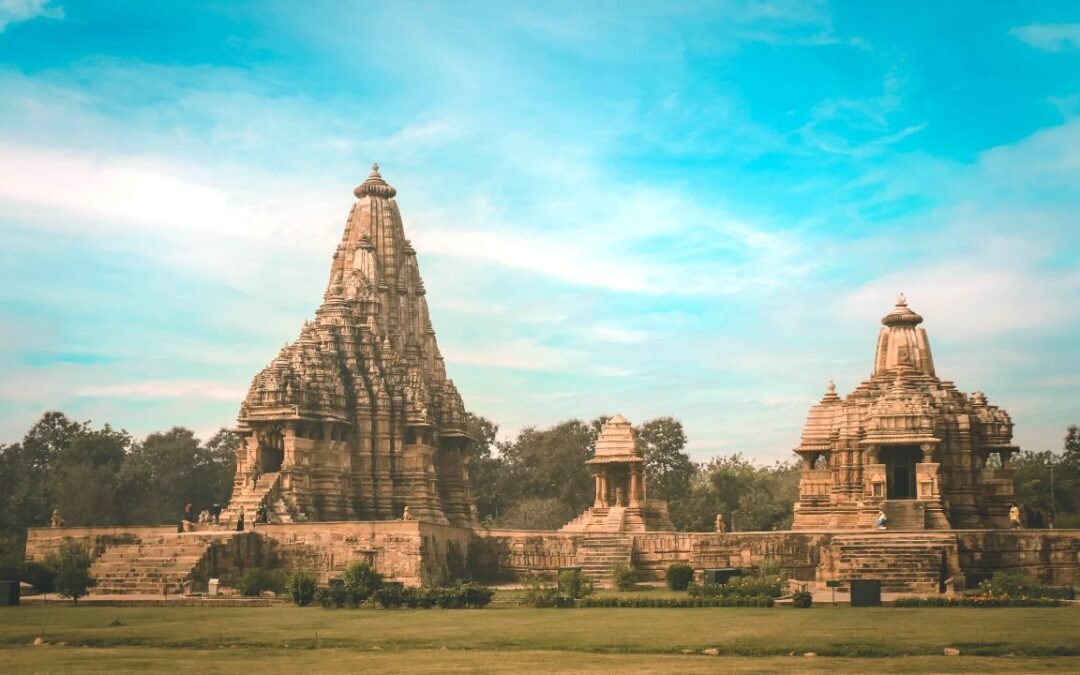
Temples of Khajuraho – A Complete Travel Guide to Visit Them
About the Blog: Khajuraho is one of the most famous tourist destinations in India. The temples of Khajuraho are undoubtedly one of the best in terms of temple architecture in India. The temples of Khajuraho are divided into three parts – the western, eastern and...

Best Places to Visit in Orchha – A Complete Travel Guide
About the Blog: The erstwhile capital of the Bundelas, Orchha is a laid back town in Madhya Pradesh. Offering a rare glimpse into the history, Orchha boasts of temples, forts, palaces and historic monuments. Read our blog to know more about Orchha, the places to visit...

Basgo Monastery, Ladakh – Ruins of Palace and Fort
About the blog: Basgo Monastery is a beautiful and important place to visit in Ladakh. Located about 40 km from Leh town on the Srinagar-Leh Highway, you can see the ruins of Basgo Gompa and fort from a distance. Basgo has an interesting history and was once the...

Rani ki Vav, Patan – The Queen of Stepwells Built by a Queen
About this blog: We had seen it on the lavender coloured 100 rupees Indian currency. Rani ki Vav, located at Patan in Gujarat is truly the Queen of stepwells, not only because of its grandeur in architecture and construction, but also for the vision. We had recently...

Sun Temple Modhera, Gujarat – History, Architecture & Interesting Facts
About this Blog: Sun Temple Modhera is one of the finest temples of India and has been on my bucket list for a long time. Located in Mehsana district of Gujarat, Modhera Sun Temple is an excellent example of medieval temple art and architecture of India. Read this...
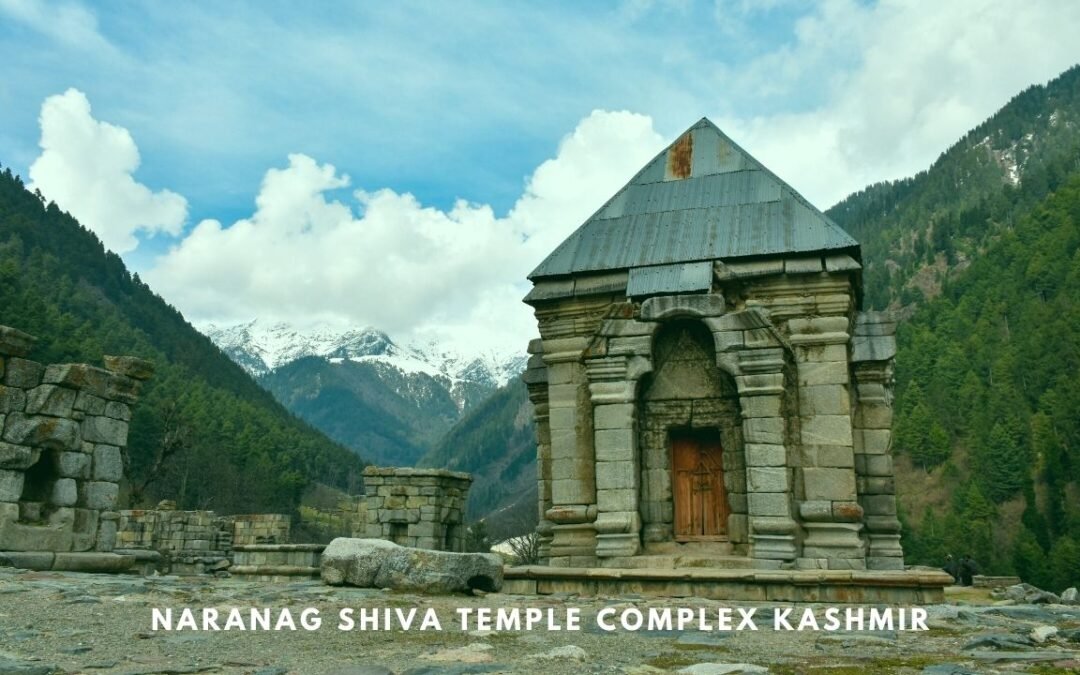
NARANAG TEMPLE COMPLEX – Ancient Shiva Temple of Kashmir
About this blog: Naranag, a picturesque hamlet in the Wangat Valley is known for its ancient Shiva Temple Complex, known as the Naranag Temple Complex. During our Kashmir trip we had the opportunity to visit Naranag and explore the ruins of the temple. Read this blog...

Chausath Yogini Temple Morena – Looking for the Esoteric in Mitawali
We have always been fascinated by esoteric aspects of religion, drawn to the mysticism of cultures and rituals. So it was not a surprise when I wanted to visit the Chausath Yogini Temple Morena during our trip to Madhya Pradesh. Also known as the Ekattarso Mahadeva...
Varanasi to Sarnath Day Trip – The Ultimate Travel Guide
Sarnath is one of the major pilgrimages for the Buddhists for this is the place where Lord Buddha gave his first sermon. Someone once told us that each and every stone of Sarnath is steeped in history. This spiritual destination near Varanasi was originally known as...
39 Comments
Wow.. Love reading about Hampi and the stories behind it… Hampi does look like an open museum with all the temples and incredible structures. Would love to see the panoramic view as well. It sounds magical!
Hampi is amazing. The history and natural beauty make it a great visit from Goa, Hyderabad and other places in South India. Thanks for sharing this article.
I visited Hampi in 2015 from Mumbai. It was just awesome. Thanks for posting. The world needs to know about this place.
Great. I hope you enjoyed
amazing photographs . I had visited this place 11 years back with family . Te area is radically changed over the years. Please inform me on my email whether you had used any kindly of photographic filter .
Thank you Arun. 11 years is a long time! 🙂 We had not used any filters for the photograph. The sky in itself was dramatic that day with clouds and everything!
Great travelogue, guys! Loved reading it!
Thank you Priyanka!
Very well described.. i recently visited this awesome place and it give very rich experience of backpacking travel..
Thank you so much! Glad that you liked it.
iam planning a trip to hampi this november. while searching about hampi i came to see ur post. it covered all the aspects of hampi a traveller wants to know with super narrations and awesome fotos. stay blessed
Thank you so much!
as i plan bangalore, Mysore Ooty, how do I connect Hampi?
You will get overnight buses from Bangalore to Hampi. Check the KSRTC website for online booking.
Thank You “AA”, the experience you share help a lot, I always love historical places, and found Hampi one of the best, as of its statue and other, I am sure to visit in nest year and going to share with you My experience, thank you again.
Thank you so much. Hope you enjoy Hampi and do let us know how your trip went.
Beautifully written 🙂
Wonderful read. Thanks for sharing your experiences. I would be going there in a couple of days time and this was really helpful.
thank you for such beautiful write up and mentioning each information in detail. it will be helpful for travel lovers around the world.
Thank you so much. Glad that you liked it.
I love nature especially I like adventure places. Therefore, mostly I travel towards different places. In this way, I spend my most time near to nature.
Just read your blog and You covered a great deal of points there. Impressive! Just visited Hampi and posted my video vlog of the place. I’d be glad if you check it out!
Thanks Sam. Your video is equally great!
Thanks for the share of the post and content
How many days does it take to cover Hampi ? How about Badami ?
Would end Feb be a good time to visit Hampi/badami ?
2-3 days are good enough for Hampi. We had spent 2 days there. Badami also requires one full day. February is definitely a good time.
Fantastic Travel Guide. I appreciate your blog site..keep going with it.
Wow! What a great and awesome blog.I am truly grateful for you providing us more information.
Hi thanks for the info. Would u know any professional guide who would explain in more details.
Thank you Abhimanyu! We do not know of any professional guides at Hampi, but I am sure you will find them there.
Thanks for this Information
Will covering all these spots in Hampi & around be physically strenuous?
Covering all the spots in a single day will be a bit strenuous. You can hire a scooty or bike to move around. Or you can also take an auto to move from one place to another.
Interesting Blog. I am planning to go with all senior citizen. Are there climbing up on hills or is it simply walking. Do we get rental cars?
Hello Rashmi, thanks for stopping by our blog. Most of the attractions can be done by simply walking. There are a few points where you have to climb. It is advisable to hire an auto rickshaw or e-rickshaw for going from one point to another. Have a wonderful trip.
Well written!!!
Submit a Comment Cancel reply
Your email address will not be published. Required fields are marked *
Save my name, email, and website in this browser for the next time I comment.
Submit Comment
This site uses Akismet to reduce spam. Learn how your comment data is processed .

Hampi in 2 Days – Itinerary
Disclosure: This post may contain affiliate links. I earn from any qualifying purchases, at no additional cost to you.
This post is a Hampi Travel Guide that contains a detailed Hampi 2-day Itinerary.
Hampi, a temple town in Karnataka is a UNESCO world heritage site situated on the banks of the Tungabhadra river. Once the capital of the Vijayanagara Empire in the 14th century, Hampi was known to be a wealthy, prosperous and monumental city. Not only was Hampi the world's second-largest medieval-era city after Beijing, it was also India's richest city at the time. The grandeur of the ancient city is still prevalent in the majestic temples and the striking ruins, perched across a craggy landscape surrounded by lush banana plantations. I had read about and seen countless pictures of Hampi. I kept planning a trip and it kept getting delayed due to some reason or another. My family has a tradition of taking a road trip every January. Guess which place I suggested for our trip!
As the ruins of the Vijayanagara Empire are spread over an area of 26 sq. km in and around Hampi, there are 2 options to explore them. If you have limited time then you can cover the more popular/ mainstream sites in 1 day. Whereas, if you wish to soak in the royalty and enjoy the architecture, then a 2 day trip to Hampi is the better option. Keeping both scenarios in mind, I have written about a 2-day itinerary for Hampi. Furthermore, I will be mentioning the sites which can be skipped so that you can squeeze in the important sites in one day. In case you want to see more pictures of Hampi and other destinations, then visit my Instagram profile (@thespicyjourney) .
Table of Contents
How to Reach Hampi
Nearest train station is Hospet junction which is 13 km from Hampi. Hospet is connected to Bangalore, Chennai, Goa, Hyderabed, Hubli, Mysore, Kolkata, Vijayawada, Tirupati, Ajmer, Jodhpur and Kolhapur.
Hampi is well-connected by regular buses to and from Bangalore, Goa, Karwar and Hubli.
A road trip to Hampi from Goa or from other cities makes for a viable option.
Save this for later!

How Many Days to Spend in Hampi?
In all honesty, Hampi is a place to visit on a weekend which is why I've created a blog post for the perfect Hampi itinerary for 2 days. However, if you don't have much time or are just passing by Hampi then you can even cover all the places to visit in Hampi in 1 day itself. On the other hand, if you're backpacking and wish to chill out for a while, then you can end up staying here for much longer, probably around 5-10 days even. So the choice is all yours - you can cover everything in two days or according to your schedule - there are no rules here.
HAMPI ITINERARY - DAY 1
1. Virupaksha Temple

Dedicated to Lord Shiva, the Virupaksha or Pampapathi temple is the main center of pilgrimage in Hampi. Having been around since the 7th century, the temple started out as a little shrine which was later developed into a vast complex under the Vijayanagara rule. The temple consists of a shrine, a hall with innumerable pillars, three antechambers, courtyards, gateways and a few smaller shrines. The temple has three towers. The nine-tiered eastern tower rises 50 meters and dates back to the first half of the 15th century. Moreover, this tower has been built such that an inverted shadow of the tower falls on the western wall of the temple through a small hole. Ancient India was well-aware of the concept of the pinhole camera! While the northern gopuram has five storeys, the inner eastern gopuram is three storeys high. The temple attracts huge crowds in the month of December for the marriage festivities of Virupaksha and Pampa.
2. Hampi Bazaar
Once a thriving marketplace during the Vijayanagara rule, Hampi Bazaar was a well-planned market area. Located in from of the Virupaksha temple, the bazaar stretches for over 1 kilometer. While in the ancient times, merchants from foreign lands used to sell precious stones, jewelry, silk clothes, today the market still lives on, although it isn't as alluring. The current market has shopkeepers selling handmade jewelry, wall art, embroidered shawls, bags, stone figurines and the likes. Unfortunately, the market was closed down recently so anybody visiting Hampi henceforth can only look at the pavilions and imagine what the market used to look like.
Must Read: Pondicherry Itinerary: Places to Visit in Pondicherry in 2 Days
3. Archaeological Museum
The Archaeological Museum, located 350m from Sri Virupaksha Temple, houses sculptures and antiques from different periods. The museum is in 4 sections.
The first section contains two scaled models of the Hampi topography along with monuments and temples located on it. This gives visitors an idea of the relative locations of the sites. the models also display the hills and rivers in Hampi.
The second section contains a large collection of sculptures and idols collected from the Hampi ruins. Most of these artifacts belong to Shiva worship and Veerabhadra cult.
The third section of the museum contains a collection of arms, coinage, tools, metal objects and other artifacts that were popular during the reign of the Vijayanagara Empire. A noteworthy exhibit in this section are documents made of brass and bundled together as a book using a ring.
In the fourth section you will find several antiquities that date back to the pre-historic and proto-historic eras. These objects are the oldest of all exhibits in the museum.
4. Vijaya Vittala Temple

No Hampi itinerary is complete without a visit to this structure! The most popular and the grandest of all structures in Hampi, the Vittala Temple is dedicated to Vittala, an aspect of Lord Vishnu. The sprawling campus features iconic structures such as the main temple, a stone chariot, pillared pavilions, halls and gateway towers. The temple, built in the Dravidian style of architecture, exemplifies the immense creativity and architectural magnificence possessed by the sculptors and artisans of the Vijayanagara empire.
The front of the temple houses a memorable intricately sculpted stone chariot. The chariot is a shrine dedicated to the eagle God, Garuda . Another interesting structure is the maha mandapam , which has the most fascinating and famous part of the temple—the musical pillars. Carved out of a single rock, each of the massive pillars emits a different musical tone. The British, curious to discover the secrets of the musical pillars, cut two of them open. However, they were unable to find any device inside the pillars. The two pillars along with the others are still present for visitors to admire.
An extravagant architectural masterpiece, the Vijaya Vittala temple is the most visited and the most photographed site in Hampi. This place just cannot be missed. It's one of the most spectacular sight in Central and Southern India .
5. Saasivekalu Ganesha Temple

A huge statue of Lord Ganesha, carved out of a single rock is the main attraction of the Saasivekalu Ganesha Temple. The enormous statue rises to a height of 8 feet. This idol is seated in a large open mandapa (hall) surrounded by an open pavilion. If you observe carefully, you will find inscriptions on the pillars made by traders from Andhra Pradesh. These inscriptions are as old as 1200 AD and say that this status was build in memory of King Narasimha the Second of the Vijayanagara Empire. This temple is situated just 700 m away from Virupaksha Temple.
Must Read: Trekking the 5 Gokarna Beaches
6. Hemakuta Hill Temple Complex

The Hamekuta Hill Temple Complex is without a doubt, my favorite spot in Hampi. The cluster of ancient temples, archways and pavilions is situated just 200 m from the Saasivekalu Ganesha Temple. Some of these temples dates back to 9 th to 14 th century and thus belonging to the era before the Vijayanagara Empire was founded. This hill is one of the best places to watch the sun go down. Besides, this hill is much easier to climb than the nearby Matanga hill.
Legend has it that Lord Shiva did penance before marrying a local girl, Pampa. Shiva was impressed by her dedication for him and thus consented to marry her. On this day it rained gold on this hill. Hema in Sanskrit language means gold. The name of the hill thus connects with this legend. Hence a number of temples in this area are dedicated to Lord Shiva, the major one being the Virupaksha Temple at the north of this hill.
Get here at least an hour and half before sunset. The place will be empty for you to click photographs. As sunset gets closer, the place will be swarming with tourists.
HAMPI ITINERARY - DAY 2
1. Queens’ Bath

Start your second day at Hampi with a visit to Queens' Bath. The ornate structure, spread across 30 sq. m has a large sunken open-sky bath in the center. The rectangular bath is surrounded by a big verandah , extended balconies and carved domes. The balconies are decorated with tiny windows and supported by lotus bud tipped brackets. The ancient unassuming building is an epitome of the luxurious life of the royal families.
The bath, although it's named as Queens' bath, was used by both Kings and Queens. In fact, it served as a royal pleasure house. From here, you can move on to the Royal Enclosure and the Zenana Enclosure.
Must Read: Places to Visit in Goa in 3 Days
2. Dasara Dibba
Also known as the Mahanavami Dibba, the Dasara Dibba is an itricately carved stone platform located 650 m from the Queen's Bath. It was build by the King Krishnadevaraya after his conquest over the kingdom of Udayagiri, present day Orissa. The platform is about 12 m in height and played a prominent role during the Navaratri celebrations. The King used to sit atop this platform and watch the celebrations in the form of march pasts, sword fighting wrestling and royal processions. This is the first stop inside the Royal Enclosure.
3. Stepped Tank

Stepped Tank of Hampi or Pushkarni is located just 190 m from Dasara Dibba. A pushkarni is a sacred water tank that is usually attached to a temple. This tank is located inside the Royal Enclosure and is said to be used by the royals during religious ceremonies such as rituals, cleansing and during rites of concretion. The ornate tank is constructed out of finely finished blocks of black stones and displays architectural beauty. The mason marks on the individual blocks of stones mark the direction of flow of water. This tank is a sight to behold and cannot be missed when in Hampi !
4. Hazara Rama Temple

Beyond the stepped tanks, 700 m away lies the resplendent Hazara Rama Temple. The small yet elaborately carved temple is dedicated to Lord Rama. It was once the private temple of the kings and the royal family of Vijayanagara. The relationship between the temple and the royal family is depicted in the reliefs covering the outer surface of the compound walls. They portray pictures of elephants, horses with attendants, military contingents and dancing ladies.
The most stirring feature of the temple is that the walls of the temple carry the entire story of Ramayana carved on stone.
5. Lotus Mahal

The Lotus Mahal, at a distance of 500 m from the Hazara Rama Temple is located inside the Zenana Enclosure. This enclosure was the residential area of the queens. Only lady guards and maids were allowed inside this area. The Lotus Mahal is named such due to the top view of the structure, which resembles a lotus flower. The picturesque palace is a two-storeyed building which is a fine example of Indo-Islamic architecture. The palace is surrounded by trees and a grassy area, making it a scenic site.
Must Read: A Complete Guide to Kodaikanal
6. Elephant Stables

A stone's throw away from Lotus Mahal lies the Elephant Stable. This impressive long building with a row of domed chambers was used to ‘park’ the royal elephants of the grand Vijayanagara Empire. The whole building looks symmetric with respect to a central hall. The tower of the central hall resembles that of a temple shrine. However, the domes to either side of the central dome are alternately of Islamic and Buddhist style. All the chambers have high ceilings and have a small opening at the rear from where the mahouts could enter and exit. There is a central hook embedded in the ceiling of the central dome which was most likely used to hook the elephants. Also noteworthy is a hidden staircase which is used to reach to roof of the building. The guards' barracks are located next to the elephant stables.
7. Malyavantha Raghunatha Temple
https://www.instagram.com/p/BesVSVchDXV/
Approximately 4 km from Zenana Enclosure and 4.5 km from Vijaya Vittala temple lies the Malyavantha Raghunatha Temple. According to mythology, Rama and Lakshmana were looking for a shelter during the monsoon season. Rama aimed an arrow in the Malyavanta hill direction. Hence, Rama and Lakshmana stayed here till the monsoon rains are over, before they marched to Lanka along with the army of vanaras . The temple complex is typical of any temple in Hampi. Further along the temple, an archway leads towards a cliff of boulders from where you get a panoramic view of Hampi's open fields. This spot is perfect for taking pictures and idly enjoying the sunset.

1 Day Hampi Itinerary
If you have just 1 day in Hampi, visit only the following Hampi attractions:
- Virupaksha Temple
- Vijaya Vittala Temple
- Queens' Bath
- Dasara Dibba
- Stepped Tank
- Hazara Rama Temple
- Lotus Mahal
- Elephant Stables
- Saasivekalu Ganesha Temple
- Hemakuta Hill Temple Complex
If you have some time to spare, visit the Malyavantha Raghunatha Temple. All of these are doable in one day if you start your day early.
Restaurants in Hampi - Where to Eat

Hampi has some of the finest restaurants and cafes serving scrumptious food. My favourite one is Mango Tree , shown in the picture above. The restaurant is quite popular among the foreign crowd and there's never a time when the place is empty. They serve individual meals, which I think is great. Other popular restaurants in Hampi are Gowthami Guest House , German Bakery , Laughing Buddha and Ganesh Chillout . You'll find a good mixture of Israeli, South Indian and continental cuisine in most places.
Must Read: Top Places to Visit in Fort Kochi and Mattancherry
Where to Stay in Hampi - Hotels in Hampi
Being a popular destination, there's no shortage of hotels in Hampi. Most people choose to stay in Hospete, a tiny city on the outskirts of Hampi.
Find Hotels in Hampi onBooking.com
Did You Enjoy Reading this Hampi Itinerary?
If you liked reading this Hampi itinerary for 2 days and the additional Hampi 1 day itinerary that I’ve put together based just for you then follow me on my social media handles Instagram , Facebook , Pinterest , Twitter to receive quick updates and be the first one to know when I release a new blog post!
31 Comments
Been there some years back, but surely a place I would look to visit again. Did you do the throw the coin in the water-body thingy? you ought to have visited the sloth bear sanctuary too. They look cute as teddy bears. Just a bit outside Hampi.
This place is amazing, I want to go back to India right now! Indian temples are so beautiful and I love the stories and legends behind them, like that of the Malyavantha Raghunatha temple.
I’m a massive fan of the Indian mythology too! Do come back to India soon to explore some temples 🙂
I’ve never heard of Hampi but I love your photos of it. Two days seems like the perfect amount of time to spend there. I have always like statues of Ganesha, so I think that would be the sight I’d most want to see.
Thank you Stella. Yes, 2 days was just about right for Hampi 🙂
What an amazing blog! I was in Hampi just a few months ago.. i could literally relive my memories through your blog! Loved it.. ?
Thanks Kanika. Happy to refresh your memory !!
Oh man, my list of places to see in India only gets longer. Hampi looks incredible with all the temples to explore. And that stepped tank is something to marvel at.
Haha India has a never-ending list of monuments, temples, forts and what not. The stepped tank is indeed a marvel and a unique identifier of India.
Loving your dress. These are beautiful architectures. Makes me want to visit India more.
Thank you !! Do try to visit India as soon as you can 🙂
I was in Hampi last November and it was my second time! I can definitely not get enough of that place. One thing is true indeed -you need atleast a week to see it well!
Oh yes!! I wouldn’t mind spending a week there!
Your article reminded me about my journey to hampi few years ago. And I spent there exactly two days. I wish I know your blog back then that would be very helpful information.
I’m glad you liked my blog 🙂 I hope I can inspire more people to refer to my guides and take trips !!
Oh, Hampi! It is such a wonderful place. I had been there last October and it was an amazing trip. I went on a nostalgic trip reading your post. But yes, you need a lot more time to explore and understand Hampi. Loved the post!
Thank you Amrita!! I’m glad you were able to refresh your memory through my blog 🙂
Hampi is on my India’s must-visit places to explore given credit to its history. I have known a little bit about the Vijaya Vittala Temple, but the rocks of the pillars emits music, that must be something to experience. I would love to see the Queen’s bath, its grandeur is imminent.
The musical pillars were out of a fairy tale! It’s forbidden to play music on the pillars now but some guides do it anyways. I’m guilty of listening to it but it was a great experience!!
This looks like such a cool place! I want to visit Hampi and this looks like a really detailed guide. Thanks for sharing!
Pingback: How to Spend 2 Days in Gokarna - The Spicy Journey
Pingback: Things to do in Pondicherry - The Spicy Journey
Hellow my name is Martinpeado. Wery good post! Thx 🙂
Pingback: Gokarna Beach Trek - Hiking to the Gokarna Beaches - The Spicy Journey
Pingback: The Most Instagrammable Spots in Goa - The Spicy Journey
Hey! I’ve always wanted to visit Hampi. I have visited North India but not the South yet! I’m looking to go back next year and have found this itinerary really helpful! Thankyou so much! Hampi looks a beautiful place. Was it peaceful? Out of curious did you not get temple fatigue seeing that many in one day?
Love Alex xxx
Hey Alex! South India is beautiful and I’m glad you’ll be making your way here soon. I, personally, did not get temple fatigue in Hampi because each of them is quite unique. If you notice all the points of interests mentioned in my post, each location has it’s own backstory, which was quite intriguing. That being said, Hampi is turning into a hippie paradise and you can easily stay here a few days to relax.
Pingback: 1 Day Bangalore Itinerary - How to Spend 24 hours in Bangalore - The Spicy Journey
Can you suggest good hotels around Hampi with good food and hygiene taken care off
For mythology lovers, there’s more in Hampi. There is Anjaneya Parvat, believed to be birth place of Lord Hanuman, the monkey god of epic, Ramayan fame, atop a hill with 575 steps. It also gives a 360° panaromic view of the area. Also there is Kishkindha, the abode of Bali & Sugreev as also the cave in which Bali fought a demon. One can also visit Pampa Sarovar, one of the 5 sacred sarovar of hindus, besides which is the place where Sabri fed Ram & Laxman with plumbs and guided them to seek help of Bali to search Sita, called Savari Ashram.
Hi, Your blog served as a reference for me to visit hampi over the weekend on a solo trip. Created a list of places from your blog and visited all of them. Thanks for writing 🙂
Comments are closed.

THE ULTIMATE HAMPI ITINERARY & TRAVEL GUIDE
- July 4, 2023
If you are planning a trip to Hampi and seek the perfect Hampi Itinerary & Guide, you have come to the right place. In this article, we will share all the information you need to have a truly awesome time. From all the best things to do in Hampi, where to stay, where to eat, and all of our top tips.
Hampi is without a doubt one of the most compelling places we’ve visited. Not only in India but throughout our travels. In contrast to the relentless fast pace of other Indian cities, Hampi is incredibly laidback. It is, therefore, a nice addition to your India itinerary if you need to catch your breath. This being said, there is an abundance of things to do in Hampi, that guarantees even the most intrepid traveller an awesome time.
We arrived in Hampi early in the morning after a bumpy bus ride from Goa. A blood-red sun was rising from the cryptic shadows of what turned out to be the ancient ruins of fallen Hampi. Immediately we felt as if we were in a scene from Indiana Jones. The towering piles of boulders and prehistoric landscapes screamed adventure. It was clear from the get-go that Hampi was going to be a special place.
… And a special place it turned out to be.
You see, Hampi is a significant place in India for a number of reasons. Not only is the city said to be the birthplace of Hanuman, the Hindu monkey god, it also served as capital to one of the most powerful empires in Indian history. We explain how it came to be the fallen kingdom it is today a little later on; However, the combination of religious and cultural history appears to have earned Hampi undeniable spiritual energy.
I know what you’re thinking. Does that mean that Hampi is bursting with hippie backpackers all lounging around smoking weed? Partly yes. It has in recent years become somewhat of a backpacker enclave; however, there is a specific area that this crowd stick to (more on this later)!
Need more Inspiration to visit Hampi? Check out our Hampi Photo Gallery to inspire your travels.
Anyhow, we have a lot to cover in this article. So let’s get to explaining why Hampi is one of our favourite places in all of India.

The Perfect Hampi Itinerary & Travel Guide
*Before You Travel to Hampi , have you got your travel insurance sorted? Cover yourself for the unexpected, read why you really need travel insurance , or get a quote from World Nomads .
*Have you got your travel Visa sorted? Check if you need one here and retrieve a quote. It’s simple, fast and reliable.
*Don’t leave home without any backpacker essentials with our free printable packing list.
How Long to Spend on a Hampi Itinerary
Many choose to spend 3-4 days in Hampi. And while it is certainly possible to cover most of the highlights during that time, we recommend spending a little longer.
The perfect Hampi itinerary consists of 3-4 days of exploring and 2-3 days of relaxation. It’s not often you get to experience somewhere as laidback as Hampi when backpacking India. Take advantage of the serenity while you can.
All things considered, 1 week would be an ideal amount of time to stay in Hampi.
Hampi Itinerary Highlights
For those who don’t have time to read through the entire itinerary, here are some of the highlights you can enjoy during your Hampi Itinerary.
- Explore the Fascinating Hampi Ruins
- Watch the sunrise on Matanga Hill
- Take a day trip to the other side of the river, Hippie Island
- Go for a dip in the local waterfall in Hampi
- Experience world-class bouldering

Top Things to do in Hampi
From exploring ancient ruins, taking part in bouldering, and visiting the secret waterfall – there is a ton of cool things to do in Hampi. Let’s look at some of our favourites!
1. Explore the Ruins
The city of Hampi is a labyrinth of ancient ruins, and exploring Tomb Raider style was our favourite thing to do during our visit. The remains of sacred temples, shrines and monuments stand proudly among unexplainable rock formations, creating a landscape that is almost other-worldly. For this reason, the ruins of Hampi are becoming an Instagram hot spot. (Don’t forget to follow us on Instagram here! )
Adorned with intricate carvings of Hindu gods & demons the forsaken ruins are a product of exquisite artistry. And it is quite remarkable to see how the remains have been spared from the unforgiving forces of nature.
Although exploring the ruins is one of the essential things to do in Hampi, it can also be an overwhelming task. There are approximately 1600 surviving ruins spread across an area of 16 square miles. The first question we asked upon arrival was ‘which are the most important to see’?
You can be sure that the local rickshaw drivers will make it sound a lot more complicated than it actually is. This is so they can charge you a premium for a guided tour. For this reason, we have put together a separate article detailing what the most important ruins to visit, where you can find them, and how you can get there.
Related Read – Top 10 must-see Hampi Ruins & Top 15 Instagram Spots of India

2. Watch the Sunrise on Mathanga Hill
Watching the sunrise & fall over the mystical landscapes was one of our favourite things to do in Hampi. We always envisioned Indian sunsets to be like a perfect ball of fire, transforming the sky into a cloak of red & orange flame. In Hampi, we were never disappointed.
Matanga Hill is formed from a mound of towering boulders. Being one of the highest points in Hampi, it is a popular lookout for sunrise and sunset. The base of Mathanga Hill is just a 10-minute walk from Hampi Bazaar, but d on’t make the same mistake we did and attempt to climb the boulders!
There is a carefully engineered stairway leads you to the peak in around 20-minutes. From the peak, expect to find awe-inspiring panoramic views over the lost kingdom of Hampi.
*Tip – Mathanga Hill is a popular spot for camping in Hampi.
Must read: Matanga Hill – The best sunset spot in Hampi!

MATHANGA HILL MAP LOCATION
3. Experience World-Class Bouldering
What was once an activity for experienced climbers, can now be enjoyed by all visitors seeking adventurous things to do in Hampi. Bouldering is a form of rock climbing, and with the Hampi landscapes littered in boulders, it’s the perfect place to do it. It seems to be popular on the far side of the river, where a number of tour operators advertise the activity.
If you are experienced or perhaps on a budget, it could be tempting to attempt this activity without a tour guide. We would strongly advise against this. The guides have all the necessary knowledge & equipment to help keep you safe. S hould you choose not to take this advice, at least be sure to follow these safety guidelines for bouldering in Hampi .

DON’T FORGET TRAVEL INSURANCE!
You will want to check your travel insurance policy to ensure you are covered for adventurous activities such as bouldering. World Nomads is great if you want to make any changes to your policy during your travels and offer add ons for such activities. Complete the form below to retrieve a quick quote.
4. Go For a Dip in the Waterfall
To cool down after a long day exploring, ask one of the locals to point you in the direction of the waterfall. Although it isn’t much of a waterfall, the journey to get there is quite the adventure. We felt like Lara Croft rock climbing, trekking through banana plantations, and crossing wild rapids!
When you get the near the waterfall, expect to be approached by a guide. Although it is possible to find the way yourself; we recommend you go with them as they will know the safest route. They don’t ask for much in terms of a tip, and it’s nice to give something back.
Once you get there, you can expect to find a nice spot for swimming as well as some pretty bold cliff jumps.
See full blog post: Chasing a Secret Waterfall in Hampi

5. Visit the Virupaksha Temple
The exquisite Virupaksha Temple towers over Hampi Bazaar, dominating the town with its captivating beauty. The original structure is said to date back as far as the 7th century and was dedicated to Lord Shiva, one of the principal deities of Hinduism.
Virupaksha remains the only place of worship still in use by the residents of mainland Hampi and attracts huge crowds of visitors every day. An essential addition to any Hampi Itinerary.

VIRUPAKSHA TEMPLE MAP LOCATION
6. Watch Lakshmi the Elephant Take a Bath
OK, we know this one is a controversial subject and we are by no means advocates for the use of wild animals to entertain. Nor do we believe in holding them in captivity. However, Lakshmi, the temple elephant plays a big part in the cities tradition and is one of the top Hampi attractions.
Lakshmi is the Temple Elephant of Virupaksha. Each day around 8 am, you can watch her taking a morning bath in the river. Lakshmi is quite the local celebrity and bathes in the river among the locals.
It was quite amusing to watch them having to swerve the ginormous poos she was depositing!
7. Camp Under the Stars
Although we didn’t have the necessary equipment to camp ourselves on this occasion, we learnt that camping is very popular in Hampi. Thanks to little light pollution in the area, you can expect a pretty epic view of the stars on a clear evening.
There are a number of spots in the city where it is possible to camp, such as the peak of Mathanga Hill or down by the river; however, some areas are privately owned so be sure to check with the locals before you pitch up.
8. Explore Hampi Bazaar by Bicycle
There are a fair number of attractions and ruins dotted around the area of Hampi Bazaar, and renting a bicycle for the day is a fun way to explore them all. You can rent bicycles all over town for 150 rupees per day.

9. Try a Bhang Lassi
If you are going to experiment with bhang in India, there is no better place for it than Hampi. There is something about the prehistoric landscapes combined with an air of mystical energy, that makes for a beautiful and spiritual experience.
Bhang Lassis are often easy to find in Hampi. Just look for ‘special Lassi’ on the menu, or don’t be afraid to ask around. If it’s your first time, you should read these 15 tips for experimenting with Bhang in India .
10. Explore The Other Side (aka Hippie Island) by Scooter
If you plan to spend most of your time on mainland Hampi, a day trip to the far side of the river known as Hippie Island, is an essential addition to your Hampi Itinerary. Here you can enjoy world-class bouldering, visit the birthplace of Hanuman the monkey god, or simply soak in the tranquil vibes.
One of the best things to do in Hampi is to disconnect from the world and immerse yourself in the beautiful nature. It’s not often you can escape the madness in India, so embrace this chance while you have it.
See Full Blog Post: Hippie Island, Hampi – A Reliable Guide

Hampi Itinerary – Where to Eat
For a small town, we were pleasantly surprised to find a number of nice restaurants in Hampi. Our favourite of them all, however, is Mango Tree . The appetisers are especially delicious, as well as the Indian Thali and Israeli meals. And as a finale, you would be doing yourself an injustice not to try the delectable banoffee pie!

How to Get to Hampi
By Air: The closest airport to Hampi is Hubli Airport situated 144km away.
By Train: The closest railway station to Hampi is Hospet Junction situated 10km away. Hospet is connected via train from across the region, however, booking trains in India can be tricky. It is advised to book at least 3 days in advance and even then you aren’t always guaranteed a ticket.
For this reason, we always used the bus network in India. You can book trains up to 6 months in advance using 12go Asia .
By Bus: Hampi is accessible by bus from a number of destinations across India. Although, most will drop you in Hospet, located 10km away. From Hospet you can take a local bus or pay for a rickshaw to take you to Hampi.
To check routes, timetables and ticket prices we recommend using Redbus . In our experience, they are extremely reliable. They are one of the few companies who will accept payment with an International card, and they are contactable by phone should you have any issues with your journey.
Hampi Itinerary – Where to Stay
Budget Private – Rashmitha Guesthouse – Conveniently located in Hampi Bazaar, Rashmitha Guesthouse is a great budget option in Hampi. While the rooms are basic, they come with all the necessary facilities for a comfortable stay.
Mid-Range – Heritage Resort Hampi – Boasting a swimming pool, spa, and wellness area, this place is amazing value for money. Perfect for that extra bit of comfort in Hampi.
Luxury – Evolve Back Hampi – We don’t often talk about luxury hotels on this blog, but this place looks phenomenal. If you have the budget, you won’t regret splurging on a night at this palace hotel.
For more places to stay in Hampi, you can check the latest prices here .
Alcohol, Drugs & Parties in Hampi
One of the reasons that Hampi remains a favourite among the backpacker crowd, is the illicit world of alcohol and drugs that exists here. Although it remains a taboo in the holy city, alcohol, weed & other psychedelics are readily available on this side of the river .
Alcohol is sold under the radar in many of the bars. And if you’re looking to participate in something stronger, you only have to discreetly ask around to find it. If you’re lucky, your stay might even coincide with a secret party under the stars!
*Warning – LSA seeds are a cheap & popular psychedelic available in Hampi. When taken in a large enough quantity they can produce similar effects to magic mushrooms & LSD; however, avoid taking with alcohol as they can make you violently ill – So I heard from a friend anyway!

Hampi Itinerary – Top Tips
Alcohol in hampi.
Buying alcohol in Hampi can be very expensive, however just 3kms out-of-town is a bar where you can buy anything from local beer to imported vodka at a reasonable price. Just ask any rickshaw driver and they will take you there & back for around 200 IDR.
It’s worth noting that there are no ATMs in Hampi. The closest is located 3km away in the town of Kamalapuram. Although, you will sometimes find it out of service or out of cash.
It’s worth carrying enough cash to see you through in Hampi. Which isn’t much, as everything is pretty cheap here.
Alternatively, you can withdraw money at one of the moneychangers in Hampi; however, be prepared to pay a 3% fee.
Wherever you go in India, it is important that you dress appropriately. It is recommended that female travellers respect the local tradition of covering shoulders and legs from the knee upwards. Not only is it respectful, but it will help to avoid unwanted attention.
The dress code for men is a little more relaxed; however, it is recommended to avoid revealing vests or tank top.
Be Aware of Scams
In all touristy areas there are travel scams you should be aware of so consequently, you can avoid them. There are also known to be skilled pick pockets operating in Hampi so be sure to keep your valuables secured at all time. We use either a small padlock or compartmental bag to keep our valuables safe when out exploring.
We recommend educating yourself on Travel Safety in India to help you avoid any sticky situations.

Best Time to Visit Hampi
The best time to visit Hampi is from October to February when the weather is dry and not too hot. We visited Hampi in October, and while there was some rain , most of the time it was clear and pleasant for sightseeing. Although midday until around 3 pm could get quite hot, it was just about bearable for us pale-skinned folk. It’s best to avoid Hampi during the months of Summer or Monsoon.
A Brief History of Hampi
Hampi is considered a sacred city since it is said to be the birthplace of Hanuman, the Hindu monkey-god. And up until the 1500s, Hampi was rich and prosperous, serving as the capital of the almighty Hindu Vijayanagara Empire. However, in 1565 the capital was abruptly bought to its knees, when the city was ambushed by a coalition of Muslim Kings, conquering the empire and leaving Hampi to perish.
Despite this basic understanding of how Hampi came to be the lost kingdom that it is today, there is an air of untold history that consumes the city. The unexplainable rock formations and skilfully carved ruins are sure to leave you with an abundance of unanswered questions. But it is these mysteries that give Hampi the charm that we fell hopelessly in love with.
Hampi Itinerary – What to Pack
Unsure of what you might need to pack for your adventures in Hampi? Don’t worry, we have got you covered. Check out our backpacker essentials, for a packing list of items that we carry with us on every adventure .
Here are some items that we recommend taking to make your visit to the lakes & waterfalls more comfortable:
- Comfortable shoes for the hike down
- Water shoes to wear in the water – We Recommend : 2 in 1 Water/Hiking Shoes .
- Waterproof Bag to protect valuables – We Recommend: Waterproof Dry Bag-10L/20L/30L
- Bathing suit & towel for the obvious – We Recommend: Microfiber Travel Towel
Travel Responsibly
As travellers, it should always be a top priority to travel responsibly. We already leave a substantial carbon footprint just by flying to our travel destinations, so that’s even more reason to make a positive impact when we get there.
There are many small steps you can take to becoming a responsible traveller, and we highly encourage you to educate yourself before travelling to Hampi. Here are some things you can do to minimise your footprint:
1. Do not leave any rubbish on the ground: You will see a lot of rubbish on the ground in India, but that doesn’t make it ok to add to it. Bin your trash!
2. Limit your single-use plastic consumption: This is tough in India as we wouldn’t recommend drinking tap water even if it has been treated/sterilised. However, you can say no to straws and plastic bags. Take a reusable bag with you everywhere.
3. Respect the local culture: Be courteous of the local culture and act in such a way that leaves a good impression. Learn a little of the local language (hello and thank you is the minimum), greet the locals in a polite manner, and respect dress codes & traditions. We recommend carrying a Sarong with you to cover up where needed
More on India
Are you planning a trip to India? Check out our other articles to help plan your trip.
- One month in India – Ultimate itinerary & guide
- The Best Rajasthan Itinerary for 5 Days or More
- 18 AMAZING PLACES TO VISIT IN UDAIPUR IN 2 DAYS
- TOP 5 BEACHES IN SOUTH GOA, INDIA
- 17 AWESOME THINGS TO DO IN THE SOUTH OF MUMBAI
- TOP 15 INSTAGRAM SPOTS OF INDIA
Did you enjoy our Ultimate Hampi Itinerary & Travel Guide ?
Well, that concludes Ultimate Hampi Itinerary & Travel Guide . We hope you enjoy your time in this magical country. If you have any questions or feel we have missed anything, please reach out to us in the comment section below, through our contact us page. Don’t forget to follow us on Instagram here where we share further travel advice & inspiration.
Stay adventurous and Happy travels.
Charlotte & Natalie x
Disclosure: Some of the links in this post are affiliate links. That means that if you purchase through these links, we will earn a small commission, at no extra cost to you. And we can continue bringing you free travel tips and advice. If you found the content helpful and are kind enough to use our affiliates – you are awesome, and we thank you!
MORE ON ASIA
TIPS, TRICKS AND ADVICE FOR PLANNING A TRIP TO THAILAND
HOW TO SPEND 3 WEEKS IN CAMBODIA – ITINERARY & GUIDE
TOP 15 INSTAGRAM SPOTS OF VIETNAM – ULTIMATE GUIDE
ANNAPURNA BASE CAMP PHOTO DIARY – NEPAL INSPO
The Best 10 Day Bali Itinerary
PIN IT FOR LATER

Sharing is caring ♥
Related Posts

6 Responses
This was pretty awesome. Impressive narration. Quite helpful, Thank you
Hello Diyush, we’re so pleased you enjoyed the guide, thank you for taking the time to leave this lovely comment
Nice pictures and good detailing. I also went to Hampi and it is a memorable and an awesome trip.
Thank you, we are glad you enjoyed it and enjoyed your time in Hampi!
Your explanation and itinerary of Hampi is excellent
Thank you for the compliment!
Leave a Reply Cancel reply
Your email address will not be published. Required fields are marked *
We’re Charlotte & Natalie, a British lesbian couple with a passion for travel and adventure.
Here you will find everything from lgbtq+ travel & lifestyle advice, to comprehensive guides and itineraries designed to make your travel planning easier., we want to inspire you to live the life of your dreams..

💌 Get discounts & updates in our monthly newsletter

Find Hotels Via Booking.com
Book Tours & Activities Via GetYourGuide
Get Travel Insurance Via Heymondo
Get discounts & updates in our monthly newsletter

Destinations
LGBTQ+ Lifestyle
Start A Blog
Teach English
Digital Nomad
Privacy Policy
Guest Posts
Work With Us

© 2022 Our Taste For Life Blog – All Rights Reserved. Website Designed by us via Fresh Creatives

A Complete Hampi Travel Guide 2021: Hampi Itinerary & Tips
Hampi is an incredible UNESCO World Heritage Site located by the Tungabhadra River in Karnataka, India. The ancient city’s boulder-strewn landscape delights the eye; lush paddy fields and serene lakes soothe the soul, and the timeless ruins with their impressive history and architecture amaze the mind.
Here is a Hampi travel guide with a solid itinerary to maximize your time, details of how to get there, places to stay in Hampi, how to get around and tips for your visit!
Before we start, let us tell you that the face of Hampi has changed in the last year. If you’ve read or seen any content on Hampi before landing on our Hampi travel blog, then note that Hippie Island and restaurants like Mango Tree in Hampi don’t exist anymore. Because of this, your Hampi itinerary could look a lot different from what you had initially planned. Luckily for you, this blog post is from our visit after these changes so you’ll get the most updated information.
Brief Hampi History
Hampi was the capital city of the mighty Hindu Vijayanagar Empire for over 200 years (around 1336 AD to 1565 AD) covering all of southern India south of the Tungabhadra river. The city was an important centre of trade since it controlled both cotton and spice trade routes of Southern India and traded gold, pearls, and other precious items by the kilo. The rulers fortified the kingdom and used their wealth to build an impressive city with beautiful palaces, temples, monolithic statues, markets streets, and monuments.
After the death of the empire’s greatest king, Kishnadevaraya (reigning period 1509-1529), the kingdom soon fell to the combined armies of the neighbouring Muslim rulers of the Deccan. The city was ravaged and plundered and now lies in ruins.
In around 1 CE (the era of the Ramayana) this area was called Kishkinda – the kingdom of monkeys. The Hindu God Hanuman was born in the area!
When to Visit Hampi
Hampi’s main tourist season is in winter from October to February. To avoid crowds, you can also visit in March (explore early morning and evening) and September (rains slow down and Hampi is very green). Know that in the rainy season, however, you will not be able to take a coracle ride in the Tungabhadra due to the strong current!
We have only travelled to Hampi in these off-season months and it turned out to be awesome. Lots of peace when exploring the ruins.
How to Reach Hampi
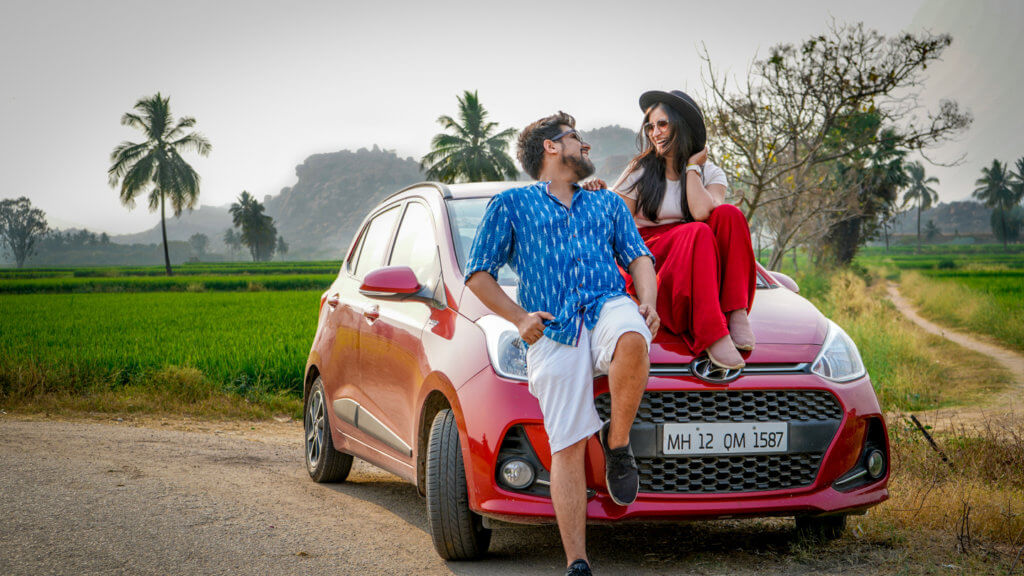
Flight: Toranagallu (11 km), Bellary (61 km) and Belgaum (191 km) are the nearest airports to Hampi. However, since flights are limited to these locations, it would be best to fly to Bangalore (351 km) and then take a bus or hire a car and drive for around 6 hours to Hampi. Book your flight here .
Car: Hampi is at a drivable distance from major cities like Bangalore (351 km or 6 hours), Hyderabad (385 km or 7.5 hours), and Panjim Goa (346 km or 8 hours). We love this method of transport and have always gone on a Hyderabad to Hampi road trip. The drive is a pleasurable one with vast fields and bouldered hills.
Bus: You can book an overnight bus to Hampi in all cities mentioned above like Bangalore, Hyderabad and Goa. You can book this on Redbus. If living in the neighbouring town of Hospet, you can catch a local KSRTC bus to Hampi which takes about half an hour.
Train: Hospet Railway Station, located about 12 km from Hampi is the nearest station. It is directly connected to major cities like Bangalore, Hyderabad, Goa, etc. From Hospet, you can take a local bus to Hampi which takes about half an hour.
Days Required to Explore Hampi
You need a total of at least three days to see the main sights of Hampi – Two days to explore the heritage area side and one to explore the other side of the river – Anegundi, Anjaneya Hill, etc.!
Four-five days is ideal for a slower, more comfortable, visit!
Places to Stay in Hampi
To make the most of your time in Hampi, it is best to stay at a distance of 0-10 km from Hampi – the closer the better! Know that Hampi isn’t a town in itself. Locals live in a small village called New Hampi but the location doesn’t have any hotels or accommodation. So, you will have to opt for the area near Hampi or at nearby villages.
We have stayed at below given (first two) Hampi resorts and hotels and highly recommend them in terms of location.
Clarks Inn – Located in Kamalapur Town 4.7 km from Hampi’s main attractions, it makes for an ideal place to stay. Small but well-appointed rooms with an in-house restaurant and a small pool! Perfect for those who’ll spend their days exploring and look for only basic comfort in their accommodation. We booked this for only Rs.2000 per night making it a super budget stay, but per our understanding prices are not so low during season time. Check prices and book property here .

Heritage Resort Hampi – Located 7 km from Hampi, this resort is a great mid-range option for families and couples looking for a relaxed and comfortable stay amongst nature. Large rooms, great food at the restaurants, happy hours, evening entertainment, amazing greenery (lots of mango trees) and a decent-sized swimming pool make this stay option one of the most ideal resorts in Hampi. Check prices and book this property here .

Evolve Back Hampi – For the ultimate luxury, opt for this Hampi resort located 9 km away. The architecture of the resort is inspired by that of the Vijayanagar Empire. You’ll feel like you’re staying in a palace. We haven’t stayed here but would love to someday! Check prices and book property her e .
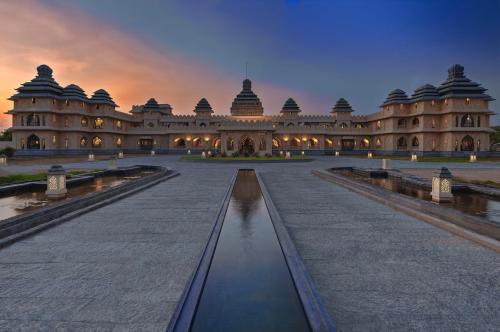
If you’re on a tight budget and don’t care much about worldly comforts, opt for a homestay. You’ll not only save money but also have an authentic local experience.
How to Get Around Hampi
Having your own set of wheels is super convenient. However, if you can’t do that, hire an auto-rickshaw for the day.
You can also opt to hire rickshaws to transport you from one location to the other but this might be more time consuming and you may not find rickshaws outside all points of interest especially if travelling out of season.
Earlier, scooters used to be available for rent, but now due to the demolition of the hippie area, we are not sure if it is possible. It would be best to enquire about scooter hire at your accommodation or ask guides in the Hampi area on Day 1.
Hampi Itinerary – 3 Days
Here is a 3-day Hampi itinerary that will help make the most of your time.
Day one’s itinerary has been written assuming you will be reaching by mid-day or morning, checking into your accommodation and stepping out only after lunch.
If you type Hampi on Google Maps, it takes you to the main Hampi area consisting of Virupaksha Temple and Hemakunta Hills. This is the area you should explore today to get a flavour of what Hampi is all about.
Park your car at the Virupaksha Temple parking or take an auto till there and start your walking adventure for the day. You won’t need a vehicle till after sunset to go back to your hotel.
Sri Virupaksha Temple
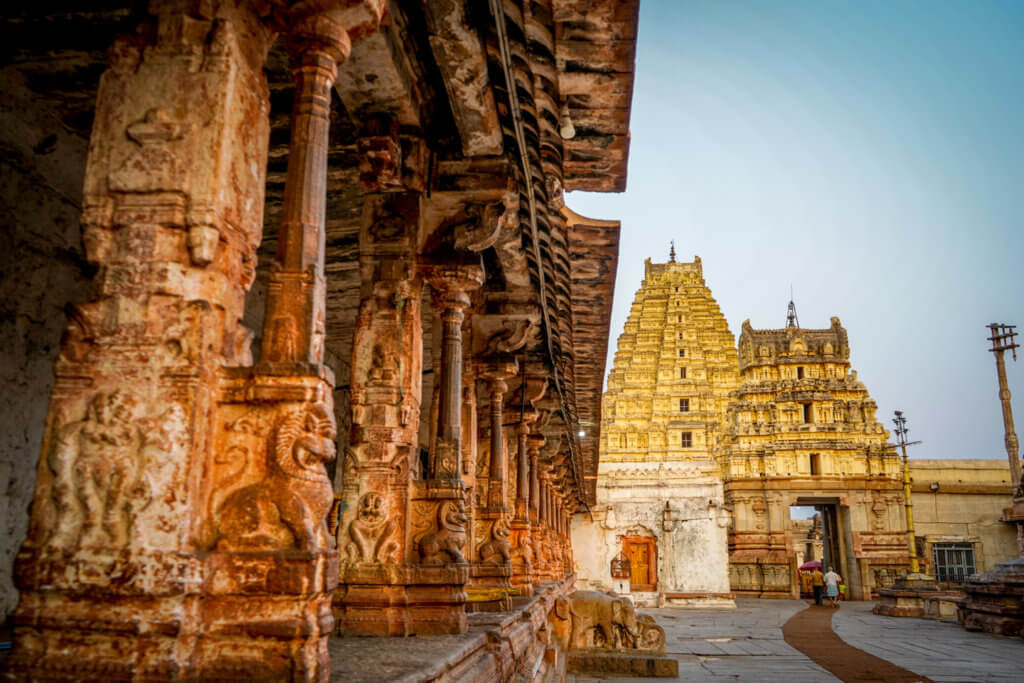
Dedicated to Virupaksha, an incarnation of Shiva, this is the most popular and probably the oldest temple in Hampi as it was built in the 7th century (most other sites were built in the 15th century). It is a must-visit for two reasons:
- It is the only working temple in main Hampi
- You get to meet and get blessings from an adorable elephant called Lakshmi.
As you approach the temple, you’ll be welcomed by a beautiful gold Gopuram. Leave your shoes on the left side of the entrance (Rs.2), buy your ticket (Rs. 25 per person), and hire a guide (Rs. 200). You’ll start at a serene courtyard, admire vegetable paintwork on the roof of the main temple, gape at a fascinating opening in the wall that works like a pinhole camera, see a charming kund, and various temples dedicated to other Hindu gods.
The visit should take about half to one hour.
Hemakuta Hills
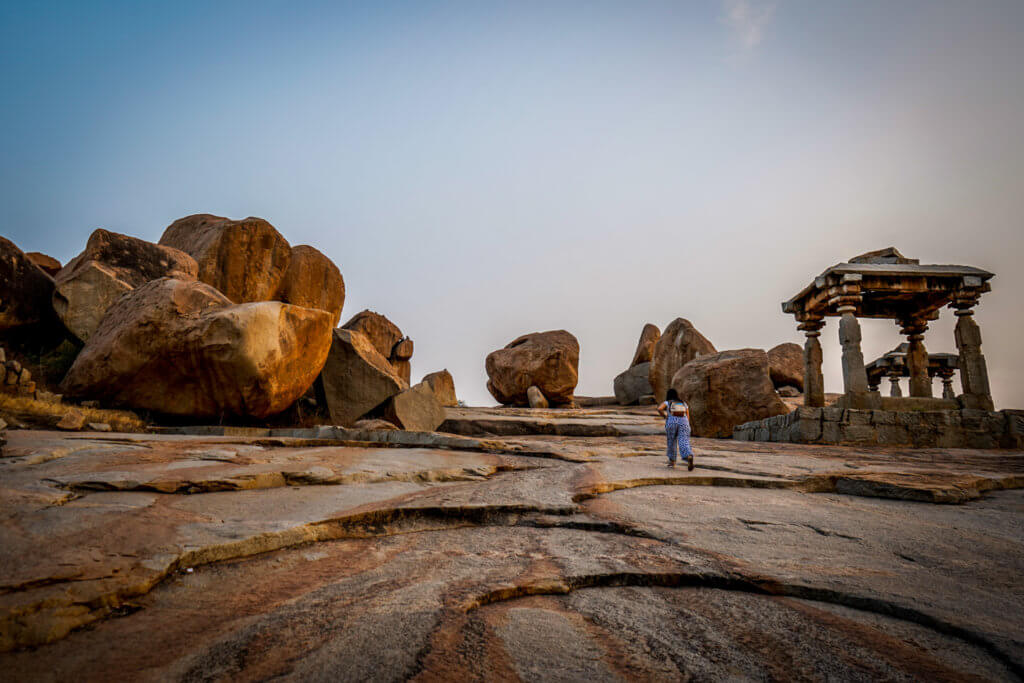
When we think about Hampi, the Hemakuta hills is what comes to mind. It is a hilltop (made of one huge rock) dotted with several temples and smaller boulders. While the most iconic place to visit here is the Moola Virupaksha Temple just a 3-min walk from Virupaksha Temple, we say don’t sweat it. Just climb the hill and explore on your own though we must mention we love the frangipani tree at the Hemakuta Hanuman temple. Watch the sunset sitting on one of the cliffside benches (google sunset point Hemkuta) or anywhere else that appeals.
Remember the sun doesn’t set at the horizon but much above it due to the haze in the area. Don’t miss the sunset thinking you have a lot of time. Also, as soon as the sun sets, get ready to leave. If you don’t, a police guard will usher you out.
Wondering why this is important? Well after sunset, bears and leopards freely roam the Hampi area. You wouldn’t want to serve yourself as dinner to these animals 😛
Vijaya Vitthala Temple
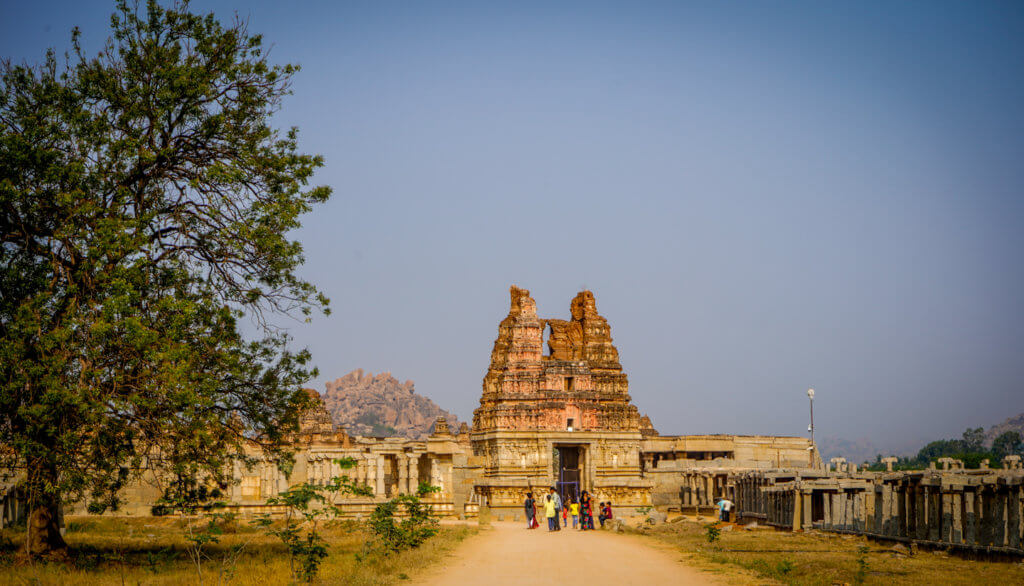
The Vithalla Temple is dedicated to Vittala, an incarnation of Lord Vishnu. It is the most popular, beautiful and fascinating structure in Hampi and attracts a significantly large crowd. Therefore, it is best visited first thing in the day.
The temple opens at 8:30 AM so ensure you’re at the parking by 8:15 AM. Since the temple complex is at a distance of about 1.3 km from the parking, you will have to choose between the two options for getting to the temple – a 15-minute walk or a golf cart ride for Rs. 10 per person. We recommend you walk to the temple visiting various sites on the way and take a golf cart when exiting to save time and energy for the rest of the day.
While walking to the temple’s entrance, you will see the Pushkarni (water tank), Guduregombe Mandapa (temple), and lastly structures that used to be a marketplace. At the entrance buy a ticket (Rs. 40 per person). Keep the ticket safely as it is used at some other sites you’ll be visiting today as well.
On entering the walled temple complex through the gopuram gate, you’ll immediately notice the stone chariot that is featured on India’s Rs. 50 notes. A marvel! Further, you’ll see the Nritya/Ranga mandapa (dance hall) that has musical pillars. When tapped, these pillars that are made of a single piece of resonant stone, make musical sounds. It’s an absolute wonder! This mandapa is shut for maintenance so you may be shown this phenomenon at another mandapa.
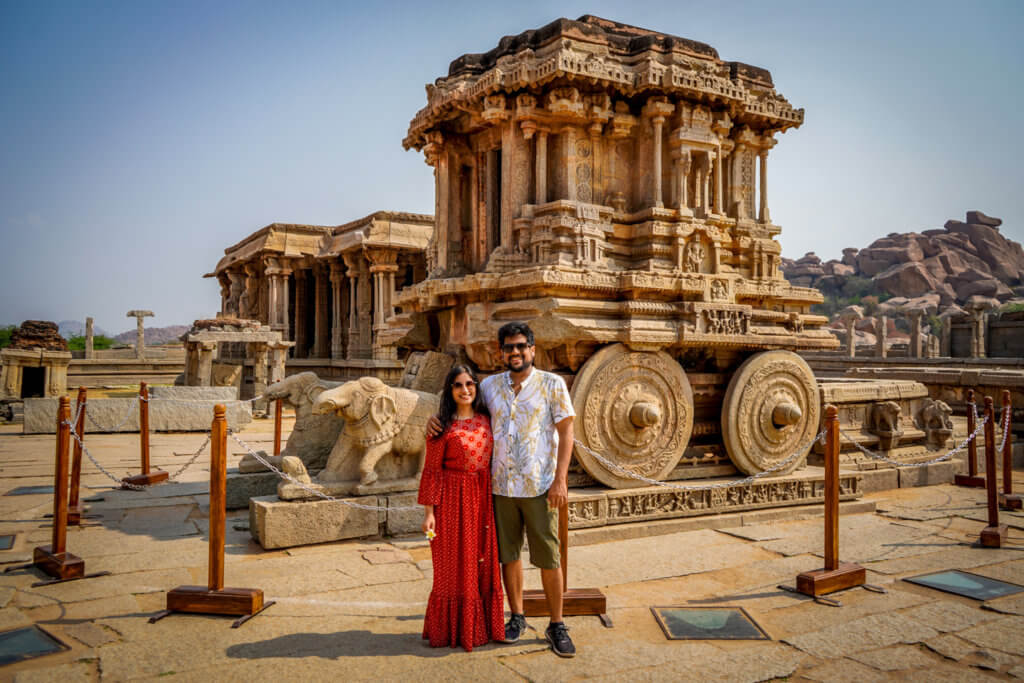
After your visit, check out the King’s balance nearby (300 metres) or head directly to the Queen’s Bath (in the Royal Centre) which is about 5 km from here.
The visit should take about 1-1.5 hours.
Royal Centre
Hampi is divided into two – the Royal Centre and the Sacred Centre. Today, for the first half of the day, you’ll be exploring buildings in the royal centre that houses the palaces, durbars, tanks, residences, and baths used by the royals of the empire. Start at Queen’s Bath the first building in the Royal Centre area.
Queen’s Bath
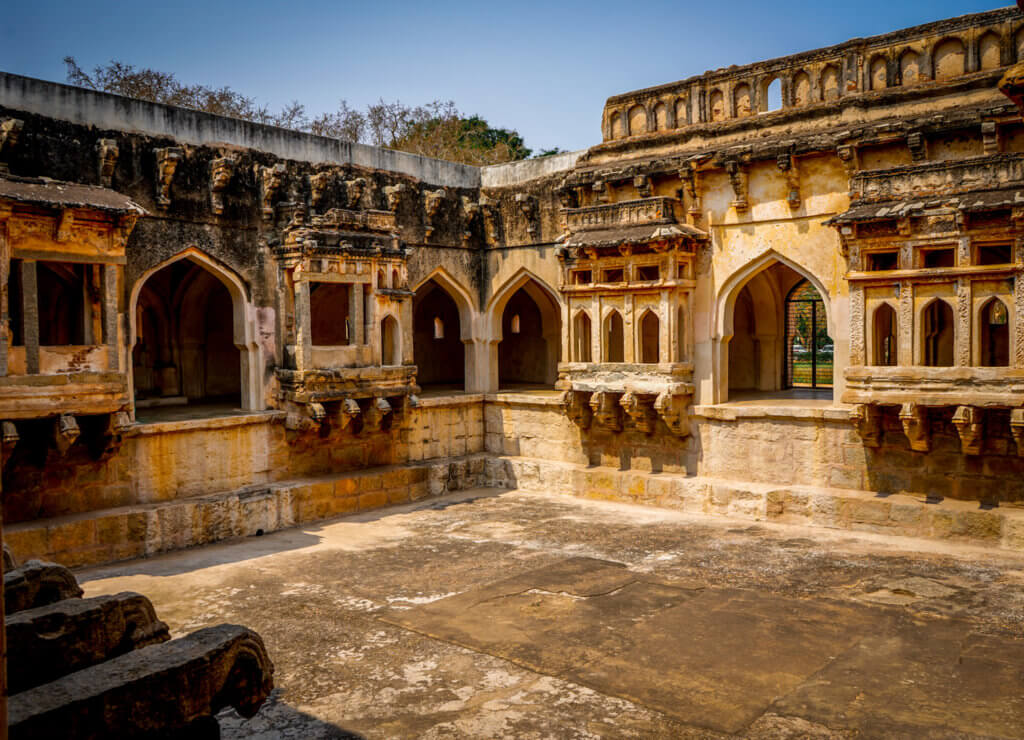
The Queen’s bath makes for a short and interesting visit. Constructed in Indo-Islamic style, the structure has a simple exterior and an ornate interior with a colossal sunken bath. Due to its distance from the royal enclosure, it is believed to be a pleasure complex. Arched corridors and ornate balconies are what makes this place worth the visit. An owl and owlets are often found inside the empty bath. An additional delight!
After exploring the bath for about 15-20 minutes, head to the Royal Enclosure located 550 metres from the Queen’s bath. Better to take your vehicle instead of walking it if you have one!
A guide is not necessarily required to explore this structure and as such, you won’t find any outside it.
Royal Enclosure
The royal enclosure was the seat of power of the Vijaynagara Empire. In its heydays, this 59000 square meter area housed 45 buildings including the great platform, durbar halls, tanks, and underground chambers.
The main places to see in the Royal Enclosure are:
Mahanavami Dibba (Great Platform) – This 3 tier 8-meter-high platform is the only structure in the enclosure that still stands as it did back then. The raised platform was used by the king to view the Navami/Dussehra celebrations. There are beautiful war carvings at the lower sidewall of the structure.
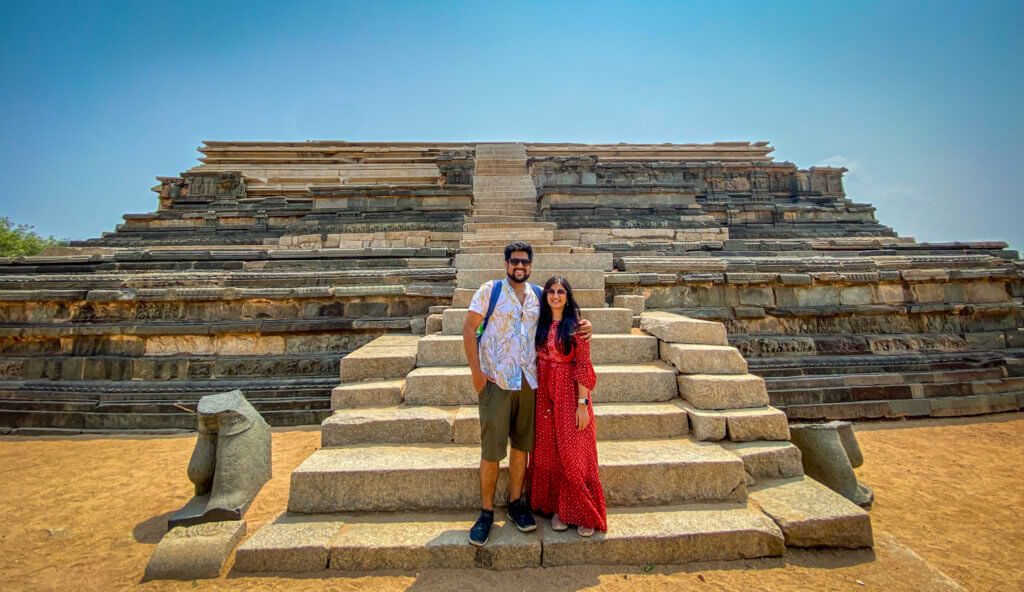
The Underground Chamber – This is where spies were held for questioning. It is constructed in a manner that left spies wondering where they are and was made soundproof with flowing water above.
The Stepped Tank – This is a 5-tiered super-symmetrical and aesthetic 7-metre deep tank that was used for ritual bathing before prayers by the royals. It is different from other tanks in Hampi as it is made of black schist stones to heat and purify the water.
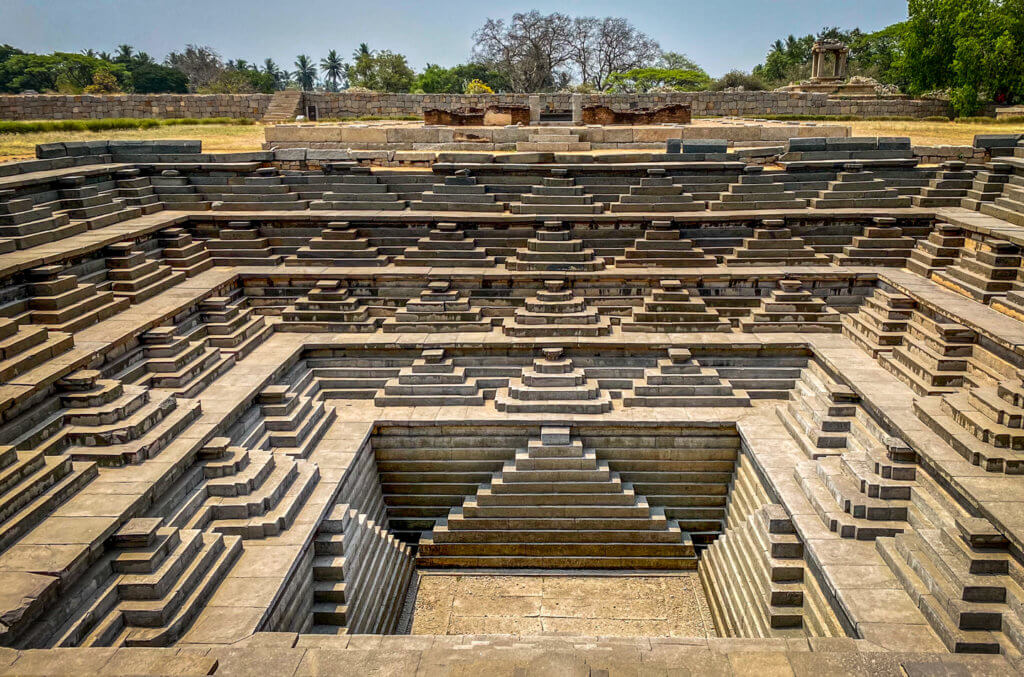
It’ll take you about 30-45 minutes to see the above three structures. Other structures in the enclosure are absolutely ruined so we did not see them. But if you wish you see them anyway then you’ll take about an hour!
Next, proceed to the Hazara Rama Temple located 280 metres from the Royal Enclosure.
Hazara Rama Temple
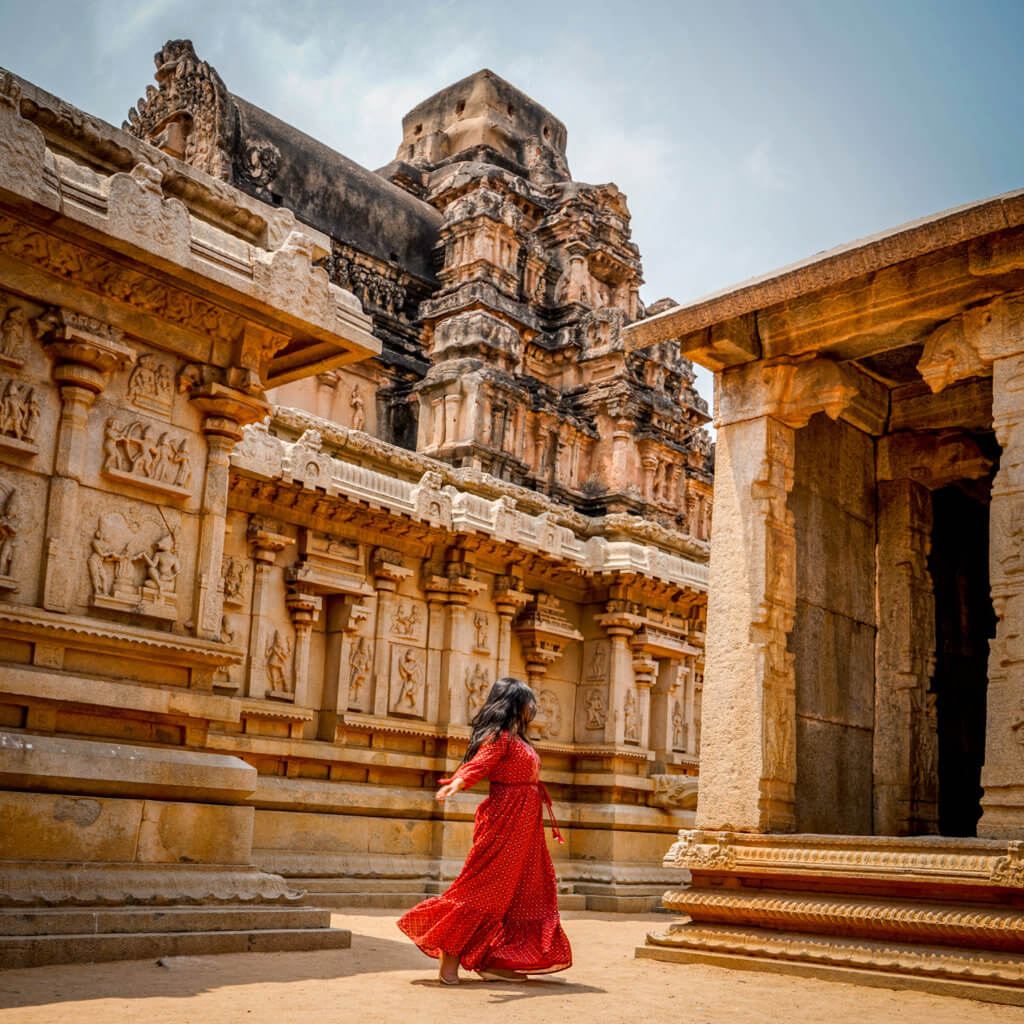
The Hazara Rama temple is a small but beautiful temple that was used only by the royal family. As the name suggests, it is dedicated to Vishnu in his aspects as Lord Rama. Since the geographical area is a part of the epic Ramayana, it isn’t tough to reason why there exists a temple entirely dedicated to showcasing Ramayana stories on its walls. The pictorial stories are almost like a comic strip carved along the exteriors of the main shrine. The temple also has black marble pillars that are unlike any other in the city.
The Hazara Rama Temple will take about 20-30 minutes to explore.
Zenana Enclosure
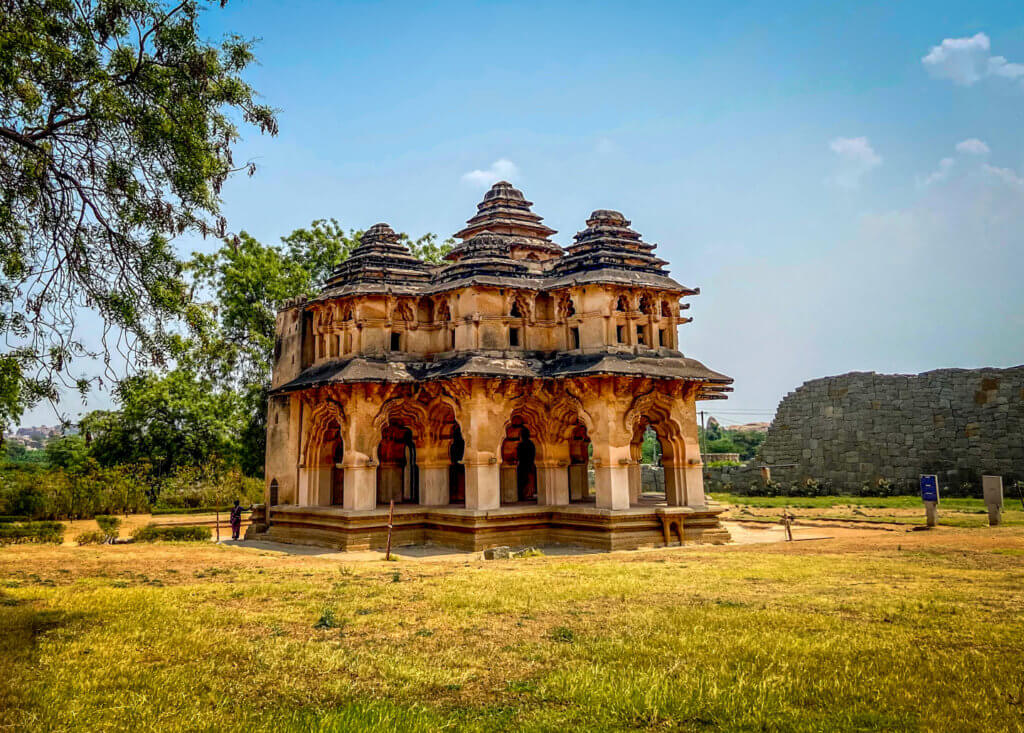
Now, proceed 500 meters along the dirt path to the Zenana Enclosure, a fortified and secluded area for the then royal ladies including the Queen. Per our guide, this structure was primarily used to house the royal women and protect them in times of war. The area was protected by eunuchs and the only man allowed inside was the king.
The main attraction here is the Lotus Mahal built in Indo-Islamic style. You aren’t allowed to step inside which doesn’t matter much as the beauty can be appreciated from outside itself!
You’ll take about 10 minutes here.
Elephant Stables
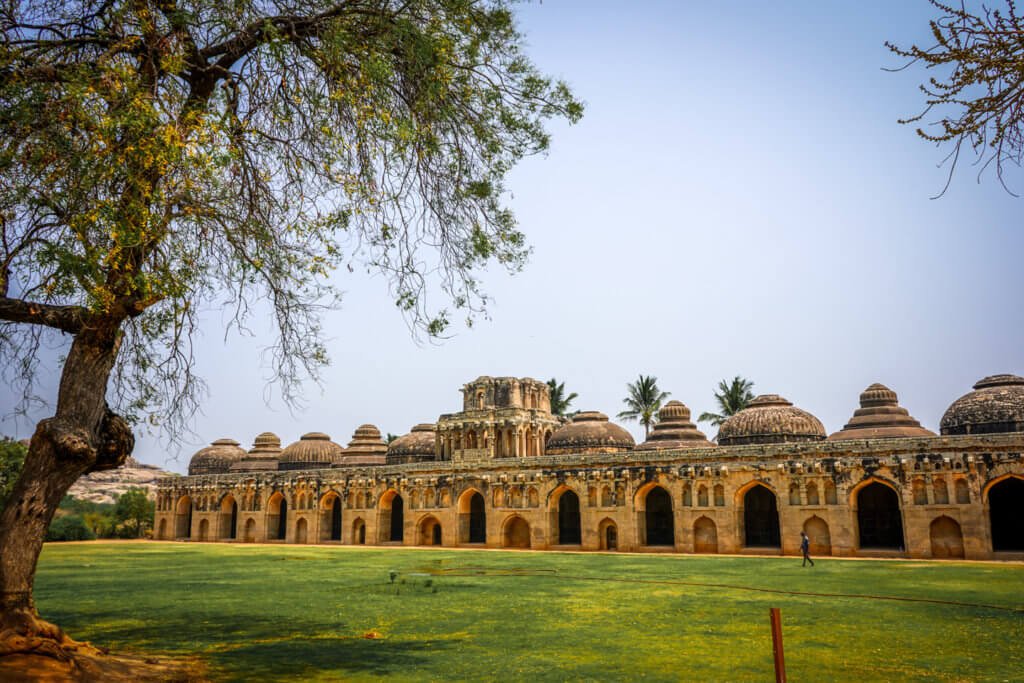
Just through a pathway from the enclosure, located right outside it, is the famed Elephant Stable. This structure used to provide shelter to the royal elephants, clearly showing their importance in the empire. The architecture has fluted arches topped with Jain, Hindu and Muslim style domes. The secular nature of this Hindu empire was something we appreciated a lot.
You can explore the stables and just sit in the garden and relax for a bit. It will take another 15-20 minutes to explore this area.
Lunch and Relaxation
It’ll be around lunchtime by now. So, head to your hotel, grab a bite and relax for a bit before heading back to explore.
Note that all the famous restaurants you must have heard of do not exist anymore so eating at your hotel restaurant is a good option. If you don’t want to head back to the hotel, ask a guide for information on where to eat.
Lakshmi Narasimha Temple
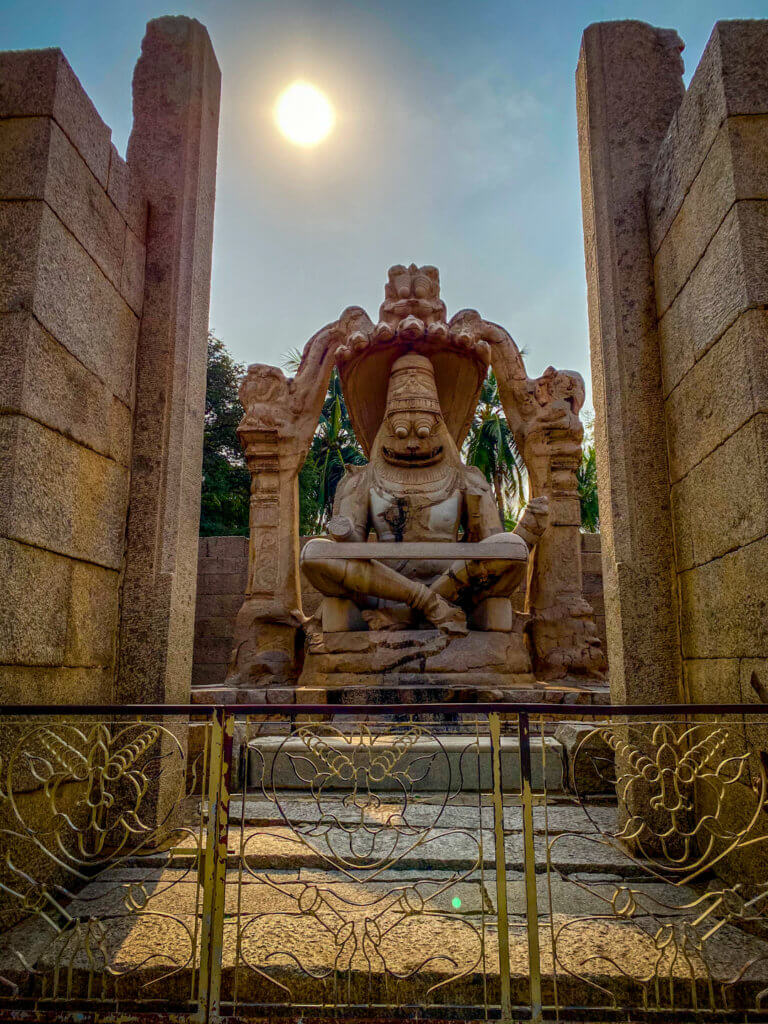
This temple is dedicated to Lord Narasimha, one of the ten avatars of Lord Vishnu, and Goddess Lakshmi as well who was his consort. It is the largest monolith statue in Hamp – an imposing sight! You’ll take about 5-10 minutes here.
Badavilinga Temple
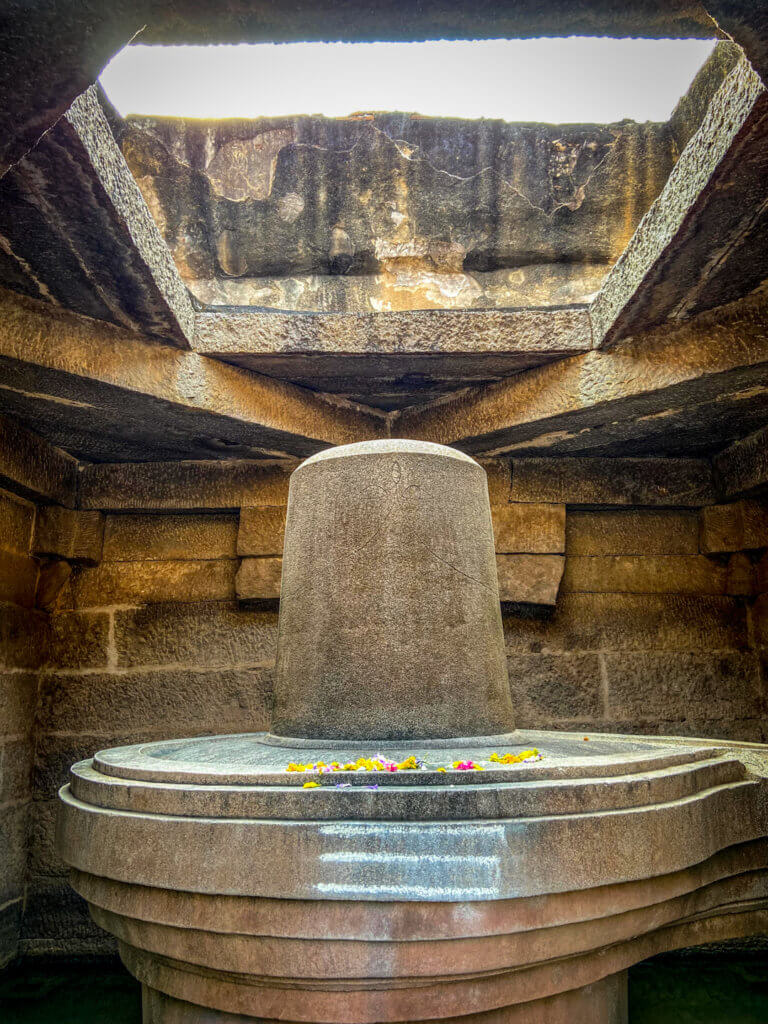
Located a few steps away from the Narasimha Statue is this giant shrine for Shiva. At 3 metres, it is the largest Linga in Hampi and is made of impressive black stone. Another 5-10 minutes are required to admire this structure.
Kadalekalu Ganesha
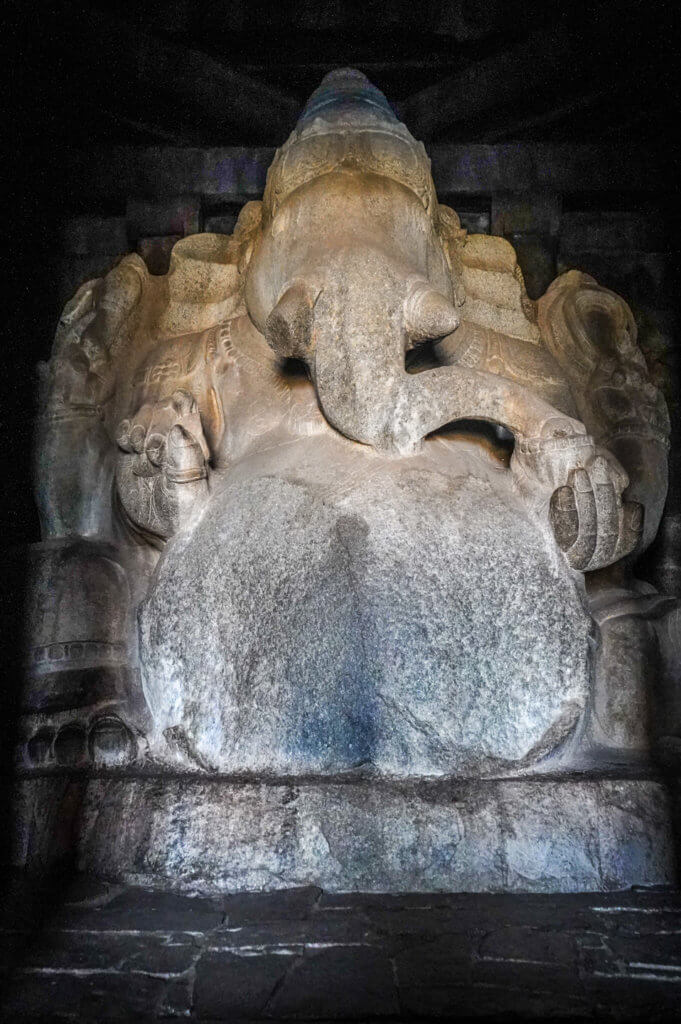
Next visit the Kadalekalu Ganesha, a 4.6-meter statue, the belly of which resembles a Bengal gram. The temple is a beautiful stone structure decorated with ornate tall granite pillars (that reminded me of Roman ruins for some reason). This Ganesha statue was worshipped by the royals.
This structure is located on Hemakuta hills 450 meters from the Narasimha statue. It will take about 10 minutes to visit.
If you’re a devout Ganesh follower or simply would like to see another Ganesh statue, then you can also visit the Sasivekalu Ganesha – a 2.4-metre high statue of Ganesha that has a snake wrapped around it (to prevent it from bursting due to over-eating per mythology). This Ganesha statue was built for the common people of the kingdom. It is located just 170 meters away from Kadalekalu so you can visit both statues with just 15 minutes to spare.
Coracle Ride on the Tungabhadra River
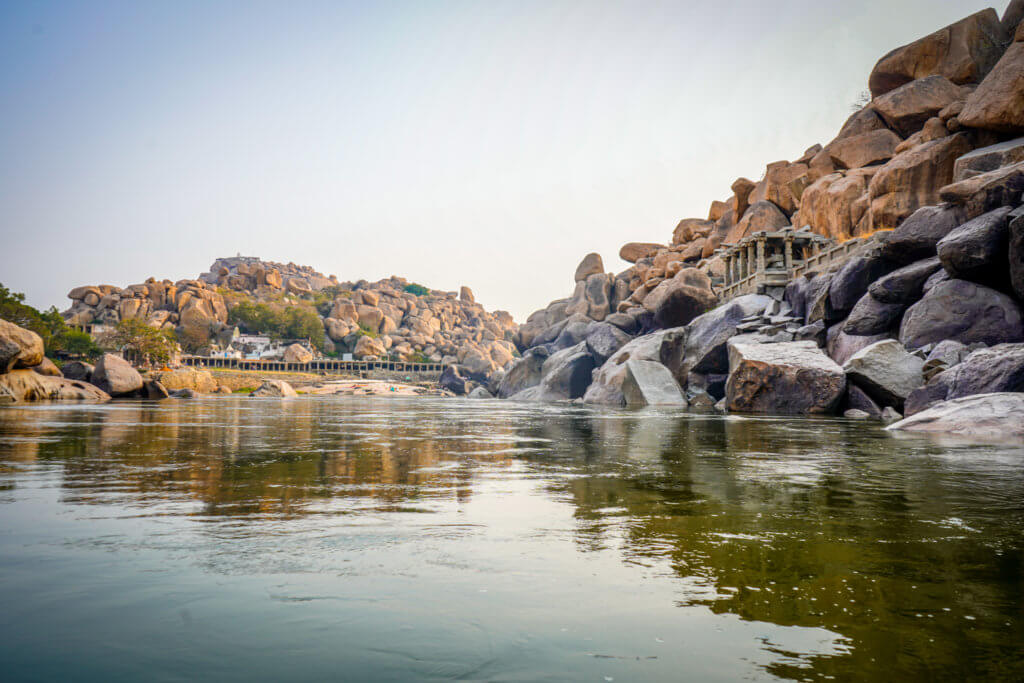
The coracle ride on the Tungabhadra river was our favourite experience and we’re sure you will enjoy it too. The evening is the best time for a coracle ride as the area is in shade in the evening.
The round boat (coracle) is rowed on the river between massive boulder-strewn cliffs on either side. It is incredibly serene and so hypnotising that you’ll forget you’re in present-day India. You’ll see flowing water, boulders, temples perched precariously atop these boulders and some even submerged in the water. The boatman will tell you about these temples and tell you other interesting facts about the area. Then he will ask you for permission and spin the boat. Shut your eyes and enjoy as the world rotates around you!
We only did the half an hour ride and weren’t completely satisfied, so I suggest you do the whole one hour ride.
The coracle ride costs Rs. 400 per person for half an hour and Rs. 750 per person for an hour.
Sunset at Kamalapur Lake
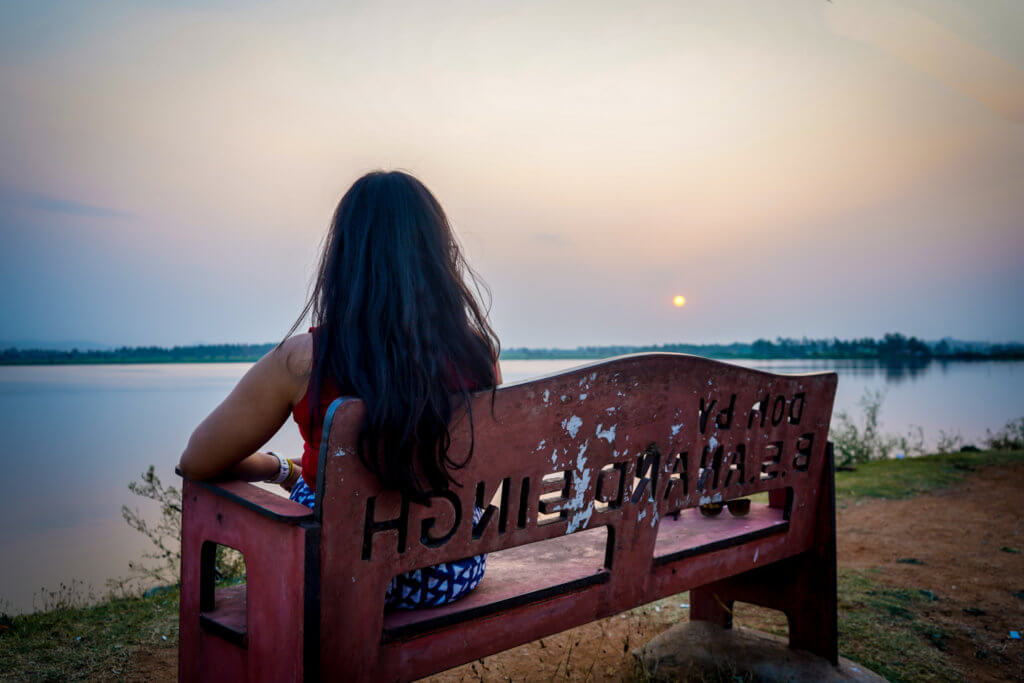
For sunset, just sit on the benches on the banks of Kamlapur Lake (you’ll see this from the road itself while going from Hampi to Kamalapur) and enjoy as the sun dips and the birds fly by! You’ll only be able to do this if you have your vehicle as there is no transport available in the area.
Phew, that was a long day. It feels longer than it was but for sure it will be tiring. Sleep early to be rejuvenated for the next day’s adventures.
Matanga Hill
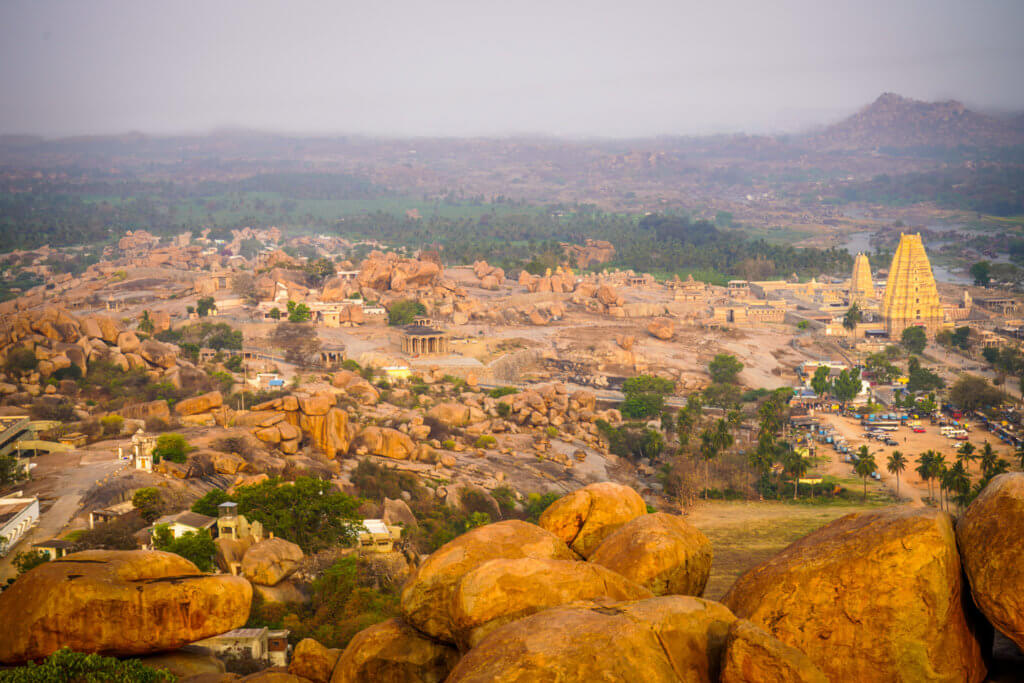
Do a sunrise climb to Matanga Hill that has a small Veerbhadra temple at the top. The view from the hill is incredible. You’ll see vast expanses of paddy fields, mountains, scattered boulders, Hemakuta Hills with all its temples, Virupaksha Temple and Achutaraya Temple. You might also be shown a cave on your way up. The hike to Matanga hill is not to be missed!
I suggest hiring a guide for this hike since the path is not defined. As it is just through rocks, it is exposed and slippery in some areas so it is ideal to have someone knowledgeable and confident guide you up. Besides that, the hike isn’t gruelling at all! It takes 40 minutes to reach the top. You will have to start the hike between 5:30 AM-6 AM but confirm the time with your guide first. The hike back down is is a relatively easy one through proper stairs.
It is always better to do this hike at sunrise than at sunset due to the danger of bears after dark!
Have Breakfast and Change
It’ll be around 8:30 AM-9 AM by now. Go back to your hotel to change out of your sweaty hike wear and have breakfast. If you want to catch a little nap (like we did) you can do that too and head out by 10:30 AM -11 AM. You will not be coming back to the hotel until after sunset!
If you don’t care about hotel breakfast, then explore Achyutara temple (below) first before going back to change, as it is located right beside Matanga Hill.
Achyutaraya Temple
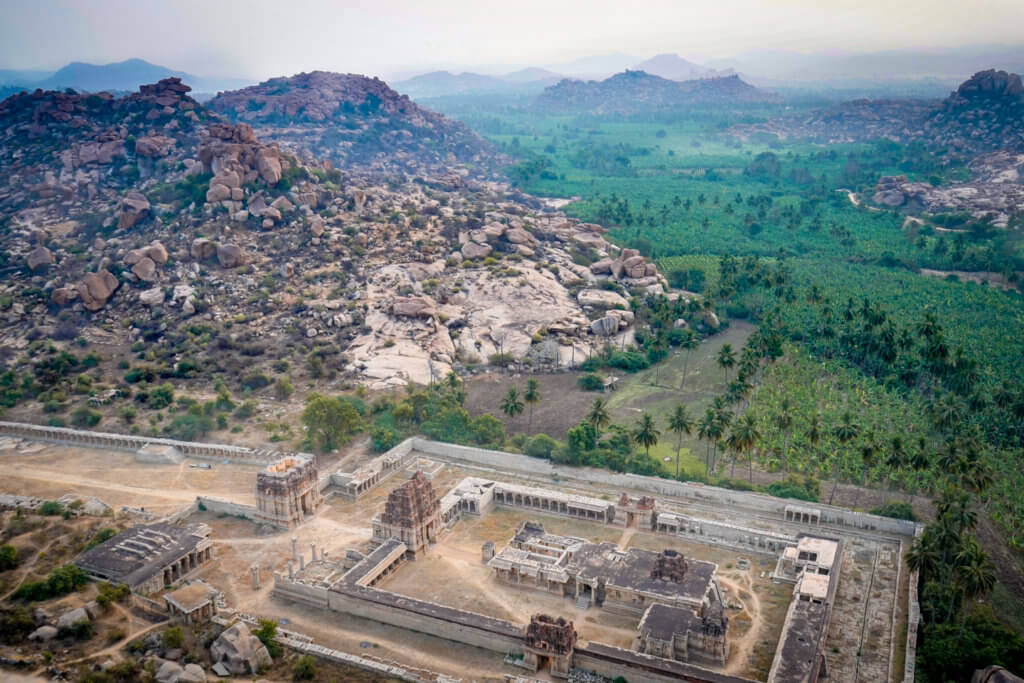
We didn’t visit this temple ourselves (despite plenty of requests to our guide), however, it is a great place to visit as far as I know. It is a temple dedicated to Lord Tiruvengalanatha, a form of Vishnu. The pillars and walls of the temple have exquisite carvings and ornamentation. The temple is secluded so few people visit!
Park your car/ get off at the Virupaksha Temple parking. Now head toward the opposite side of Virupaksha temple. You’ll see the Hampi Bazaar on either side and the Monolithic Bull at the base of the hill before heading to explore the temple. The visit will take an hour or so.
Note that this temple cannot be visited after 5 pm as leopards have often been stopped after that time, so visiting during the daytime is ideal!
Lunch at Baba Café
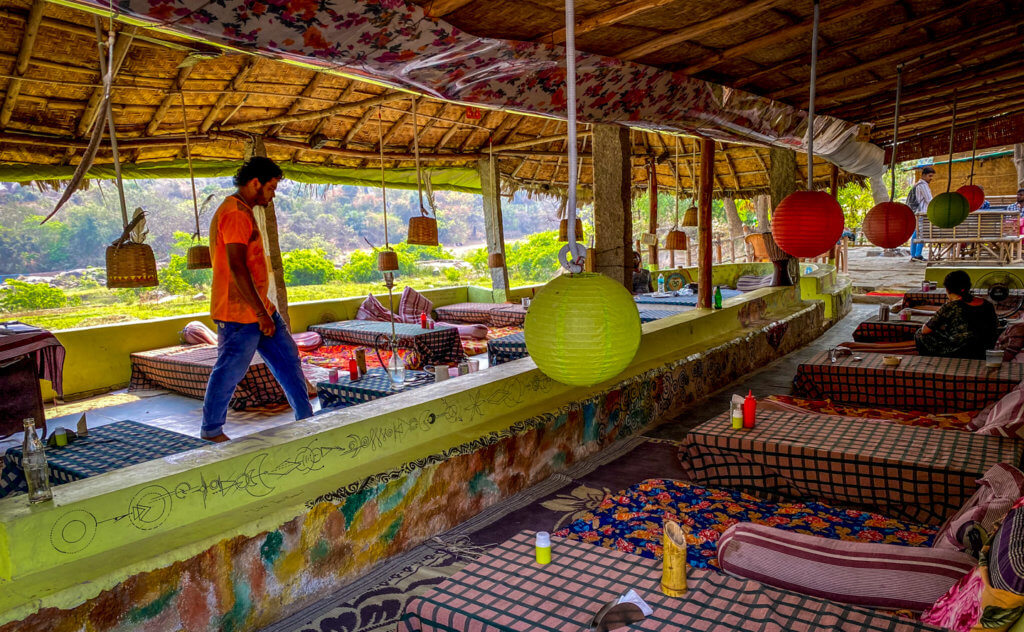
Head to the other side of the river for a relaxing lunch at Baba café. This café is reminiscent of the hippie island days with a similar vibe. Due to it’s awesome location amongst nature, the cafe makes for a great place to have some beer and international fare.
Attractions around Anegundi
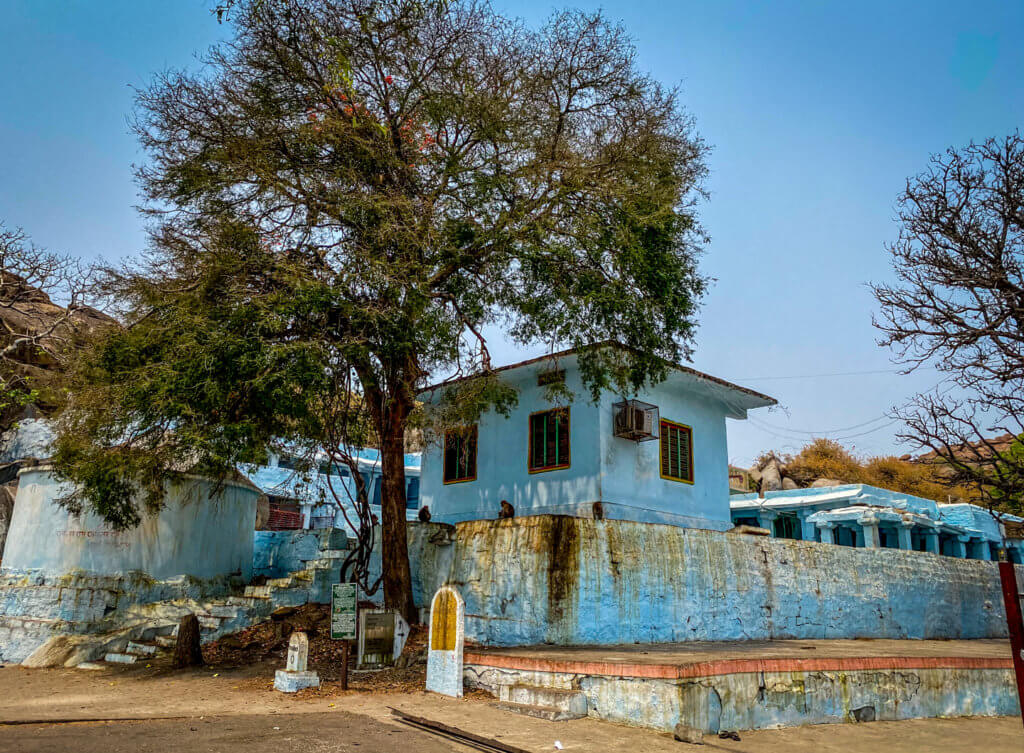
Visit temples at Anegundi only if you’re religious or into the Ramayana. We only visited these because our guide had planned today’s itinerary with no interference from us. As per us, these temples are not architecturally beautiful – just regular temples.
- Chinthamani Temple: Chintamani Temple is a Shiva Temple visited by Ramayana enthusiasts. It is the spot from where Ram aimed and shot his arrow to kill Baali during his fight with Sugreev. The temple is worth considering for all due to its epic location beside the Tungabhadra.
- Pampa Sarovar Temple: Pampa Sarovar is a sacred lake for Hindus – one of the 5 sacred lakes (Panch Sarovar) in Hindu mythology. The temple is constructed where Pampa (a form of Parvati) punishes herself to show her dedication to Shiva. If you’re not into mythology, consider visiting only from November to December when lotuses are in full bloom at Pampa Sarovar Lake.
- Anegundi Fort: The Anegundi with its many gates, tombs and temples (Ganesha Cave Temple and Durga Temple) is a sprawling fort that once used to guard the region.
Another famous spot is Sanapur Lake. Again, we did not find it worth the visit. This is where cliff jumping took place. However, per our guide cliff jumping is now banned as several people have lost their lives while at it. If you wish to cliff jump, do ask the locals before attempting it. We did a coracle ride here too but it paled in comparison to the one on the Tungabhadra. Do a coracle ride here only in the Monsoons when coracle rides in the Tungabhadra are not possible due to the strong current.
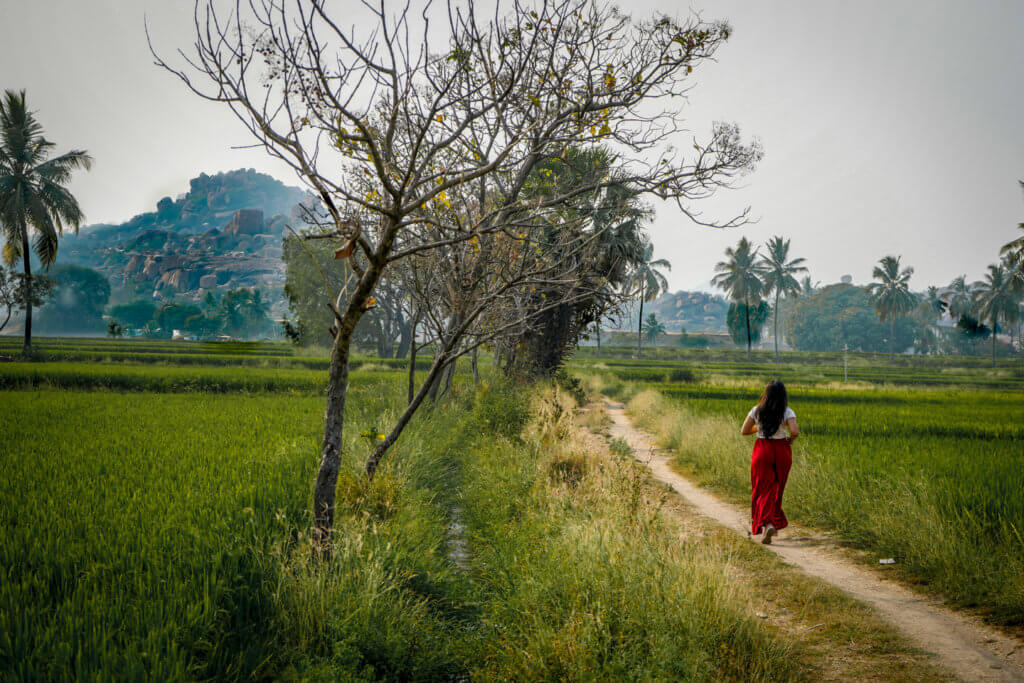
You can do all the things mentioned above if they appeal to you. Else, simply drive around the area through lush paddy fields. This is the bit I loved. Riding a bike here (if available) is an excellent option!
Anjaneya Hill
This hill is known to be the birthplace of Lord Hanuman! There is a Hanuman Temple on top of the hill which takes about 2 hours to climb through a well-defined shaded path. Check the sunset time on google and start your hike up well in time to be able to explore the temple and see a spectacular sunset from the top!
This brings us to the end of the three days Hampi itinerary. If you have more time on hand you can consider visiting the Krishna Temple near Kamalapur, the Underground Shiva Temple or the Tungabhadra Dam at a distance of 27 km from Hampi. The dam’s premises has a Japanese style garden that makes for a pleasant visit.
Read our post on the 25 best places to visit in and around Hampi for more details or options for things to do.
Hampi Travel Tips
Photography : Drones, tripods, high-resolution cameras, and any out of the ordinary camera equipment is not allowed at Hampi’s sites. We carried our DSLR without issues, however. You aren’t even allowed to sketch, paint or draw at the sites. Per our knowledge, you can do all of this on the other side of the river – Anegundi and surrounds.
Guide : Hire a guide to understand the ancient ruins better. A full day guide cost around 2000 per day but due to COVID, some may ask about 1500 per day. However, while they make navigating the ruins of Hampi a breeze and make you understand the structures better, they also kind of put pressure on you to hurry up in order to show you as much as possible.
If you’re okay with that, do use full day guides. Honestly, we felt it was a bit rushed.
Photographers, bloggers and vloggers would be better off hiring guides at specific structures. Follow this itinerary and hire guides at Vithalla Temple, Royal Center, and for the Matunga Hill hike.
When hiring one, ensure he/she speaks your language fluently. Ours wasn’t very fluent in English or Hindi so sometimes it got very difficult to understand what he was explaining.
Google Maps : Download offline maps of the area on Google Maps to navigate easily. The internet is quite sketchy in Hampi.
Cash : Keep cash on you to pay for things like tender coconut, sugar cane juice, entry tickets, guide hire, coracle ride etc. While UPI is widely accepted, it doesn’t work a lot of times because of bad internet.
Shoes : Wear comfortable walking or sport shoes as you’ll be walking all day and hopefully even hiking.
Clothes : Wear comfortable clothing in Hampi. There are no restrictions on what you wear to temples. However, it will be better to dress appropriately (cover midriff and knees) to not hurt the religious sentiments of worshippers.
Day Bag Items : Important things to carry in your day bag for exploring Hampi:
- Sunscreen : Physical sunscreen without a white cast
- Some light snacks to eat in case you get hungry midway – We always carry Whole Truth Minis for a quick but healthy bite.
- A filled reusable water bottle (at least one each per person). We particularly like collapsible bottles to save space or the thermos type bottlesto keep water cold .
- A reusable straw for drinks on the trip. Think tender coconut and sugar cane juice. Yum!
Hope this Hampi travel guide mentions all that you were looking for. Comment below if you thought our Hampi travel blog post was helpful. Also, do tell us if we are missing any information you’d like mentioned in the post.
Pin It For Later
This blog post on the ‘Hampi Travel Guide and Hampi Itinerary’ has affiliate links that enable us to earn a small commission when you make a purchase, with no extra cost to you. We only recommend products and activities we like and those that might interest you. If you like any suggested product, do buy from the given links.
1 thought on “A Complete Hampi Travel Guide 2021: Hampi Itinerary & Tips”
Nice blog about hampi, worth reading your blog. Nice information you have provided about hampi. If you want stay in this beautiful place, connect with us to book a luxurious stay at evolveback hampi
Leave a Comment Cancel Reply
Your email address will not be published. Required fields are marked *
Save my name, email, and website in this browser for the next time I comment.
Essential Travel Guide for Visiting Hampi in Karnataka
The Evocative Ruins of One of India's Greatest Hindu Kingdoms
:max_bytes(150000):strip_icc():format(webp)/10947453_10153084623948270_8191342691038933499_o-591d1e8d3df78cf5fa731909.jpg)
TripSavvy / Faye Strassle
Laid-back Hampi was the last capital of Vijayanagar, one of the greatest Hindu kingdoms in India’s history. The area has some amazing ruins, intriguingly intermingled with large boulders that dot the landscape. It's a must-visit destination in India , and an incredible energy can be felt there. Plan your trip with this Hampi travel guide.
Emperor Krishna Deva Raya built many temples and other structures at Hampi during the powerful reign of the Vijayanagar Empire in South India, from the 14th to 16th centuries. The flourishing capital was regarded as the center of South India , and its vibrant marketplace was one of the largest trading hubs in the world selling all kinds of goods to foreigners.
Hampi was naturally fortified by hills that protected it from invaders approaching from the north and south. However, its glory finally came to an end in 1565 when the five allied Deccan Sultanates of Bijapur, Bidar, Berar, Golconda and Ahmednagar succeeded in defeating ruler Rama Raya (the son-in-law of Krishna Deva Raya) in the Battle of Talikota. Six months of subsequent plundering reduced Hampi to ruins. Sadly, its grandeur was never able to be reinstated.
Hampi's ruins were discovered in 1800 by Colin Mackenzie, who became the first Surveyor General of India under the British East India Company. Extensive excavations followed, and are still being carried out by the Archeological Survey of India. In 1986, Hampi was declared a UNESCO World Heritage Site.
Hampi is located in central Karnataka , approximately 350 kilometers (217 miles) from Bangalore in South India.
How to Get There
The nearest airports are Bellary/Ballari (two hours away) and Hubli (four hours away). From there, you'll need to arrange bus or taxi transportation.
Alternatively, the closest railway station is in Hospet , about half an hour away. Overnight trains run to Hospet several times a week from Bangalore and Goa. Buses also operate from Bangalore and Goa, as well as from Mysore and Gokarna in Karnataka, and will drop you in Hospet. The train is definitely more comfortable and preferable though. From Hospet, you can take a bus or auto-rickshaw to Hampi. The local buses are frequent and inexpensive, and better than a long and dusty auto-rickshaw ride.
The best time to visit Hampi is when it's cool and dry, from November to February. In March, the weather starts getting unbearably hot.
If you enjoy local color and culture, make sure you go during the three-day Hampi Festival (also known as the Vijaya Utsav). Dance, drama, music, fireworks, and puppet shows all take place with the ruins of Hampi as a backdrop. This popular (and crowded) festival usually happens in November but has been moved to January in the last couple of years, so it's wise to check the dates with Karnataka Tourism beforehand.
In March or April, the Virupaksha Car Festival is held to mark the annual marriage ritual of the gods and goddesses. It's the largest religious festival in Hampi.
Hampi is also a good place to celebrate the Holi festiva l in South India, in March.
How to Visit
Hampi is ideally explored on foot or by bicycle, so it's important to wear comfortable shoes. Hiring a scooter is also an option.
The main group of monuments (including the Vittala Temple, Elephant Stables, and Royal Center) requires an entry ticket. The cost is 600 rupees for foreigners and 40 rupees for Indians. The ticket also provides entry into the Archeological Museum. The Vittala Temple is open from 8:30 a.m. to 5:00 p.m. daily. The Elephant Stables, which once housed the royal elephants, are open from 8:30 a.m. to 6:30 p.m. daily. Get there as early as possible to beat the crowds.
The surrounding ruins can be explored at leisure and there is no charge.
A guided tour is helpful to uncover Hampi's extensive history. Options offered by Travspire include a full-day heritage tour, half-day tours including stories from the Ramayana narrated by a local guide, and a six-hour village tour of Anegundi and surroundings. There's also a tourism office at the Virupaksha Temple, where you can hire guides and bicycles. Lakshmi Heritage Tourist Home has decent quality bicycles for rent near the temple too.
Do note that meat and alcohol aren't available in Hampi town as it's a religious place. However, both can be obtained across the river in Virupapur Gadde. Ferries depart riverside near the Virupaksha Temple.
There aren't any ATMs in Hampi. The closest ones are in nearby Anegundi and Kamalapura. It's a good idea to make sure you withdraw the cash you'll need while in Hospet.
What to See and Do
Hampi's ruins stretch for just over 25 kilometers (10 miles) and are made up of more than 500 monuments.
Most striking is the Vittala Temple, dedicated to Lord Vishnu. It's situated amid boulders on the southern bank of the Tungabhadra River not far from the center of town, and represents the culmination of Vijayanagara temple architecture. Its main hall has 56 pillars that, when struck, make musical sounds. To the east of the hall is the iconic Stone Chariot. Most incredibly, its wheels can still turn!
The Royal Center, where Vijayanagar rulers lived and governed, is another must-see. At its core is the ornate Hazara Rama Temple, with panels of intricate sculptures featuring regal processions of elephants, horses, musicians, and warriors.
The ancient traditional water tanks, or step wells, are another highlight in and around Hampi. Their aqueducts carried water all over the city. The Stepped Tank at the southeastern side of the Royal Enclosure is particularly impressive. It remained covered by mud and sand, with a mound on top, until about 20 years ago.
In the Main Bazaar, the towering Virupaksha Temple is still actively used for worshiping Lord Shiva. The temple existed in a much smaller form before the Vijayanagar Empire, perhaps as early as the 8th century, making it one of the oldest structures in Hampi. The temple is open from sunrise until sunset, and there's a nominal entry fee. Allow at least an hour and a half to enjoy it.
Hampi is also renowned for its monolithic sculptures. Some, such as the Kadalikelu Ganesha in a temple on Hemakuta Hill, are as high as 15 feet tall. What's really remarkable is that one misplaced chip when carrying out the sculpturing would've caused the granite rock to fall apart. There are beautiful sculptures on rocks alongside the river, which were prototypes of those inside the temples.
Sunrise and sunset over the village, viewed from atop the central Matanga Hill, are truly magical and not to be missed.
If you have time, take a ferry across the river to Anegundi and explore the ancient structures there as well.
Where to Stay
There are two main areas to stay in Hampi -- near the bus stand and Main Bazaar, and on the edge of paddy fields across the river in rural Virupapur Gadde. The lively Main Bazaar area is packed with cheap guesthouses, shops, and restaurants. Budget accommodations at Virupapur Gadde are preferred by hippies and backpackers who want to spend time chilling out. Many people choose to spend a couple of nights in each place to experience their different atmospheres.
Hampi's upmarket properties are all located out of town.
What Else to Do Nearby
If you're into wine, don't miss visiting award-winning Krsma Estate vineyards, about two hours north of Hampi.
A side trip northwest of Hampi to the heritage sites of Badami, Aihole, and Pattadakal is worthwhile to see monuments and ruins from the Chalukya Empire, which ruled there between the 4th and 8th centuries.
East of Hampi, Bellary Fort is another Vijayanagar Empire monument from the 16th century. Tickets cost 300 rupees for foreigners and 25 rupees for Indians.
16 Best Tourist Destinations in India
15 Best Destinations for Backpacking in India
Guide to the Best Budget Hotels in India
15 Top Tourist Places to Visit in South India
12 Top Tourist Places in Karnataka
15 Places to See Magnificent Temples in South India
14 Famous Forts and Palaces in India that You Must See
15 of the Best Offbeat Places to Visit in India
8 Top Luxury Stays in Bangalore from Colonial to Chic
20 Top Things to Do in Diverse India
12 Cultural Things to Do in Goa Beyond the Beaches and Bars
Bangalore Guide: Planning Your Trip
Guide to Luxury Train Tours of India
Fatehpur Sikri in India: The Complete Guide
Goa in the Monsoon Season: Essential Travel Guide
18 Best Places to Visit in Kolkata to Discover the City
Hampi: The Perfect Itinerary For An Epic Trip
The mere mention of Hampi evokes thousands of feelings in our hearts. Once the capital of the esteemed Vijayanagara Empire, Hampi has now enlisted as a UNESCO World Heritage Site thanks to her architectural and sculptural remains.

Table of Contents
Know before you go: all about Hampi:
Hampi was originally known as Pampakshetra. It was named after Pampa, a reincarnation of Sati. Pampa had fallen in love with Shiva, who was then meditating at Hemkuta Hill. Eventually, Shiva was impressed by Pampa’s dedication and married her. In fact, Shiva is known as Pampapati in Hampi. Also, Hampi is a contorted term derived from the word ‘Pampa’.
In Ramayana, Hampi was called Kishkindha. It was the kingdom of monkeys. It was from here that Rama embarked on his mission to rescue Sita from Lanka.

Historically, Hampi was the capital of the mighty Vijayanagara Empire. It was the second largest city of the Medieval Age. It was also the richest city in the contemporary world. Foreign visitors from Persia, Italy, Portugal, and Russia have left chronicles of a prosperous city, which was conquered by the Deccan Sultanate troops in 1565 CE, ravaged for six months, and then abandoned.
Know more about Hampi from our previous blog post here .
Where is Hampi located:
Hampi is located in central Karnataka, near the state border with Andhra Pradesh. It is situated on the banks of the Tungabhadra River. It is 376 km from Bengaluru and 165 km from Hubli.

How to reach Hampi:
- By air: The nearest airport is at Torangallu (32 km from Hampi), which, in turn, is well–connected with Bengaluru by air.
- By rail: Hospet (13 km from Hampi) is the nearest rail station.
- By bus: Overnight bus services are available from Bengaluru.
As for us, we reached Bengaluru from Kolkata by flight. Then, we boarded the train from KSR Bengaluru station. We reached Hospet at 7 AM after an overnight journey. From Hospet, we took an auto to Hampi. The auto charged INR 250.
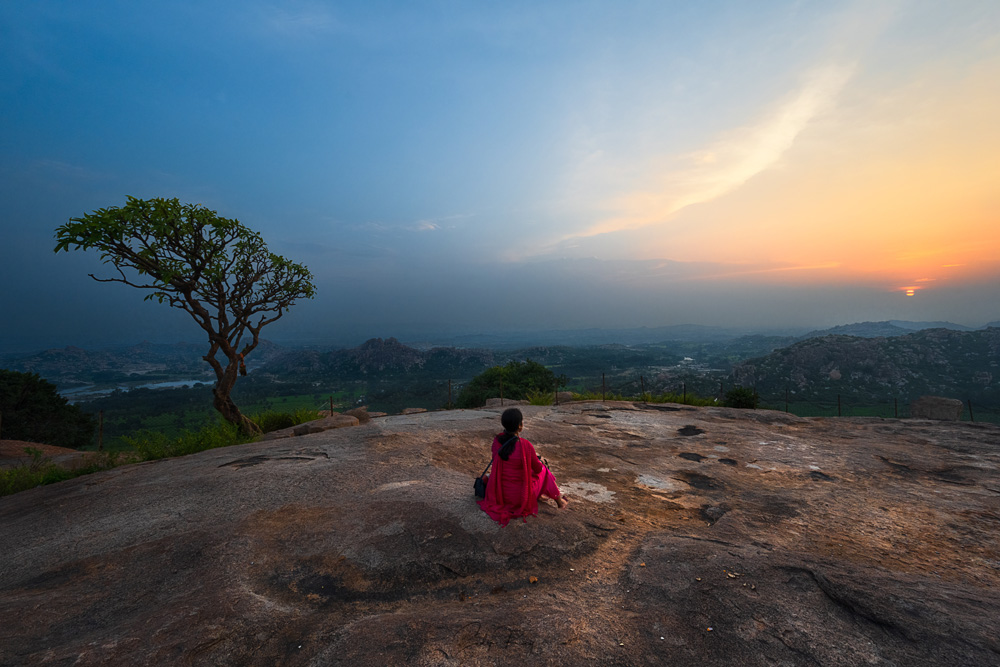
What is the best time to visit Hampi:
Given its rocky terrain, Hampi remains excruciatingly hot during most part of the year making it extremely difficult to explore the ruins. Hence, it is best to visit Hampi from October to February. The temperature remains moderate and the chances of rainfall are almost nil during this time.
How to travel within Hampi:
The most convenient way to travel in and around Hampi is by auto. The daily fare of an auto is around INR 1000. Don’t forget to bargain a bit.
You can rent a scooter and bike at INR 200 – 300 per day depending on the type of vehicle.
You can also rent bicycles at INR 100 – 150 per day.
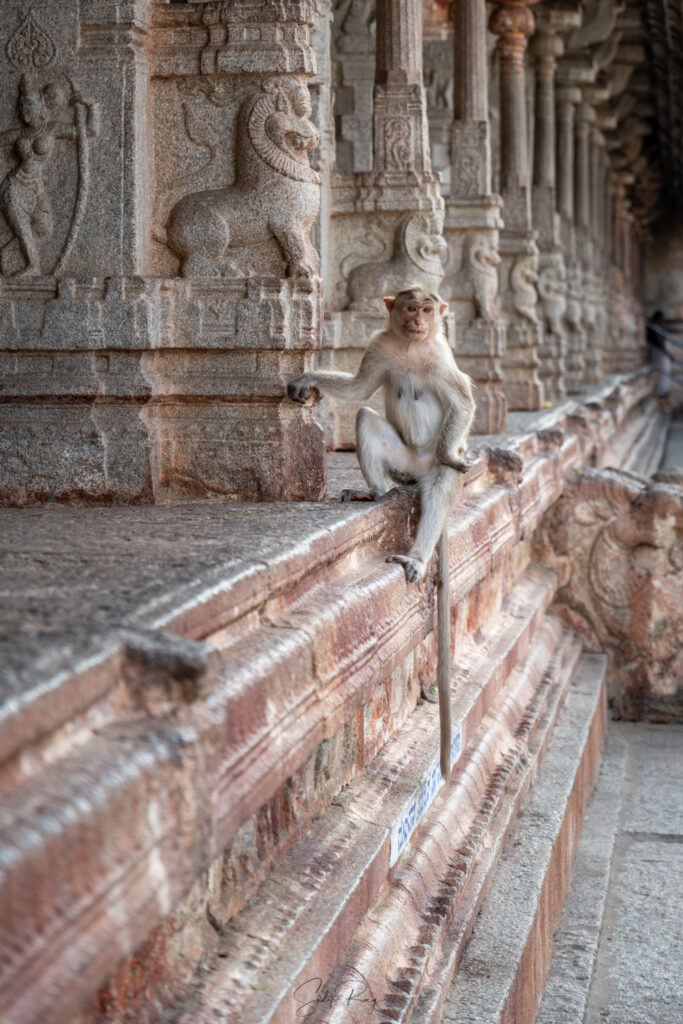
Where to stay in Hampi:
We stayed at KSTDC Mayura Bhuvaneshwari at Kamalapura. The room was decent and provided with all amenities. We also loved the food here. The staff are cordial too. You can check the current room rent and book rooms from here .
The Clark’s Inn Hampi is another good option for accommodation. This hotel is located just opposite the Archaeological Museum.
Books on Hampi:
We will suggest reading about the Vijayanagara Empire before travelling there. It will help you to understand the history of Hampi and thereby feel this amazing place. Read “A Forgotten Empire” by Sewell and “Hampi Vijayanagara” by Fritz & Michell.

What are the things to do in Hampi:
1. The best and most important thing to do here is obviously to explore the countless ruins of the Vijayanagara Empire.
2. Sunset in Hampi is regarded as one of the best in Asia. Watch beautiful sunsets from Hemkuta, Matanga, and Anjanadri Hills.
3. Take a coracle ride on the Tungabhadra River, especially during the sunset.
4. Don’t forget to visit the Archaeological Museum. True, Hampi is often considered an open museum. Yet, its museum houses some spectacular and important relics of Vijayanagara.
5. Explore the rural side of Hampi. The paddy fields, coconut groves, and banana plantations add to its idyllic beauty.
6. If you are up for an adventure, you can go rock climbing in Hampi.
7. Hampi is also known for birding.
8. You can also visit the Daroji Bear Sanctuary to see sloth bears.

How many days are enough for Hampi:
No matter how many days you stay at Hampi, you will end up wishing to spend a few more days there. Alas! If only, our bosses at work understood!
Ideally, 3 days will be sufficient to explore Hampi. We spent 3 days and covered even some of the off-beat places here.

In this blog, we will share our very own itinerary. Along with that, we will also chalk out itineraries for 2 days and 1 day. You can modify them at your convenience.
On our first day, we started our exploration by visiting the following places in and around Kamalapura:
1. Vijaya Vittala Temple:
This is one of the most important temple ruins of Hampi. It is considered a masterpiece of Vijayanagara temple architecture. Since it remains crowded for a good part of the day, we visited around 7 in the morning.

On entering through the eastern ‘gopuram’, the magnificent stone chariot grabs all the attention. The stone chariot believed to be inspired by Konark’s Sun Temple, is undoubtedly one of the most popular tourist attractions here.

Later, we took the dirt road on the left of the Vittala Temple and reached the King’s Balance . The Vijayanagara emperors are believed to have had themselves weighed on this balance against gold and precious stones, which were later distributed among temple priests.
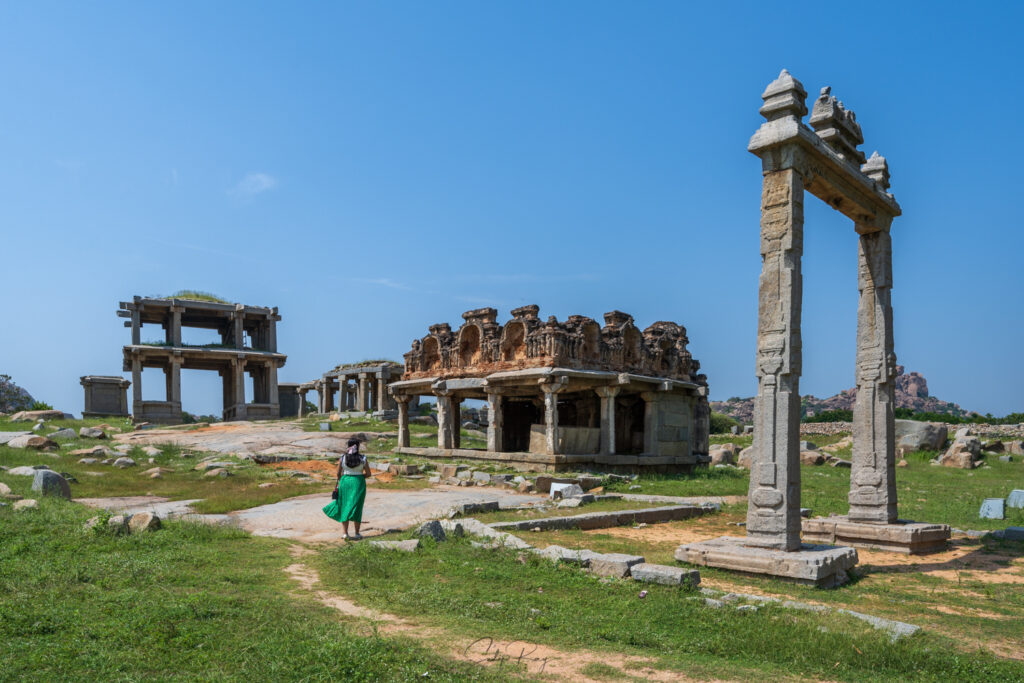
2. Malyavanta Hill:
This place is laced with tales from Ramayana. Rama is believed to have spent four months here while looking out for Sita. The relief carvings of Shiva lingams and Nandis found on the hill were worshipped by him. We were also captivated by the panoramic view of Hampi from above Malyavanta Hill.
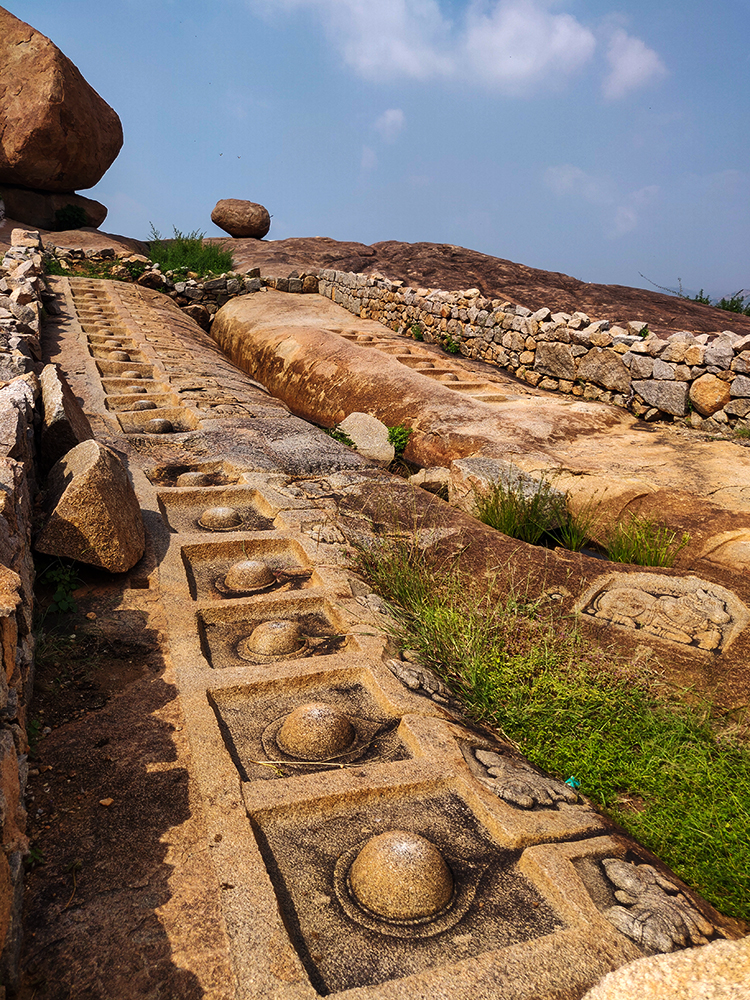
The summit of Malyavanta has the beautiful Raghunatha Temple. It is only in this temple that Rama can be found worshipped in a seated position.
3. Bhima’s Gate:
Next came Bhima’s Gate. A slab carved with Bhima, Mahabharata’s hero, was found here, hence the name.
4. Ganagitti Jain Temple:
An inscription of 1385 CE on the ‘dipa-stambha’ mentions that this Jain temple was built by Irugappa, a general of Harihara II. The structure of this temple is quite simple and austere in style with plain outer walls.
5. Pattabhirama Temple:
Our next stop was Pattabhirama Temple, which is one of the largest temple complexes in Hampi.

The temple was dedicated to Lord Rama. It was probably built by Achyutaraya of the Tuluva dynasty. It once formed the nucleus of an urban cluster called Varadevi Ammana Pattana, named after one of the queens of Achyutaraya.
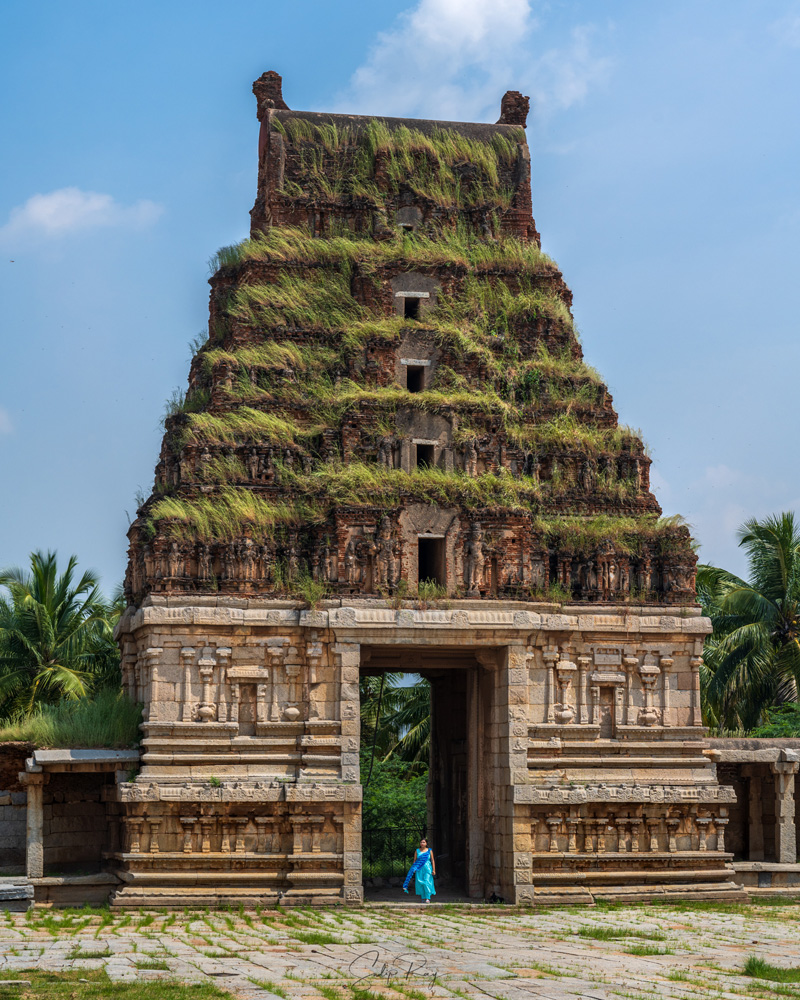
A short walk from the temple brought us to its ‘pushkarini’. We also visited the Domed Gateway nearby, which once served as an entrance to the urban cluster from the southeast.
Post-lunch, we decided to explore the Sacred Cluster of Hampi.
6. Narasimha Monolith:
This colossal statue, standing at 6.7 meters high, is extremely popular among tourists. It was commissioned by Krishnadevaraya in 1528 CE. The Narasimha is seated cross-legged beneath the Sheshanaga.
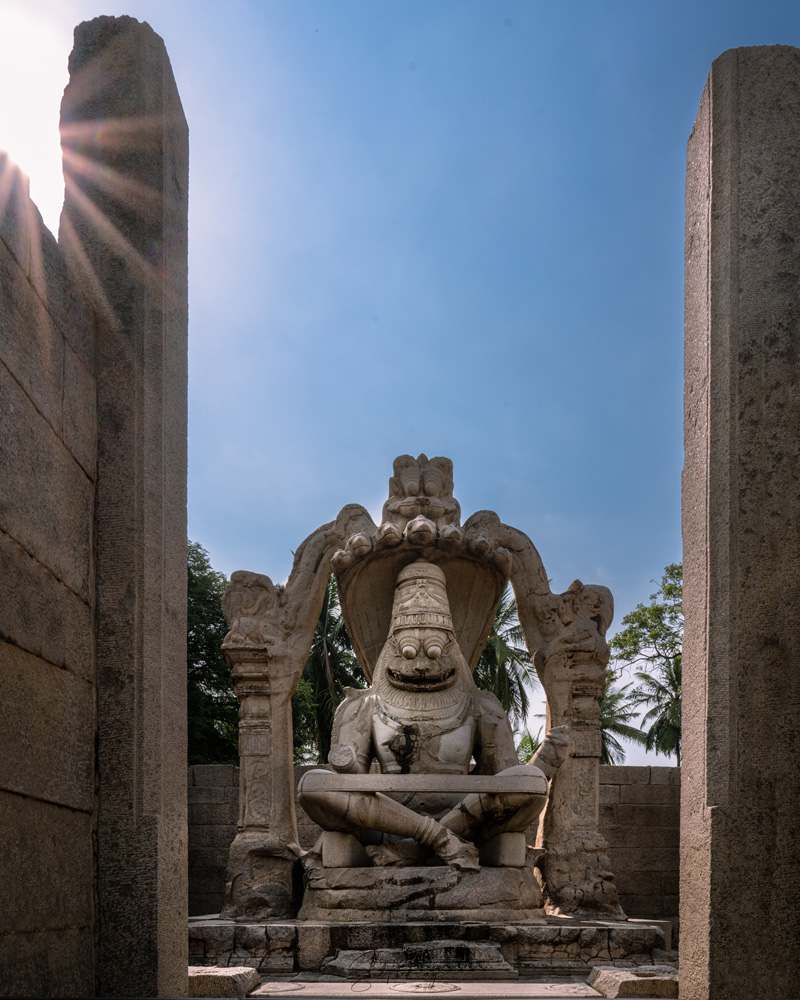
Originally, there was a statue of Lakshmi seated on the lap of Narasimha. Sadly, nothing is left of the figure of the goddess.
7. Badavi Linga:
Right next to the Narasimha statue, there is a monolithic Shiva linga, which is about 3 meters tall.

8. Krishna Temple:
This is another significant temple ruin of Hampi. It once formed the epicentre of the Krishnapura urban cluster.

The temple was commissioned by Krishnadevaraya in 1515 CE to celebrate his victory over the Gajapati rulers of the then Orissa. During its heyday, this temple housed a granite icon of infant Krishna, which was brought from Udaygiri.
9. Virupaksha Temple:
It is one of the few intact and active temples in Hampi, which remained unscathed from the destruction caused by the Sultanate. During the Vijayanagara Empire, it was the main temple and principal centre of pilgrimage. Even today, throngs of pilgrims visit this temple every day.

The temple is dedicated to Shiva, who is venerated as Virupaksha and Pampapathi here. Along with him, his two consorts – Pampa and Bhuwaneshwari – are also worshipped here.

10. Kadalekalu Ganesha:
After Virupaksha Temple, we went to the Hemkuta Hill. Here, we first visited Kadalekalu (roughly translated to gram seed) Ganesha.

The 4.5-meter-high statue has been carved out of a massive single boulder.
11. Sasivekalu Ganesha:
This is another prominent monolithic statue of Ganesha, rising at 2.4 meters. The word ‘sasivekalu’ locally means mustard seed.
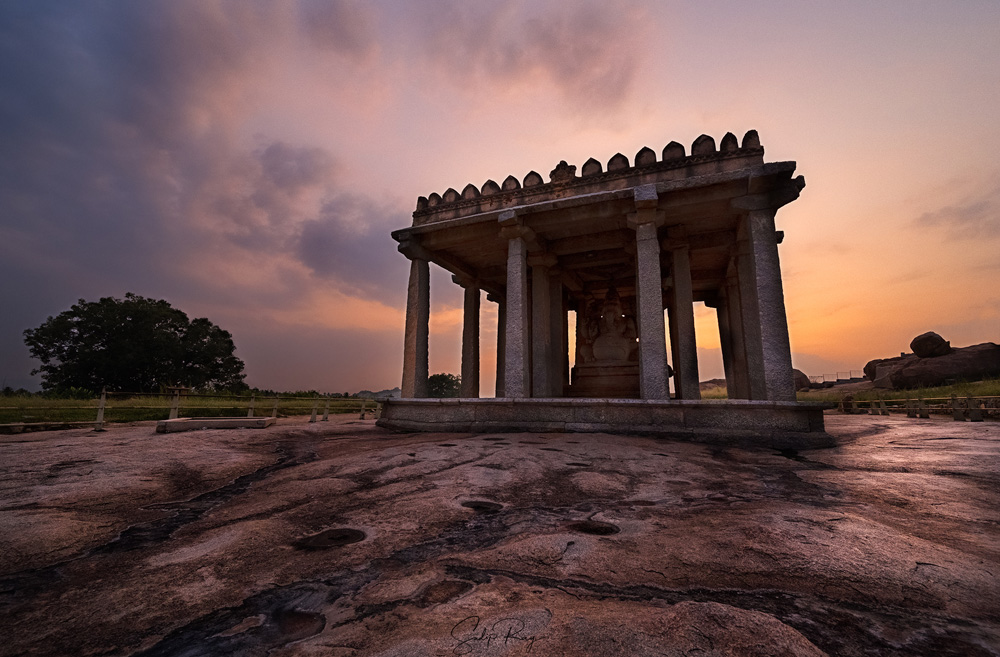
An inscription nearby informs that a merchant engaged in the business of mustard seed had commissioned this temple.
- The first day of exploring Hampi ended with catching the sunset at Hemkuta Hill.
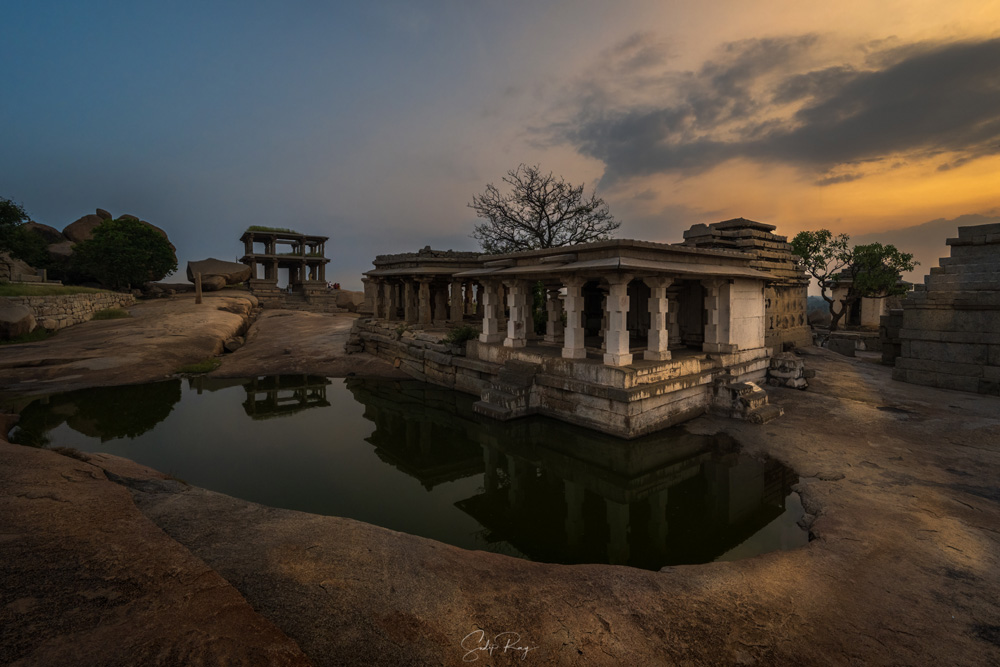
The first half of the second day was reserved for exploring the Royal Enclosure area.
1. Queen’s Bath:
One of the most attractive structures of the Royal Enclosure, the building is influenced by Indo-Islamic architecture.

The name, however, seems to be a misnomer. It was probably used by male courtiers and their female companions.
2. Mahanabami Dibba:
This raised platform was used by the Vijayanagara emperors for receiving honourable guests, watching army processions, games, and cultural performances, and most importantly celebrating the Navaratri festival.

Nothing exists in the upper portion of the platform. Only the base has survived the trial of time. It has countless carvings, which depict the day-to-day lives of the Empire.
From the top of the platform, the entire Royal Enclosure and palace area can be clearly seen. You can also check out the remains of various structures that have been excavated over the years.
3. Hazara Rama Temple:
This temple is another excellent specimen of Vijayanagara temple architecture. As it is located right in the middle of the Royal Enclosure, it is believed that the temple was exclusively used by the King.

This temple was built by Devaraya I of the Sangama dynasty in the early 15th CE. It was dedicated to Rama. The outer walls of the main temple have three tiers of carving, featuring 108 scenes from the Ramayana.
4. Zenana Enclosure:
This is a high-walled compound, which has two excavated palace structures and watchtowers. Contrary to popular belief, historians believe that the women of the Vijayanagara court did not live there. Since it is located in the vicinity of elephant stables and parade ground, the kings and their commanders most likely used it.
5. Lotus Mahal:
The Lotus Mahal is the most attractive structure inside the Zenana Enclosure.

It is characterized by a cluster of nine pyramidal towers and lobed arches.
6. Elephant Stable:
This is another specimen of Indo-Islamic architecture in Hampi. It comprises eleven chambers, each of which could accommodate two elephants.

After having our lunch and a bit of rest, we started the second phase of our exploration.
7. Coracle ride on Tungabhadra:
The coracle ride on Tungabhadra is one of the pleasant experiences in Hampi.
8. Kodandarama Temple and riverside sculptures:
The Kodandarama Temple is another active temple of Hampi. It is dedicated to Rama and his consort, Sita.
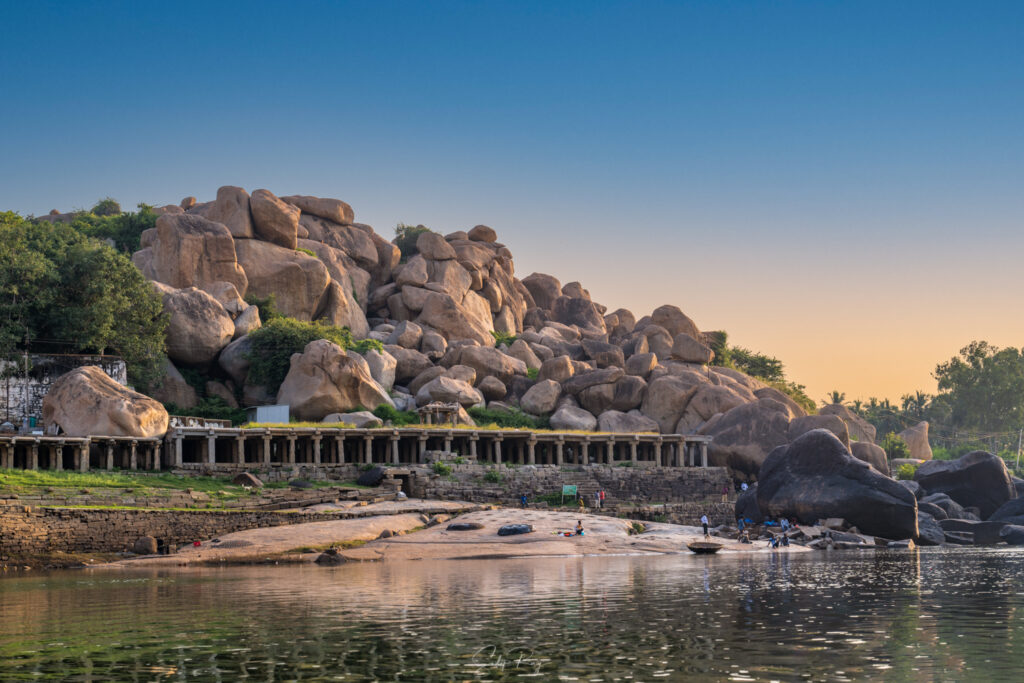
The surrounding area has many sculptures, notable among them are countless miniature lingas and a set of carvings portraying the avatars of Vishnu.
We also visited a cave temple, which remains submerged during the monsoon. It has interesting carvings of Shiva, Veerbhadra, a half-man and half-bull form of Nandi, etc.
9. Achyutaraya Temple:
It is also known as Tiruvengalanatha Temple. It was built in 1534 CE, not by Achyutaraya as the name suggests, but by his brother-in-law.

The temple is in a dilapidated state, although its grand scale and magnificence can still be asserted.
10. Matanga Hill:
We ended our day with another glorious sunset, watching it from the top of Matanga Hill.
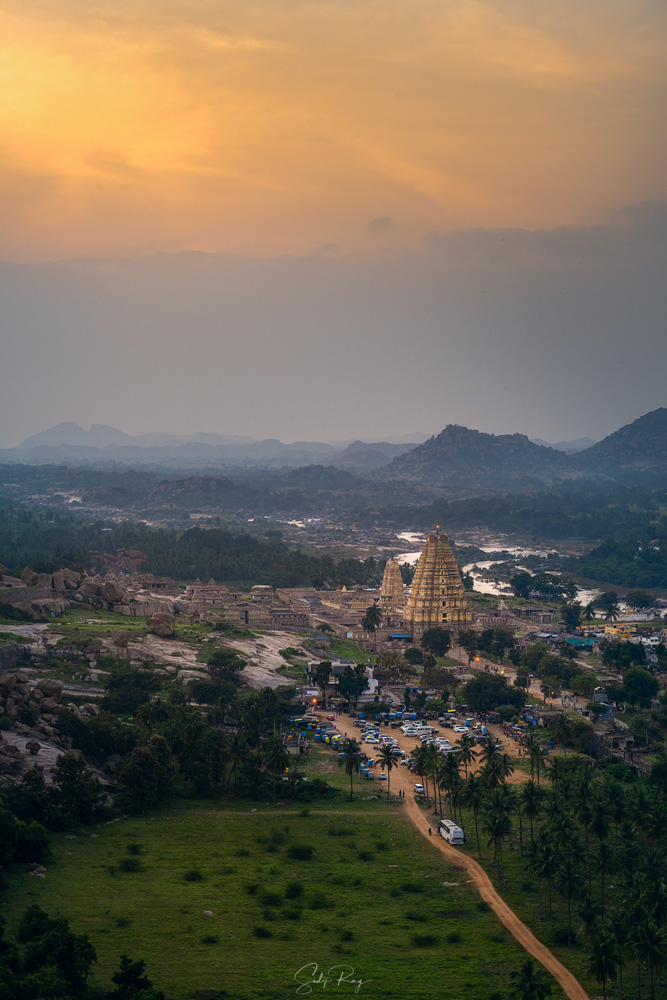
We started our third day by visiting the Archaeological Museum in Kamalpura. It has a fascinating collection of artefacts excavated from various sites of Hampi. The museum is divided into three galleries: the Shaiva Gallery, notable for life-size sculptures of Virbhadra and Bhairava; the Vishnu Gallery, showcasing statues of Garuda, Hanumana, Vishnu, and so on; and the General Gallery, displaying coins, weapons, copper plate inscriptions and such other artefacts of Vijayanagara Empire.
Afterward, we went to Anegundi, which was the first capital of Vijayanagara rulers. Anegundi is located on the northern bank of Tungabhadra. It is also believed to be the monkey kingdom of Kishkindha, as mentioned in the Ramayana.
The places of interest in Anegundi are as follows:
1. Anjanadri Hill:
It is believed to be the birthplace of Hanuman, the monkey god. You need to climb 575 steps to reach the top, which has a temple dedicated to Hanuman.
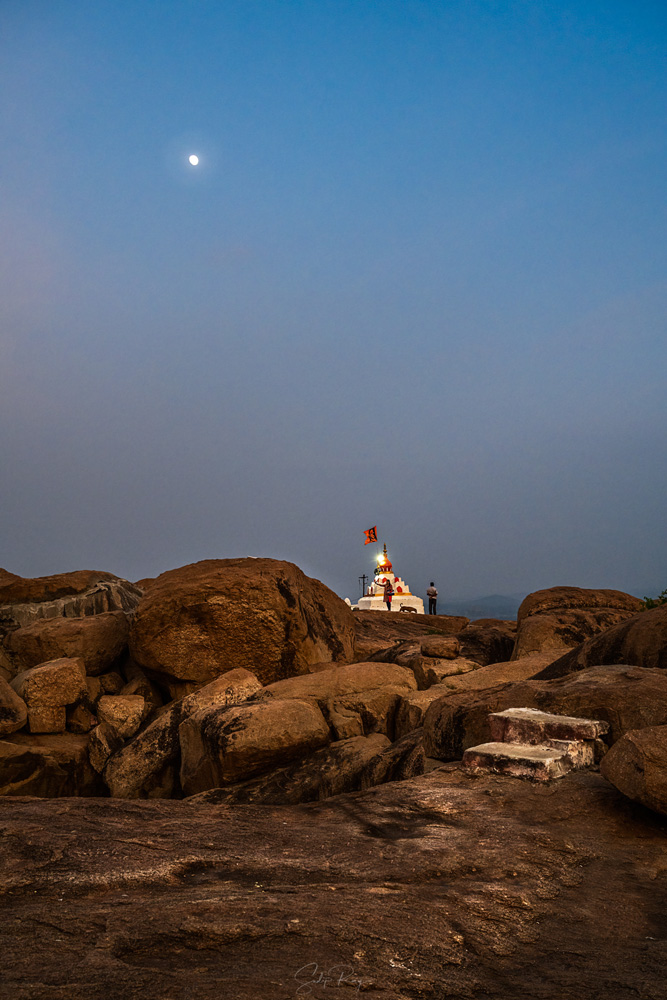
The Anjanadri Hill is also one of the best places to enjoy the sunset in Hampi. We were also amazed by the panoramic view of Hampi that this hill provided.
2. Anegundi Fort:
This was a fortified citadel, which housed a Durga temple and a Ganesha temple.
3. Pampa Sarovar:
This is a holy lake, where Pampa performed penance to show her devotion to Shiva.
4. Sanapur Lake:
It is one of the most scenic places in Anegundi. This natural lake is surrounded by stunning boulders and rocks, which further add to the charm of this place.

We loved this place as it was far less crowded than the rest of Hampi. We found it perfect for enjoying a bit of tranquillity. Also, coracle rides are available here.
Anegundi is also known for its picturesque rural beauty. It is dotted with paddy fields, banana plantations, and coconut groves.
2-days itinerary for Hampi:
If you are visiting Hampi for two days, you can opt for our plan for the first two days, following it to the T. You will have to give Anegundi a miss in that case.
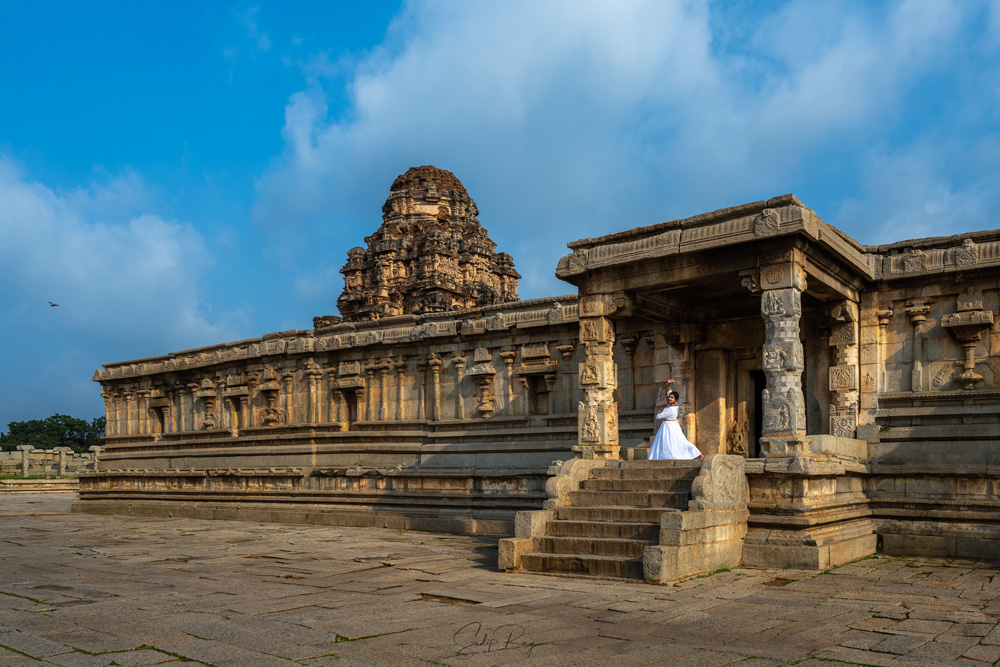
1-day itinerary for Hampi:
In case you have only one day to explore Hampi, we suggest visiting only the most important places. It will be impossible to cover all the places in a go.
Start early with Vijaya Vittala Temple. Then proceed to the Royal Enclosure and visit the Queen’s Bath, Mahanabami Platform, Hazara Rama Temple, Lotus Mahal, and Elephant Stable.
Grab a quick lunch and start exploring the Sacred Cluster. Start with the Narasimha monolith and continue with the Krishna Temple, Virupaksha Temple, Kadalekalu Ganesha, and Sasivekalu Ganesha. Finish your day’s trip by watching the sunset from Hemkuta Hill.

Things to remember:
1. The monuments in Hampi remain open from 6 AM to 6 PM.
2. The Archaeological Museum remains open from 10 AM to 5 PM. It is closed on Fridays.
3. Entry fees are required for visiting Virupaksha Temple, Vijaya Vittala Temple, and Zenana Enclosure. For the rest of the monuments, entry is free.
4. Drones and tripods are not allowed in Hampi.
5. The weather in Hampi is quite hot even at the end of October. Hence, we suggest starting as early as possible. Explore until lunch and take a break afterwards as the sun remains harshest between 12 PM to 3 PM. Start travelling again after 3 in the afternoon.
6. Though Hampi is known for mesmerizing sunsets, you can catch the sunrise from Matanaga Hill. However, the climb is a bit difficult as there is no paved way. It will be tricky to climb the precarious stairway before sunrise.
7. It is unsafe to travel around Hampi after sundown. Bears and leopards lurk around the hills and caves in the darkness.
8. Though the ambience of Hampi is quite chilled out, we suggest dressing modestly as most of the monuments in Hampi are religious in nature.
9. Carry an umbrella, wear hats and sunglasses, and drink plenty of water. Keep yourself hydrated with coconut water, which is easily available in Hampi.
10. Carry sufficient cash as ATMs in Hampi are mostly non-functional.
11. Both vegetarian and non-vegetarian food options are available in Hampi. The restaurants around Hampi Bazar however serve only veg. Some of the best eateries in Hampi are Mango Tree, Gopi Roof Restaurant, Ganesh Old Chillout, Funky Monkey, The Bridge, and Laughing Buddha.
12. We would suggest taking a guided tour of Hampi. It will make your tour more organized and you will get to know countless titbits about Hampi. We hired Mr. Bhanu. He was an excellent guide. He charged us INR 2000 per day. His contact number is 09449409070.
For reading about the Great Living Chola Temples of Thanjavur, visit our latest blog here .
The Floating Pebbles
Related posts.

Malda: Exploring the Monumental Ruins of Bengal’s Past

Svatma Thanjavur: A Homage to the Tamil Heritage

Kalimpong: Romancing the Vibrant Hill-station
Thank you for the detailed information. Beautifully captured pictures!
Thank you for your appreciation!
UNCONVENTIONAL AND VIVID
LEARNING FROM THE WORLD
A Travel Guide for Hampi – Everything You Need to Know
by upsy · Published May 20, 2019 · Updated August 7, 2019
This travel guide for Hampi is perfectly designed for first timers. It almost looks unreal, I screamed in my mind almost a million times! The picturesque and dreamy landscape of UNESCO heritage acclaimed Hampi transported me back to mythological era, into the stories of Ramayana we grew up listening to. As I opened my eyes, the spectacular landscape so perfectly canvassed with the medieval ruins startled me.
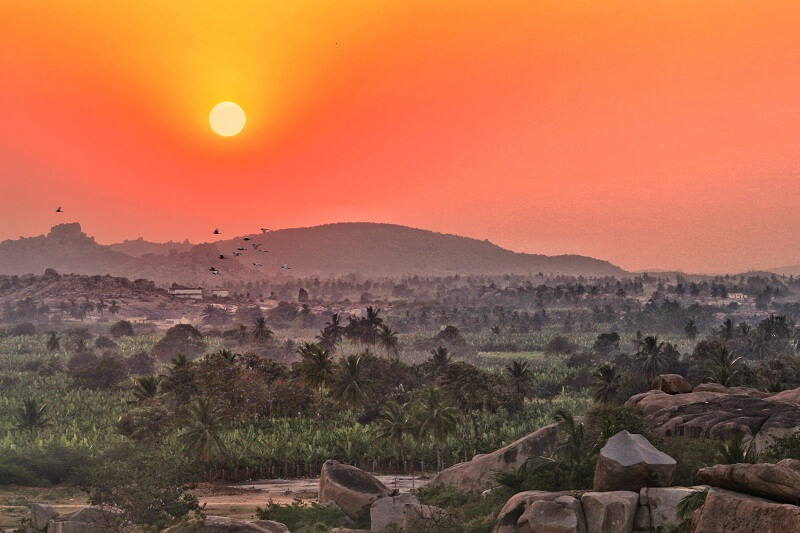
“Don’t worry, be Hampi” – I never really understood the state of mind of the person who first said this but now I know. Hampi is not plainly just any green panther, pot smoking destination whose life seemed to have been hit by a intangible hurricane but there is a corner for everyone, there is a slice of cake for everyone in this wonderland.
PIN THE POST TO READ LATER
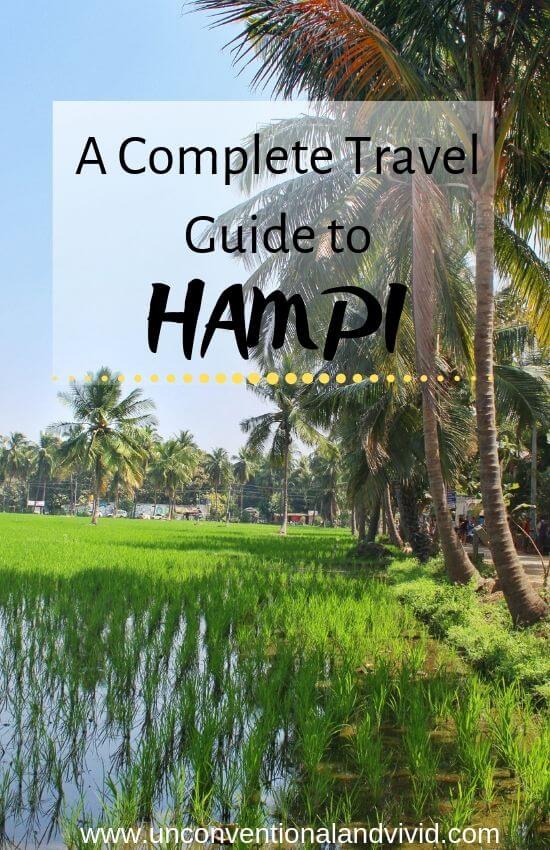
While writing this blog stitching memories from the place where time stopped, the flashes of the whimsical ruins stare me from a distance more than a thousand miles away. Let me tell you what I see!
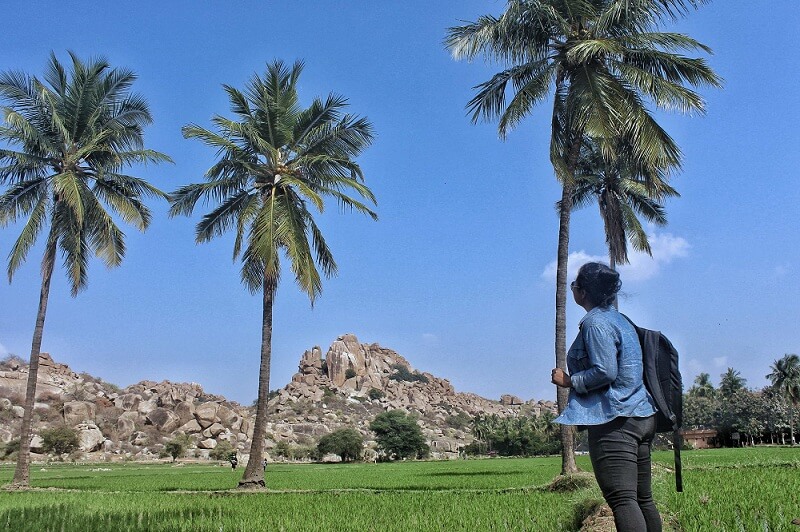
The sorcery of the ruins of Vijayangara Kingdom stretches far with boulders precariously topped on each other. The fresh green paddy fields (read almost illuminating) peppered with coconut trees are interspersed along the mammoth of boulders surrounding the town. The marvels of the ancient ruins, the phenomenal rock architecture and the reminiscence of the erstwhile capital of Vijayanagara are sliced into two halves by the sleek, shallow Tungabhadra River. The sunrise and sunset in Hampi is pure labor of nature love bestowed on the planet.
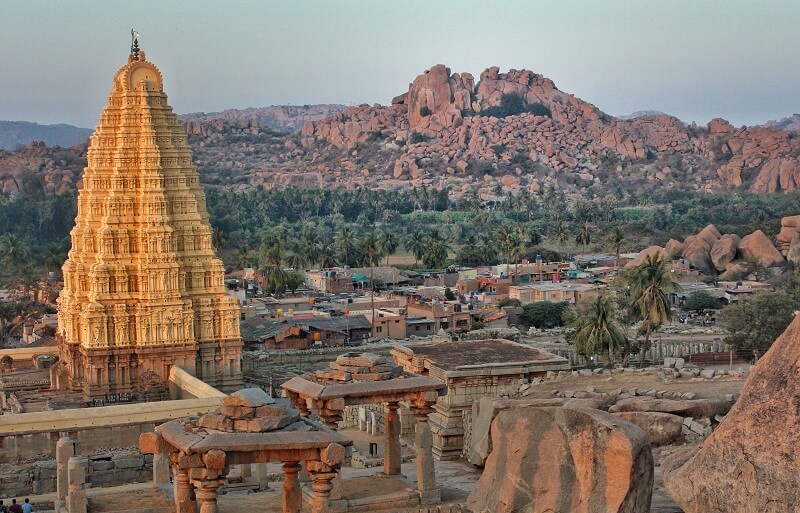
Table of Contents
Profound History of Hampi – UNESCO Heritage Site
Hampi is located within Bellary district of Karnatak. Hampi is the erstwhile capital of the Vijayanagara Empire that sprawled and ruled in the 14 th century. The city now stands true to its once bustling wealthy and grand status on the banks of the Tungabhadra River with numerous temples, architectural ruins, stone bridges, trading, green paddy fields and the bustling market. In 1500 CE, the city for its profound wealth, attracted traders from Persia and Portugal, it continued to grow till the massive empire was gutted down in defeat by Muslim sultanate.
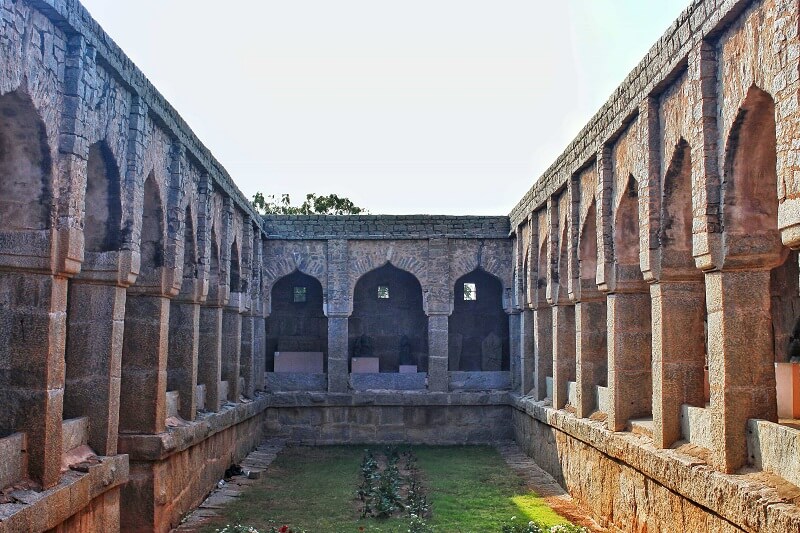
The rocky terrain of Hampi and the sight of boulders frivolously balancing on each other journeys back to stories from Hindu Mythology. According to mythology, Hampi echoes the love story of Hindu God Shiva and Goddess Parvati. Traditionally known as Pampa-kshetra named after Hindu Goddess Parvati, Pampa was she other name. She set out to marry the celibate and ascetic Hindu God Shiva meditating on the mountains and seek help from other Gods to awaken Shiva from his meditation. Hindu God of desire and erotic love Kama shot an arrow of desire to wake up Shiva, Kama is burnt to ashes as Shiva opens his third eye.
The story continues and Goddess Parvati does not give hope but retorts to meditation, asceticism and yogic lifestyle to gain his attention. At the end love wins and both get married. Hemakuta Hill in Hampi is where she pursued her yogini lifestyle according to mythology.
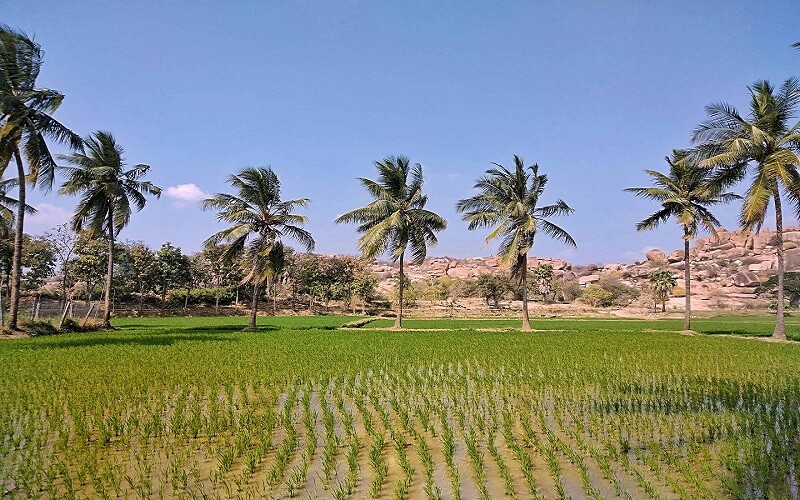
The magnificence of the Vijayanagara Empire still stands strong with the marvelous architectures, temples and monuments. The carvings on the boulders and stucco framework on the monuments beckon historians from across the world. The rich cultural heritage of the place and its stories of prosperity armed with its spectacular landscape and warm, welcoming people make Hampi a truly deserved UNESCO heritage site. Infact, the bright turquoise Rs 50 note has the stone chariot printed on it!
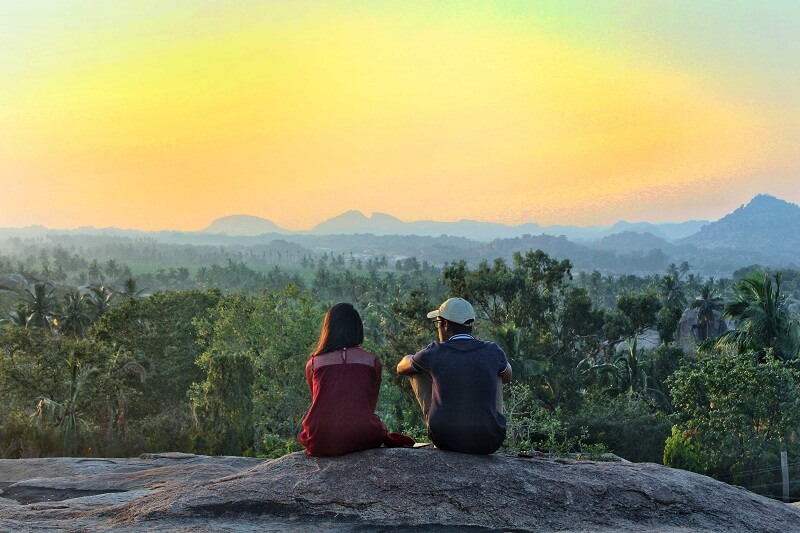
Hampi is a Feeling of Happiness
Honestly, how many places have you been to and felt channeling into a zone that carries you physically, anatomically and physiologically into freedom? This place – I swear, will crush your beast to bits and teach you to live, live free, live happy and live respecting the present, the moments, the relationships and to hold on to yourself.
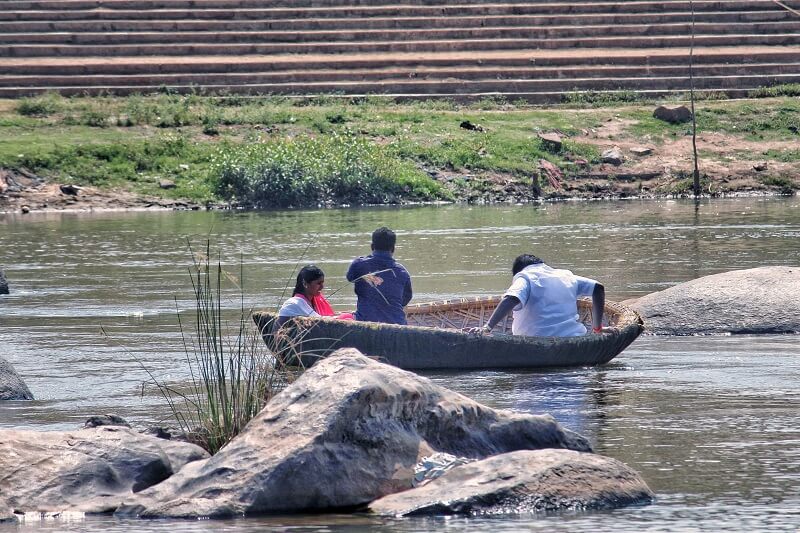
Hampi is a contrast, a side that dates back to 14 th century and beyond with the ruins, temples and the architectures expanded and built by Vijayanagare Empire. The boulder strewn landscape dotted with paddy fields and the hills bestowing gorgeous sunset and sunrise is apart from the other side by a coracle or a motor boat ride crossing the Tungabhadra River. The other side – the rise of Hippie culture in 1990s in India, stretched from Goa to Hampi, naming the other side Hippie Island. The other side is where all the cool things are – rock climbing, meditation, yoga, sound healing, tons of café.
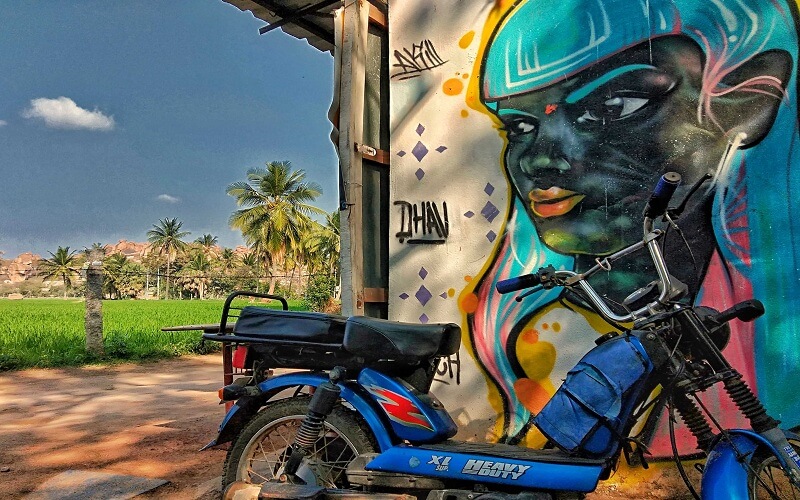
Experiences and a Travel Guide for Hampi
There is so much to experience and do beyond mapping the temples, decoding the carvings on the architecture and jumping off the boulders admiring the rock elements. It is a spiritual journey and an awakening call experienced in the charm of the old city.
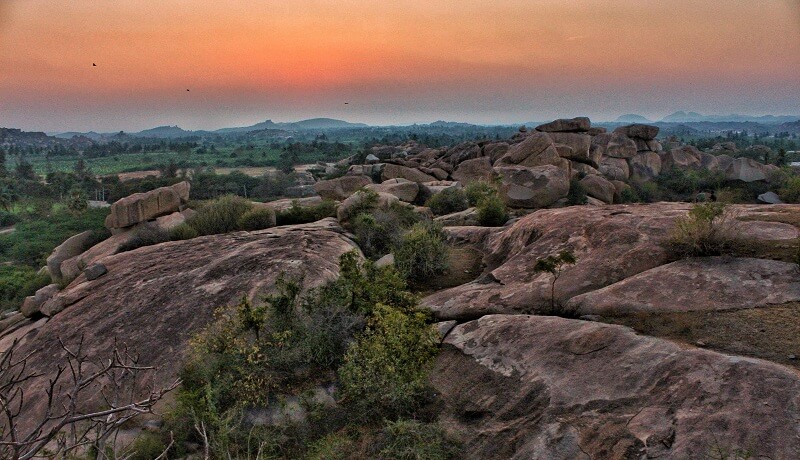
Yoga and Spirituality
Hampi is a place that let you embrace the spirituality and dig deeper into the world of yoga. Set amidst the vast expanse of paddy fields, it is a great place to get that body working and learn some yoga. There are many yoga centers and yoga classes organized in Hampi, the information about it can be found easily.
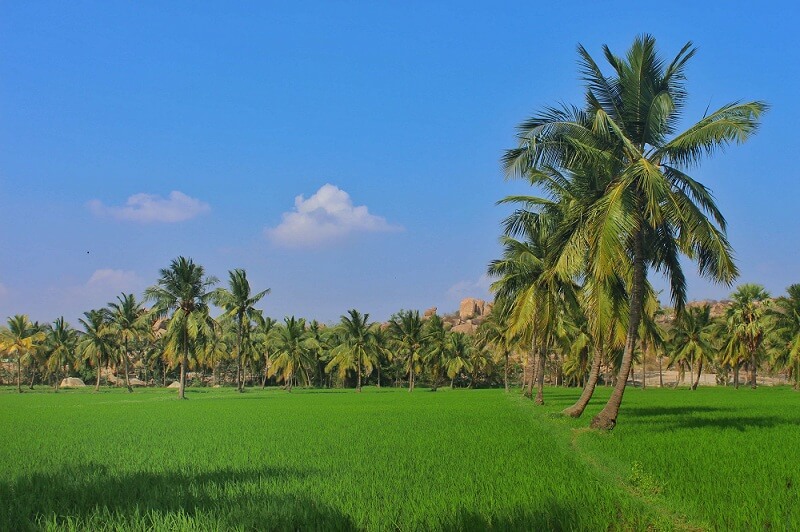
Sound Healing Meditation
This is pretty therapeutic and leads your brain to secrete more serotonin and dopamine, calming and relaxing your mind. This technique uses musical instrument in different beat and tempo to release anxiety, stress, improve blood circulation and increase concentration. What better a set up than the amazing boulder strewn, paddy field dotted landscape?
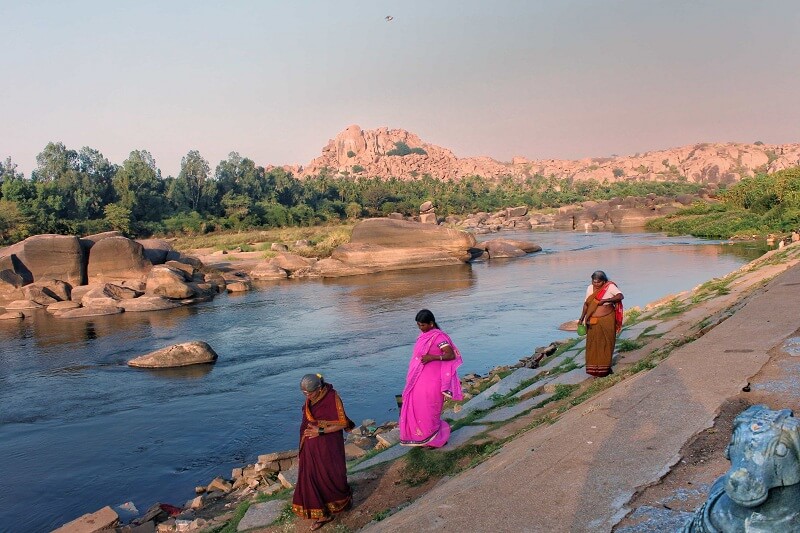

Rock Climbing
Rock climbing and bouldering is something that invites hundreds of people to the historical place from across the world. There are many professional bouldering courses and institutes where one can take up bouldering course for a month or more as well as one day course. Hampi even witness bouldering festival everywhere. I recommend Sunny’s Bouldering for learning best tricks and tactic.
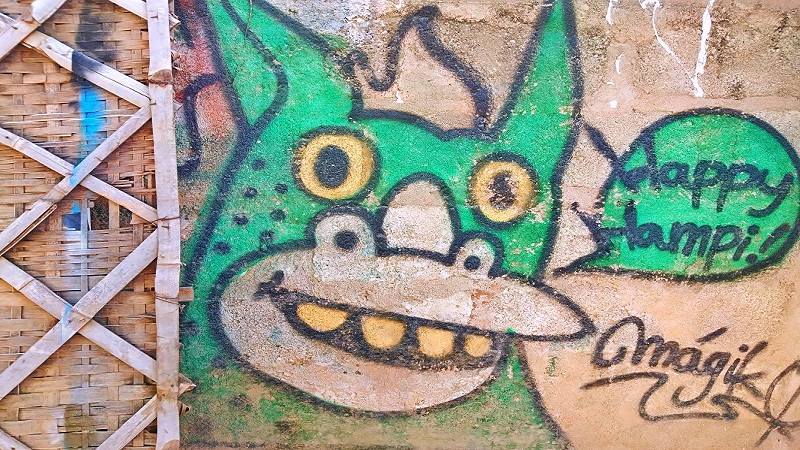
Ayurveda and Therapeutic Massage
I remember going off to sleep, slipping into my dreams, as the strong aromatic of essential oil massaged my head. Such is the power of massage that relax every nerve and vein of the body with touch of ancient Ayurvedic techniques and ingredients. A head massage roughly cost Rs 300 for half an hour and a full body massage cost around Rs 1000 for 1 hour.
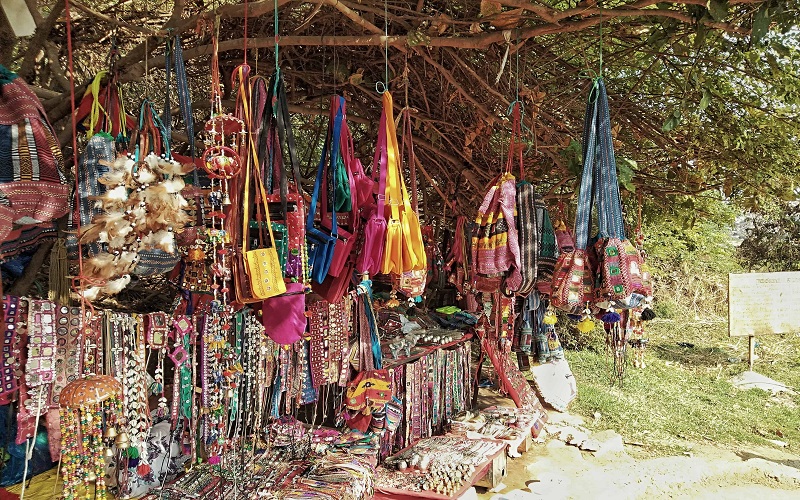
Bustling Hippie Markets
The colorful and glittering market of Hampi will walk you through Hippie land, surrounded by myriad of colors; glass work based decorative pieces and bohemian trinkets and goods. Be it boho-hippie clothes or colorful bed sheets or wall decors, the markets are definitely something not to miss. The rate depends on your bargaining skills.
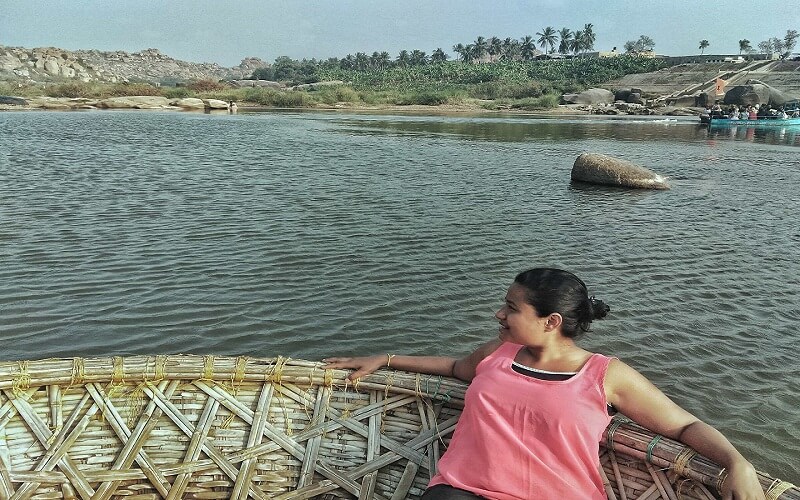
Coracle Ride
Hampi and the coracle boat goes hand in hand, a must do thing while crossing the Tungabhadra river connecting the temple side of Hampi with Hippie Island. The round, light weight, wooden boat accommodates nearly 8 people at once.
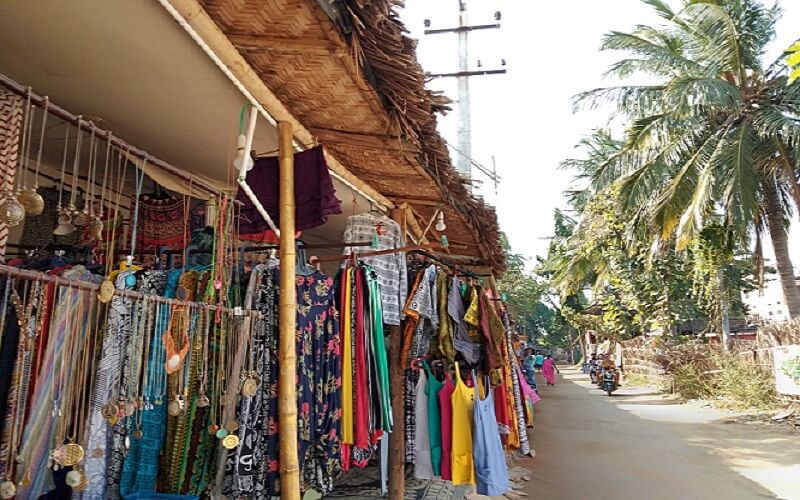
Café Hopping
The assortment of café in Hampi offers wide range of healthy food taking your taste buds to a orgasmic gastronomical experience. From mouth watering smoothies to delicious vegan sandwiches to some great desserts, the cafes overlooking the boulders and the paddy fields is a great place to chill with amazing positive vibe.
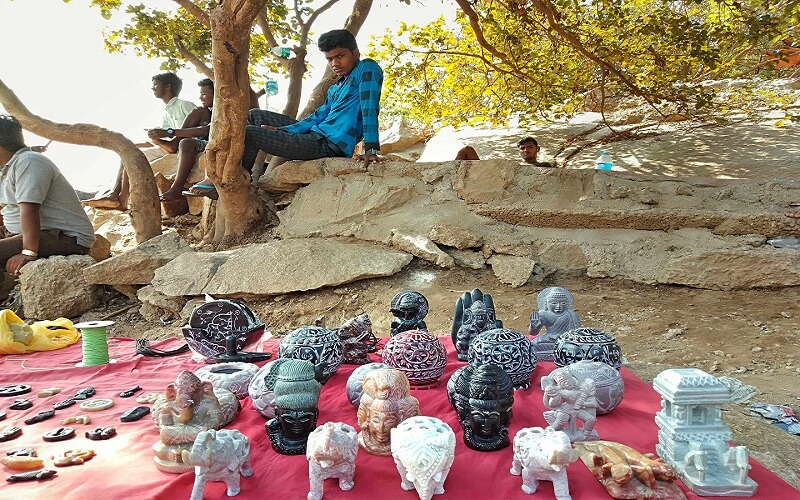
Places to Visit in Hampi
Explore the ruins – temples & monuments.
Amidst the ruins of Hampi, echoes the voice of bygone era guarding the reflection of the mighty kingdom. The temples, monuments, stone bridges and everything medieval witnessed a majestic empire crushed by the Sultanates, and yet immortalized the celebrated Vijayanagara Kingdom. The UNESCO heritage site of Hampi has a number of temples and monuments. This travel guide for Hampi covers all the important monuments of the city.
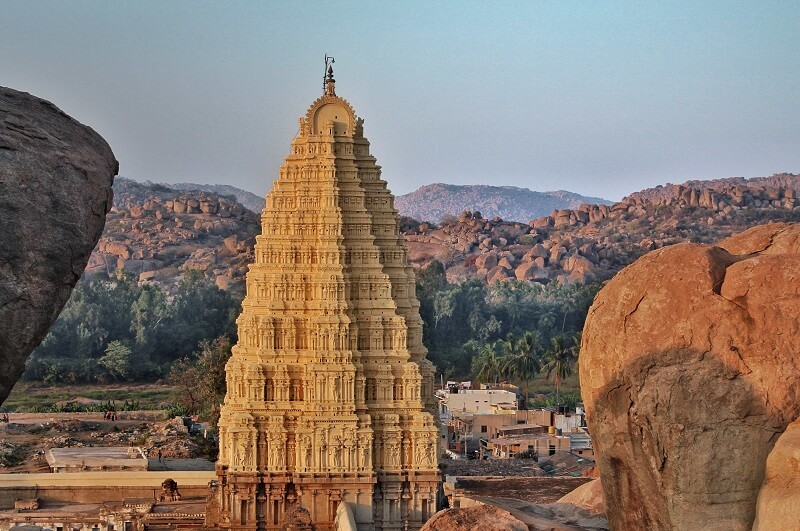
Virupaksha Temple
This temple cannot be missed and is a place that is almost visible from every corner of main town. It is the oldest temple that was built in 7 th century AD. The temple is nine storied tower tapering from bottom to top architecture painted in pastel. The stone carvings and the stucco figures on the temple outer wall even include some erotic figures. The pillars of the main temple complex are carved delicately with intricate designs. The use of mathematical symmetry to architect the temple makes it pretty interesting. There are shrines, pillared halls and courtyards within the sprawling temple campus. The murals on the central pillared hall dates back to art form from Vijayanagara era. The sanctum consists of an idol of Lord Vishnu.
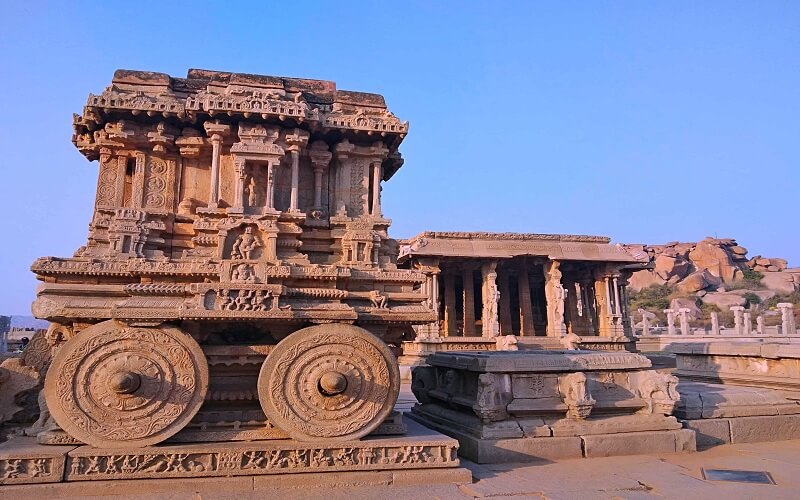
Vittala Temple
The ancient Vittala Temple is an example of unmatched architecture and is one of the largest groups of monuments in Hampi. The iconic monumental structures in the complex of the temple are a delight for history lovers and photographers. The Stone Chariot as seen on the Rs 50/- note and musical pillars are on the grounds of the Vittala temple. The temple complex was built in the 15 th century by King Krishnadeveraya and is dedicated to Lord Vishnu.
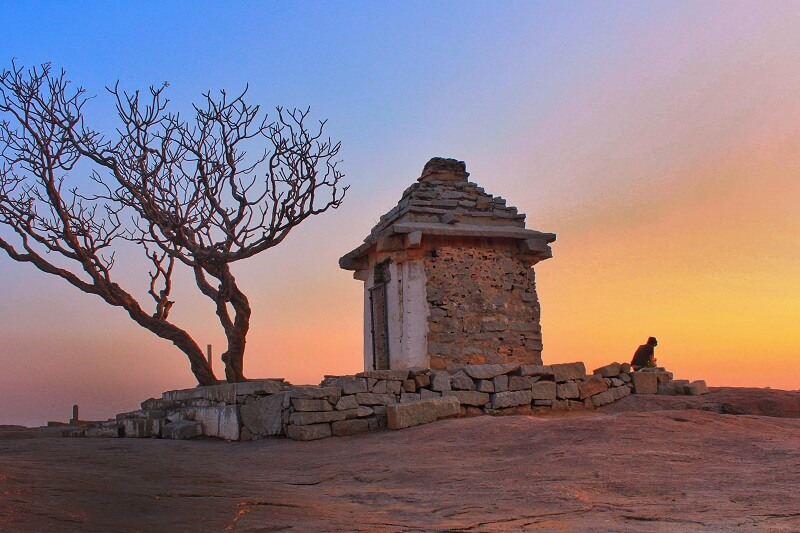
The vast complex of temples and marvelous monuments has three gopuram surrounded by many shrines and pillared halls with elaborate stone carvings. The stone chariot is the quintessential reflection of stunning architecture and craftsmanship that existed during the rule of the empire. The stone chariot is a shrine dedicated to Garuda – the chariot that carried Lord Vishnu. The Ranga Mantapa has 56 musical pillars which are known to play musical notes when tapped gently. They resonate the sound played on instruments.
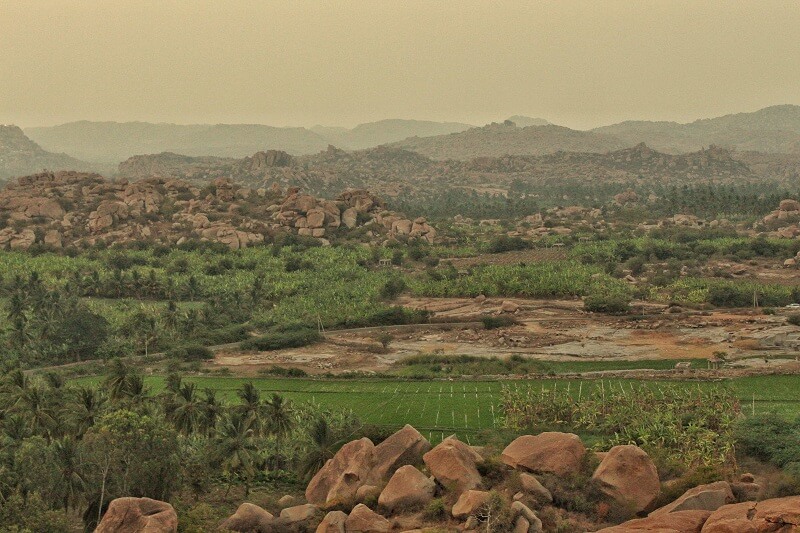
Hanuman Temple
The white washed temple carved out of a rock is perched on the Anjaneya Hill, known as the birthplace of Lord Hanuman. Putting behind the flat lands of Hampi, zigzagging all the way up climbing 500+ steps, brings to you the small shrine of Rama and Site inside the rock carved Hanuman temple. There is a icon of Hanuman carved meticulously on the rock. The best time to visit the temple is for sunset when the sky is a enticing phenomenon – shades of orange and yellow paints the canvas adding a splash of magic to the rectangular blocks of paddy field. The glimpse of Tungabhandra river amidst the boulder strewn landscape is stunning. But, the monkeys are always on hunt for something to snatch away, be careful.
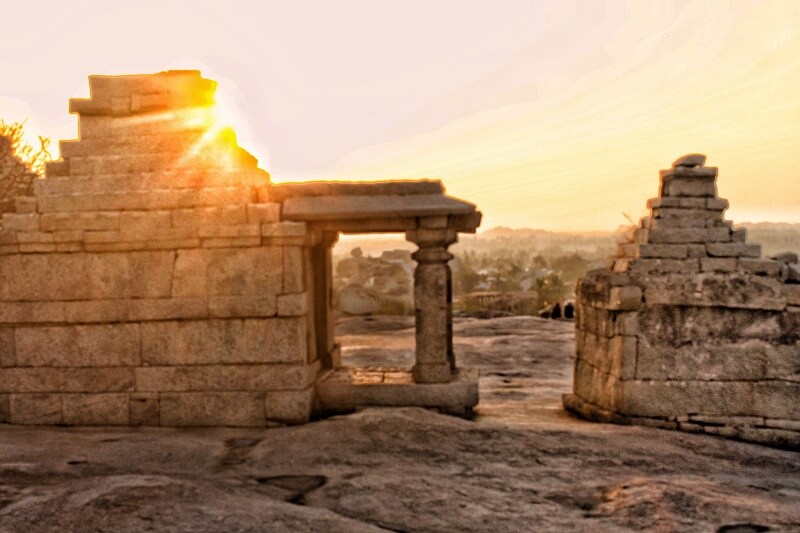
Hemakuta Hill Monuments
The Hemakuta hill is behind the Virupaksha Temple bestowing with spectacular view of the far stretched horizon. The hill adorns the ruins further with cluster of temples, small and big, archways and is home to a number of shrines built by Vijayanagara Empire. The boulders balance perfectly against each other across the spread of the hill. Hemakuta translates into “Hill of Gold” that got its name from mythology weaved to it. According to folklore, Lord Shiva consented to marrying Pampa impressed by her dedication and yogini lifestyle, which led to raining of gold on the hill. It gives an elaborate sunset experience with view of Virupaksha Temple on one side and the magic landscape of Hampi on the other.
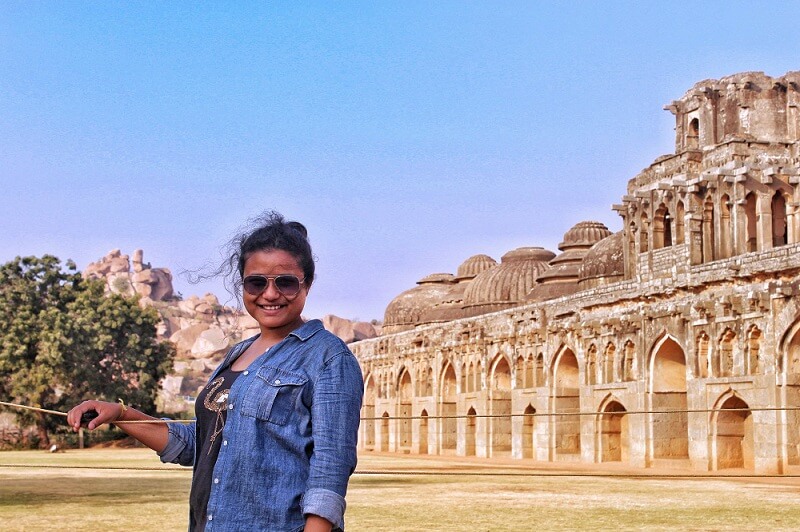
Elephant Stables and Zenana Enclosure
The Zenana Enclosure is a walled compound influenced by Indo Islamic style of architecture and was the royal women’s quarter. The area was built secluded only for the royal women of Vijayanagara women. The enclosure had four watch towers and well guarded during the reign of the Kingdom which protected the ladies including the Queen. The only male who had the right to visit the place was the king to meet his queen. The Lotus Mahal is the main attraction with domed structure that resembles lotus bud and archway resemble lotus petals.
The Elephant Enclosure is located close to Zenana Enclosure and is a long 11 dome shaped chambers stretched at length. It was the place to keep the royal elephants and the domes have alternating pattern of designs. Each of the halls had small manhole for the mahout to enter the compartments to park the elephant.
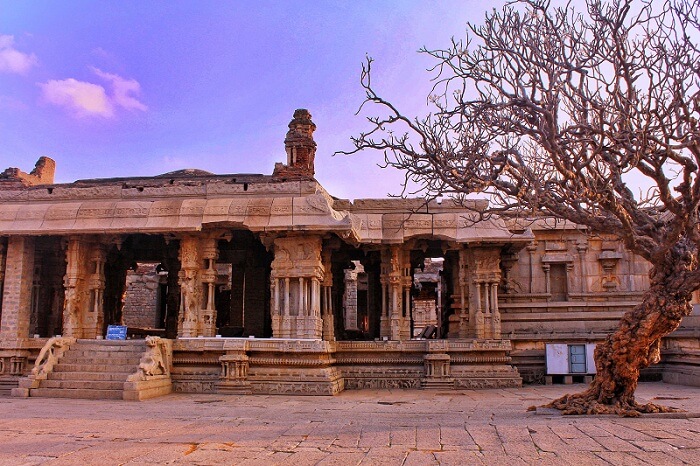
Achyutaraya Temple
The magnificent temple was built in the year 1534 AD and is located between Matanga Hills and Gandhamadana. The majority part of the temple is now in ruins subjected to attacks by Bahamani Kingdom. The temple is dedicated to Lord Vishnu and ruined market place of the temple complex sit secluded amidst the valley tucked between two hills.
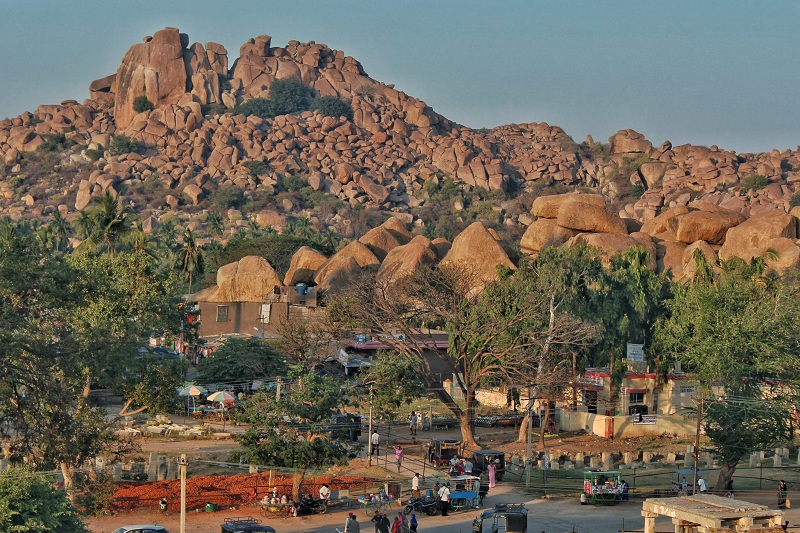
Take a Trip to Anegundi
Anegundi was the first capital of Vijayanagara Kingdom and has a lot of historical significance. The quaint village is surrounded by hills on three sides and one side blessed with the Tungabhadra River. The village adds to the nuances of mythological stories passing on from one generation to another. It was called as Kishkindha (story straight from Ramayana era), rule by evil brother of Sugriva, Bali. The medieval city was brought to justice after goodness won over evil as Sugriva defeated Bali with help of Lord Rama. There are many temples and historical monuments well preserved in the village. Travel back in time as you witness the world from one of the oldest plateaus of the planet or follow the trails of traditional art reflected by Anegundi fort.
Don’t miss the stall selling Chicken Pakora and Eggs at the entrance of the medieval gate leading to the village.
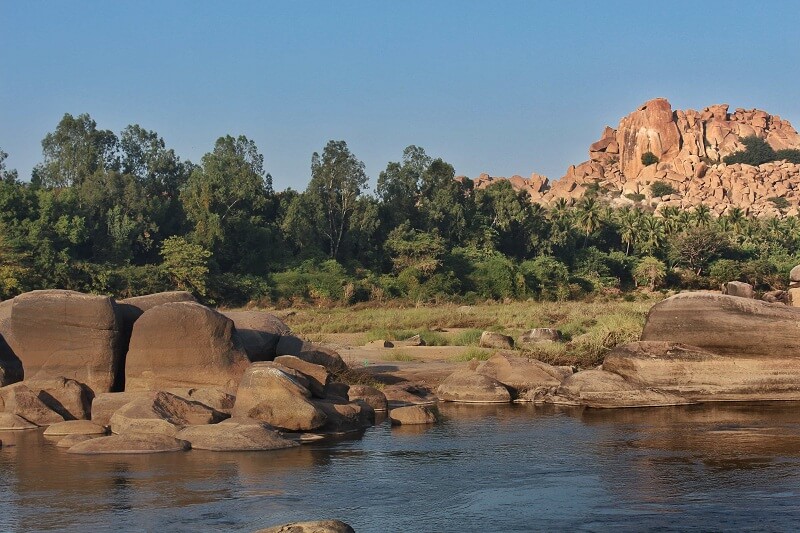
Enjoy a coracle ride at Sanapur Lake
Sanapur Lake is around 7 to 8 km from Hippie Island and can be reached easily by a scooter ride or by renting a auto or Tuk Tuk. The drive through the lush green paddy fields is full of amazement drooling at the boulders topped on each other. It almost reminds of a childhood game “Pitthu” where one team tried to break the piles of stones placed on each other and the other team put it back together. This almost looks like giants have put the boulders on top of each other and returned without completing the game. Sanapur Lake is a good for a coracle ride, some even swim, in fact the road to the lake is pretty picturesque.
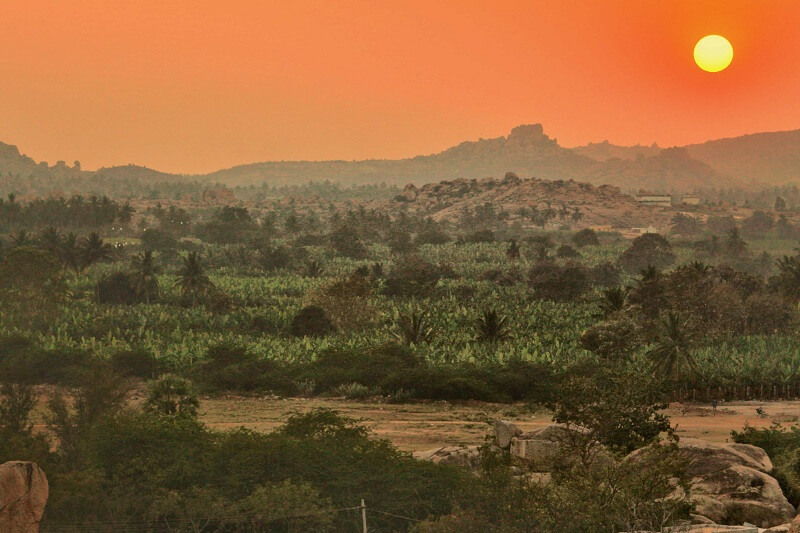
Climb the hills – Sunset & Sunrise
Hampi is instrumental to delighting your soul with some of the most prolific sorcery of nature. There are many hills in and around Hampi that you can climb to enjoy the surreal landscape of Hampi. Matunga Hill is one of the best places to witness the sunrise. I would say for sunset visit the Hemakuta hills and transcend into wonderland as you witness the phenomenon of sun drowning amidst the clouds, slowly to vanish, leaving behind a trail of colors on the blue canvas of sky. The colors perfectly blend with the coconut tree dotted paddy fields of Hampi.
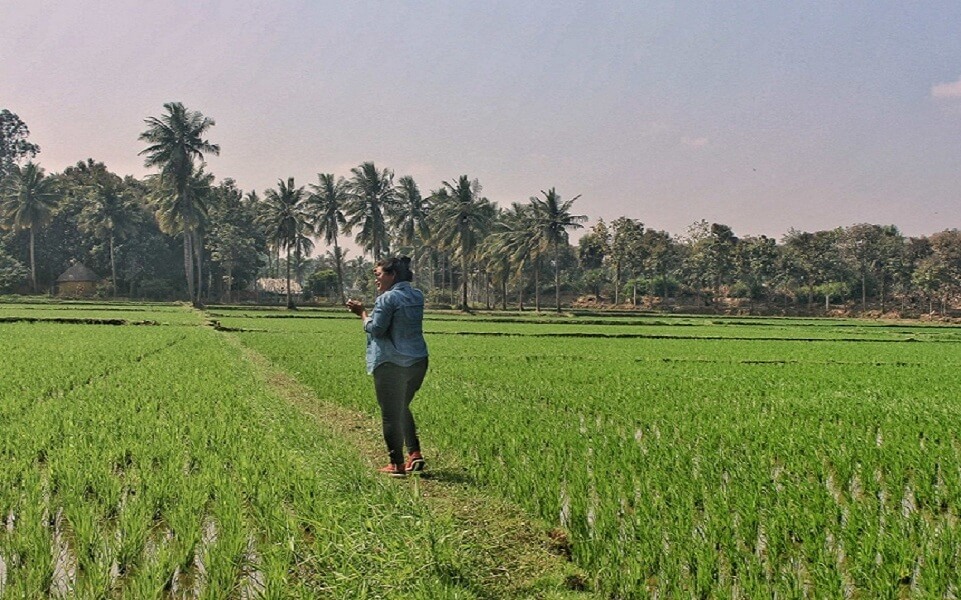
How to reach Hampi
Assuming Bangalore or Hyderabad or Goa as your base, there are trains and buses that leaves for Hospet at night every day. The trains are pretty convenient and can easily book using the official website . Hospete is around 12 To 13 km from Hampi, either you can take a local bus from outside the railway station for Rs 20/- or hire an auto for Rs 200/-. This travel guide for Hampi is aimed at helping with all information about how to travel to Hampi.
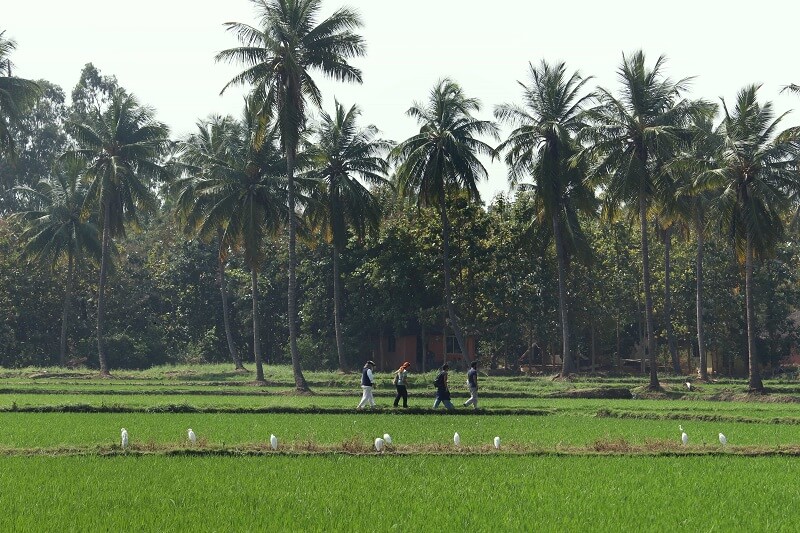
Hampi Accommodation and Food
There is plenty of accommodation in Hampi on both sides of the river. The temple side has slightly cheaper accommodation than Hampi Hippie Island. I would recommend you stay in Hippie Island, to be close to nature and the boulders. As you cross the river and walk inside Hippie Island, there are a number of guest houses and hut styled accommodation available. The price generally starts from Rs 600/- to Rs 1500/- depending on the type of place.
Do not book your hotel beforehand because you will find plenty of accommodation in Hampi. I highly recommend Goan Corner if you want to stay a little away from the crowd.
Food is not very cheap in Hampi as compared to many places but an assortment of delicious food is available in all cafes. A fruit bowl would cost around Rs 150 to 200/-, pizza costs around Rs 450 and above, breakfast plate starts from Rs 150/- and beyond. Most of the food in a café generally are priced above Rs 150/-. The cost of a beer is around Rs 200 to 250/- and other hard liquor starts from Rs 150/. However, the road side stalls are cheaper and prepares tasty South Indian food.
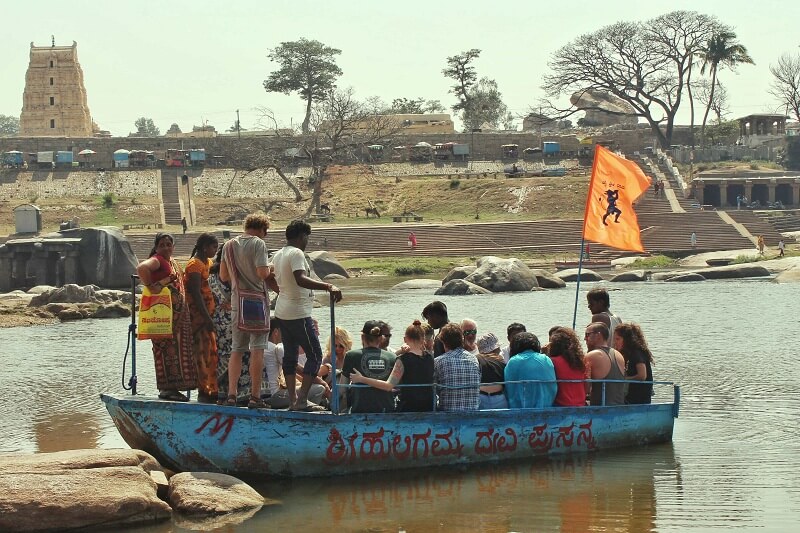
How to Explore Places Around Hampi
There are three ways you can explore in and around Hampi.
- There are rental bikes available for Rs 350 to 400/- in the hippie Island side. However, you cannot drive the bikes in the Temple side. You are free to go to Hanuman Temple, Anegundi, SanapurLake etc. using the bike.
- On the other side, you can explore the temples either by booking a bicycle tour for Rs 600/ – or beyond or by hiring a auto (Tuk-Tuk). An auto guy will charge around Rs 2000/- for a full day tour. You can contact Orange (Name of the driver) for a day tour at – 8277266756, good, reliable and funny guy.
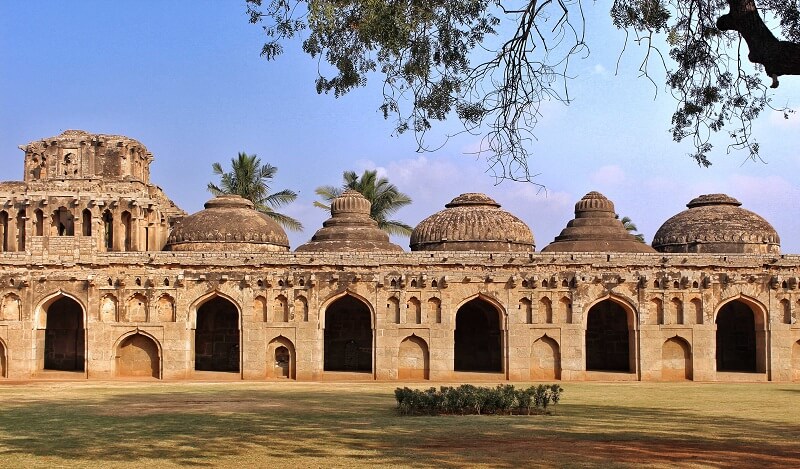
Important Things to Know Before Visiting Hampi
- Try to carry cash because the cafes usually do not accept cards. There is no ATM in Hippie Island and the nearest one is in Anegundi. However, you can withdraw cash by swiping card in one of the shops in Hippie Island for a chargeable amount.
- The last timing for the motor boats is around 5.30 pm and anything later than that means paying off extra money to cross the river. The boats charge Rs 50/- per person for every boat crossing. The coracle charge around Rs 80 to 100/-.
- The markets are really colorful and are a gateway to shopping many bohemian decors but make sure you bargain right.
- Hippie Island side does not have really good internet connectivity especially towards the guesthouses on the further end. Wi-Fi connection is good in some of the cafes though.
- The best time to visit Hampi is from October to March when the weather mellows down a little.
Planning a Trip? Pin the post for a complete travel guide for Hampi
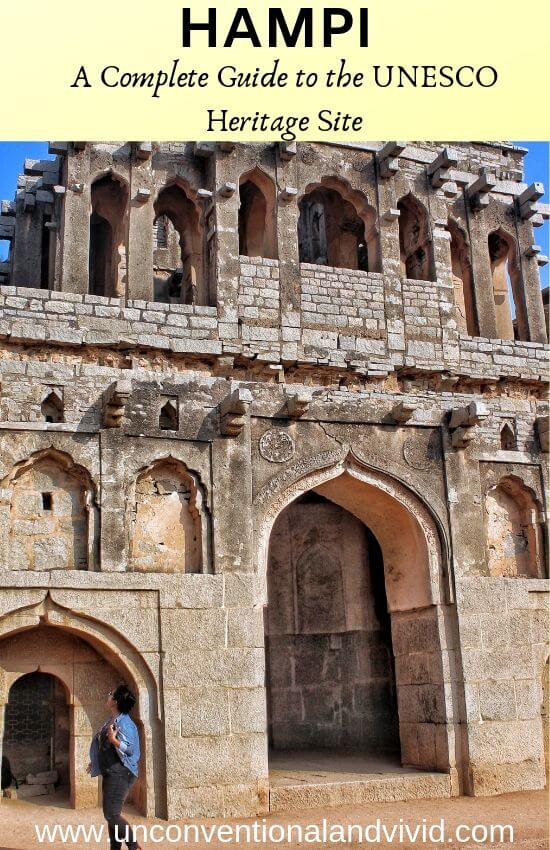
Hampi is a feeling that I have carried with me, I feel the breeze softly patting my face and close my eyes to surround myself with paddy fields and boulders. This exhaustive travel guide for Hampi will answer all your questions about this gorgeous place.
Email address:
Also you can read my complete guide to Thailand here.
Share on Social Media:

- Share on Tumblr
Tags: A complete travel guide for Hampi Hippie Island Hampi Offbeat places to visit in Hampi
10 Responses
- Comments 10
- Pingbacks 0
I keep reading certain parts of this and smile like a fat kid when he sees cake. So thankful to experience this place with you. An excellent write up, you rock!
Thanks for reading and truly, Hampi is magic. I too had a big smile while writing the blog. Good memories 🙂
Lovely read..bookmarking it for reference..keep posting girl
Thanks Mayuri! I am glad you loved reading the blog. Hampi is definitely a magical place.
Wonderful comprehensive post – a handy guide for all Hampi visitors!
Thanks a lot of reading. I am glad the guide could come handy. 🙂
So many beautiful places to see here. Thank you so much for this post as Hampi hadn’t been on my list to visit in India. It is now!
Wowzers! That’s one incredible sunset! Really unusual colour combos, like a desert, except it isn’t!
Great guide! I am hoping to head back to India soon and would love to check out Hampi – this will definitely come in handy.
Hampi sounds incredible. Temples, ruins, beautiful sunsets, and a hippie vibe… I love it all!
Leave a Reply Cancel reply

I am Upasana Kakati. I am an avid traveler, teacher, travel blogger and dreamer. I love uncovering hidden gems and exploring places that offer cultural and perspective per se. I am from North East India and currently making my way to offbeat destinations in North-East and rest of the country. I started this travel blog to pursue my passion for writing, keep the side hustle on and share my travel experiences. As of now I do not have any plans to quit my job to travel full time because I love financial security to a point. But, no one knows what tomorrow has in store.
Never miss a travel story – Subscribe
Leave this field empty if you’re human:
Follow on Facebook

9 Best Things to Do in Hampi & Important Travel Tips!
By: Author Sophie Pearce
Posted on Last updated: August 17, 2023
Categories HAMPI , INDIA
This post may contain affiliate links. Please see my disclosure policy for details.
Are you looking for all the incredible things to do in Hampi? Then keep reading! Hampi is such an adventure!
You’ll be transported to a world of ruins, ancient palaces, stone carvings, palm trees, monkeys, and giant Ganesh statues.
It’s quite a crazy place and well worth exploring if you find yourself in the Indian state of Karnataka.
This site is the birthplace of Hanuman, the fighter monkey god in the Hindu religion. He likes to play tricks and features an integral part of the Ramayan epic legend.
So, naturally, you’ll find a tonne of monkeys who wander around waiting for banana offerings. You’ll need at least a day or two to explore as there is quite a lot to do and it’s spread across a wide area.
Here’s my complete Hampi travel guide and the best things to do in Hampi!

How to reach Hampi in India
Hampi is in the north of Karnataka and, unfortunately, there are no direct flights which will deliver you here.
So, your best bet is to hire a taxi, take the train or bus from the main cities of Bangalore, Hyderabad, Goa , or even Pune.
If you’re heading here by car from the cities, it’s a mammoth of a drive along a pretty terrible stretch of country roads.
If you’ve ever been on long drives in India, the roads are a mix of really great open highways to narrow lanes with potholes and large lorries to take over!
So, although Google maps will tell you a time, add another 2 hours onto that to be safe.
If you’re taking the train there is a Hampi express train which runs overnight from Bangalore. For more information on this and the schedule, see here.
Click here for more Indian train travel tips

How to travel around and explore Hampi
Hampi is spread across a massive area and so depending on your level of fitness or more importantly how you handle the heat you’ll have to decide how you want to explore it.
When I went to Hampi, it was the Indian winter season.
Although it was only 34 degrees, which is nothing compared to the peak temperatures of summer, it was HOT!
Hampi is mainly sand and stones which all absorb the heat. They then radiate it, which makes the place seem 10x hotter than it is on the thermometer.
That’s why when it does hit peak summertime, Hampi closes down.
You can still wonder about it obviously, it doesn’t disappear! But, there won’t be any restaurants, tour guides etc. So, best to visit in Winter between November – January.
If you’re like me and love your air conditioning, I would recommend hiring a taxi to take you about with your tour guide. That way, you can avoid being in the relentless heat for the day.
If you’re made of stronger stuff, I would hire a bike to explore or go on foot.
Some of the main attractions are quite close together and there are some great designated walks to follow.

The best things to do in Hampi
1. virupaksha temple or main temple.
The first place to head is to the main temple in the centre of Hampi.
Locally known as the Virupaksha Temple, it has a massive stupa with some pretty saucy carvings of the Karma Sutra.
Why do you need sex ed classes when you can just study here, right?! Haha.
You will need to walk around barefoot and there is a shoe counter to store your shoes in for 2 rupees.
But, as this is an old temple, the floor is pretty tough on your tootsies. It’s hot, oily (it felt so gross *shudders*), sticky and there are little stones everywhere just waiting for you to tread on. So, go carefully.
There are A LOT of monkeys who cause havoc here as they are looking out for pilgrims offering bananas in the temple. So, keep an eye out for mischief. Don’t carry food with you and don’t leave valuables on display.
You can get a blessing from the Laxshmi elephant or have a look inside at the priests burning incense to the gods. A great place to look around.

2. Admire the EPIC view from Virupaksha viewpoint
Just up the stairs from the main temple is an amazing viewpoint that looks like something out of Bedrock in the Flinstones!
This is a great place to visit at any point of the day, but best at sunset for an incredible view of the city and beyond.
You can also head to the big Ganesh statue from here if you head up the hill and through the caves.

3. Visit Sasivekalu Ganesha statue
I’m not sure if it’s a ‘thing’ to have a favourite god, but my favourite is Ganesha.
The remover of obstacles and all-around giver of good luck, what’s not to like?
In Hampi, there are two massive single stone carved Ganesh statues that you can visit and they’re insanely gorgeous!
The first is called Sasivekalu Ganesha which is on an open pavilion. This Ganesha has a snake as a belt when he ate too many sweets!
This was also a statue for the common people to worship back in the day and was a gift from the Raj.

4. Kadalekalu Ganesha
The second statue is the Kadalekalu Ganesha which is inside an ancient temple. It is absolutely humungous!
It’s one of the largest statues which has been carved out of a single stone and was a private statue for the King and Queen to use for worship.
You have to remove your shoes to go inside and it’s still an active temple today.
I accidentally lost my step here as it was so dark and nearly face palmed a woman heading in. So, be careful!
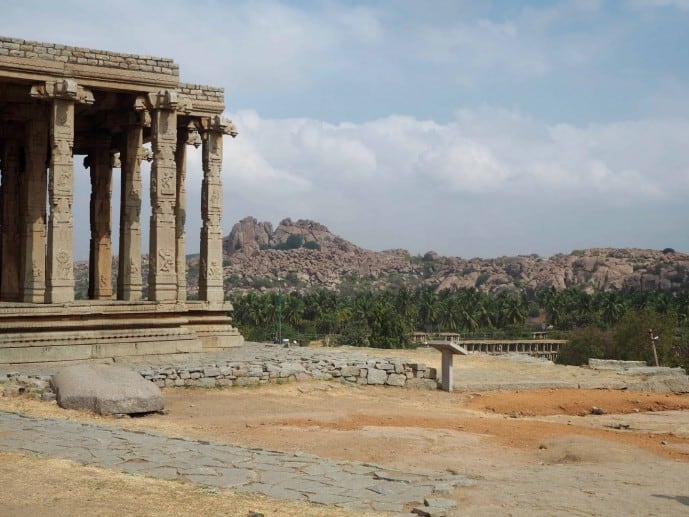
5. Hazara Rama Temple
The Ramayan quite literally means the story of Rama, a Hindu deity. The infamous story of Rama who went to rescue Sita from the clutches of Ravana is a popular tale.
Hampi has numerous shrines dedicated to Rama as it’s the birthplace of Hanuman, who helped him with his army of monkeys.
The ruined city features in the legend and so there are numerous temples dedicated to them.
The Hazara Rama temple has some of the best carvings depicting the numerous chapters of the Ramayan legend.
Your guide should be able to translate for you and point out highlights on the panels.
What’s even more amazing is this temple was built in the 15th century for the Kings and Queens of Vijayanagar.
Although some parts have been reconstructed, it still has an ancient feel as you wander about.

6. Hampi Stepwell
Hampi stepwell and the ancient kingdom it resides in are pretty awesome to take in.
As you walk around and your guide describes the parties, traders, and armies who used to reside here, you can let your imagination go wild and picture it.
Although most of the city is in ruins, a lot of the infrastructure still remains.

7. The Hampi Lotus Temple and Elephant Stables
Possibly my favourite location in Hampi was the Lotus Mahal. The symmetrical petal archways were just so beautiful to look at.
The temple was made for the royal ladies of the time for dancing, gossip, and recreation.
Miraculously, it has hardly been damaged since it was originally constructed.
The gardens surrounding this temple are so lush and green and I loved the colourful flowers. It made a really beautiful setting; pity I couldn’t pull up a picnic here!
The elephant stables are what it says on the tin. Located in the Royal Centre, they used to act as the home for the royal elephants while they were here. Today, it’s a nice open area to explore with beautiful arched roofs.
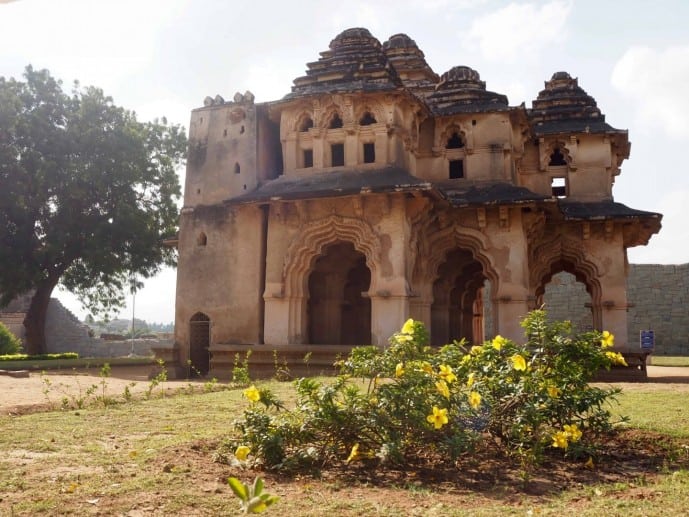
8. Lakshmi Narasimha statue
An imposing figure tucked away in the jungle of Hampi, the Lakshmi Narasimha is the largest monolith statue in Hampi and depicts one of the 10 transformations of Lord Vishnu and Goddess Lakshmi.
It’s one of the most popular statues to visit and so will be packed with tourists at all times of the day.
Be sure to also check out the Shiva Lingham which is located next to it.
My tour guide told me that I should throw some rupee cents onto the Lingham for good luck with fertility.
If you get it on the bottom part, it’s a 50% chance of success, and if you get it on the top 100%! I got it on the bottom, so fingers crossed haha!

9. Hampi Stone chariot
The stone chariot is by far the most impressive excavation site of Hampi.
It’s the flagship tourist attraction and the reason why most people are drawn in to take a visit.
The chariot is not just a statue but actually a temple that is dedicated to Lord Vittala, another aspect of Lord Vishnu.
It’s an awesome place to wander around and get your classic super tourist picture by it!

Save this list of things to do in Hampi for later!
There is honestly so much to do in Hampi that you will need at least a few days to get around all of it.
I couldn’t believe my eyes when I got here. It was miles and miles of boulders, palm trees, ancient temples, and palaces.
You really feel like you’re on an adventure or stumbled into the ancient times of India.
If you haven’t thought of visiting Hampi yet, I would put this on your list. If you’re not convinced, here’s some more Hampi travel wanderlust.

Where to stay in Hampi | Hampi Hotels
There aren’t really any luxury hotels which are in the city of Hampi itself, but I would highly recommend the Orange County Resort which is located a few kilometres away.
The stay included breakfast and an outdoor jacuzzi, I was in heaven!
You can check available dates and rates for Orange County here

Heading around the south of India? Read more of my articles!
Goa beyond beaches guide
A first-timers guide for Mumbai
My one week in Kerala Itinerary
Things to do in Fort Kochi
Places to visit in Munnar
Amazing things to see in Alleppey
A guide for the Kerala backwaters
The best Munnar tea plantations
A complete guide for Pondicherry
Visiting Auroville from Pondicherry

Thursday 9th of July 2020
Amazing blog! Interesting post, beautiful pictures, A very detailed, inspiring and informative post.
Sophie Pearce
Hi Bharat, thank you for your kind words. I'm glad you liked the post! Hampi is a gorgeous place in India. Sophie x

Hampi Travel Guide
- July 19, 2021
If you are looking for advice on how to reach Hampi. If you are looking for information on Things to do in Hampi, Hampi Hotels, Hampi Sightseeing, Travel Tips. Or if you are looking for information that will help you plan your Hampi trip then this article is for you!
How to REACH HAMPI
By Plane : The nearest airport is at Vidyanagar (45 Kms), which operates daily flight from Bangalore and Hyderabad. Check Trujet website for more details. We also have airports at Hubli (143 km – 5 Hours), Bangalore (360 Kms – 7 Hours) and Goa (360 Kms – 8 Hours)
By train: The nearest railway station is Hospet Junction ( IR station code: HPT ), 13km away. Overnight trains run several times a week from Bangalore, Hyderabad and Goa. From Hospet train station it is very easy to hop on a local bus which goes between the railway station and the main bus station and onward to Hampi (same bus). If you don’t want to wait then you can also get an Auto Rickshaw to take you to Hampi (INR 300 – 350). Your booked hotel would be happy to arrange a pickup for you, please check with them. If you book with us then we will arrange the same.
By bus: Karnataka State Road Transport Corporation operates daily buses to Hospet from Bangalore, Goa, Mysore and Gokarna. Book your tickets in advance if you want a coach or an air-conditioned service. There are private bus companies operating buses on these routes too, in addition there are buses from Pune & Mumbai. From the bus station or drop point you can arrange a tuk-tuk or a car for transfer to your hotel.
By Road: You can hire a cab from one of these cities or drive down yourself. If you are booking tours/accommodation with us, we would be happy to arrange a pickup from any of these cities as well. Please contact us for assistance or more information.
- Bangalore: 350 km / 7 Hours
- Hubli: 150 km /4.5 Hours
- Hyderabad: 360 km / 8 Hours
- Pune: 560 km / 11 Hours
You can browse our blog section for more information like various ways available to a traveller to reach Hampi from Goa or Bangalore .
Bangalore to Hampi – Everything You Need to Know
Mumbai to hampi – everything you need to know, where to stay in hampi.
Hampi is a UNESCO world heritage site, as a result of which commercial activity within the core zone is heavily regulated. Which is why most licenced accommodation options are outside the core zone. Before you book your stay, it is important to know where your hotel is located and how far it is from Hampi’s main attractions.
In this article we have listed the different areas within Hampi and accommodation available here. For our recommendations on places to stay you can refer to the below article.
10 Top Hampi Hotels for Every Kind of Traveller
Janata Plot : Is as small shanty town next to the Virupaksha temple in the heart of Hampi village. This is the last surviving commercial area within Hampi village, most others have been demolished or moved to a different part by the government authorities. Here you will find budget accommodation in form of guest houses. Rooms here are simple and comfortable. If you are a budget traveller who will be spending most of your time out exploring then this could be a good option. The location is a big plus because you are close to the center of Heritage sites in Hampi. No alcohol or Non Vegetarian food is served in this area due to its proximity with Virupaksha Temple. The area is under litigation so their status keeps changing, so check with the property owner before you book.
Virupapura Gaddi / Hampi Island / Hippie Island : This is an Island on Tungabhadra river, and is connected to Hampi by a ferry boat (or 30 Km route by road). It is partly agricultural, partly forest land and it comes under the protected core zone of Hampi. This area has the highest density of guesthouses near Hampi, set amongst paddy fields and along the river. If you are a budget traveller and would like to spend some time relaxing amongst beautiful surroundings then this is a good option. This is also a good option if your looking to go boulder climbing.
Kadirampur / Prakash Nagar / New Hampi : Some of the displaced residents from Hampi Bazaar have been allotted government land in nearby villages. Here they have started to build guesthouses and restaurants. Some have started calling this place “New Hampi”. This area is a 15 minute autoride from Hampi. Another convenient location for budget travellers.
Kamalapura / Malapanagudi : Just beyond the core zone of Hampi are villages of Kamalapura & Malapanagudi. You can find a variety of properties here. Standard category properties like KSTDC’s Mayura and Clarks Inn Hotel. Premium category properties like Heritage Resort Hampi and Jungle Lodge’s Wilderness Resort. Luxury world class property like Evolve Back Resorts. All of these are within 5 to 8 Kms from Hampi.
Anegundi : This is a heritage village located on the northern bank of Tungabhadra. It is connected to Hampi via a ferry across the river at Talwar Ghatta boat point (Close to Vittala Temple) or alternatively it is 22 Kms by road to hampi. If you want to immerse yourself in the cultural heritage of Hampi through its people, then this is a good option for you. You live amongst people in guesthouses or homestays, away from the mad tourist traffic but fully immersed in life of an idyllic Indian village. The Kishkinda Trust (TKT) operates few properties here.
Hospet : This is the main town located 15 kms from Hampi. There are several properties catering to all kinds of budgets. This is where most visitors to Hampi choose to stay for its affordability and options. You can choose amongst Royal Orchid Hotel, Mallige Hotel, Krishna Palace, Priyadarshini Pride and many others
THINGS TO DO IN HAMPI
Most visitors are drawn to Hampi due to its historic importance as the erstwhile capital of Vijayanagara. But there is so much more to see and experience in & around Hampi that you’d need 3 to 4 days at minimum. We have listed various things to do in Hampi here.
For a more detailed look into different things to do in Hampi and corresponding tours offered by us, please read this article .
Explore the Heritage sights of Hampi
Coracle boat ride over tungabhadra river, ride mopeds & explore the countryside, catch a stunning sunrise or sunset, enjoy a home cooked meal with local hosts, buy local handicrafts & interact with the artisans, discover the ramayana connection, try your hand at bouldering, visit prehistoric caves and megalithic tombs, go on a birding tour, day trip to badami, aihole & patadakkal, visit india's only sanctuary dedicated to sloth bears, getting around in hampi.
The sites in Hampi are spread over 42 square kilometers, use of local transportation therefore becomes a must. If you opt for a private tour or package then the operator will provide local transportation and pickup/drop services included in it. Here are the different options to consider for local transportation.
Hired Car : This is the most convenient option for travellers to Hampi. Specially if your accommodation is in Hospet or one of the distant villages. It also allows you to cover sites that are away like the Sloth Bear Sanctuary, Anjanadri Hills, Megalithic Tomb Sites etc. Hampi also gets warm during mid-day, having a comfortable air-conditioned car to get to in between places might be something you want to consider.
Hired Auto Rickshaws : The most popular way of getting around different sites in Hampi is the humble Auto Rickshaw or the tuk-tuk as some people call it. You can even book one for the entire day. You can find auto rickshaws at the stand near Hampi Bazaar anytime of the day.
Bicycle Rental : This is a great way of exploring the monuments in Hampi as long as you have the energy & time on your side. There are plenty of vendors in the Hampi Bazaar area that will rent cycles on hourly basis. Only single speed cycles are available as of today. Please inspect the condition of the bike before renting it.
Mopeds / Motorcycles Rentals: Currently entry of rental mopeds or bikes are strictly regulated within the protected areas of Hampi. Only rental vehicles with appropriate registration papers are permitted. You will know if the rental vehicle is legitimate by looking at its registration plate, which should be in black colour with number displayed in yellow colour. If it is any other colour then do not rent it, as you will be denied entry. Mopeds can also be rented at Hampi Island to explore the countryside.
BEST TIME TO VISIT HAMPI
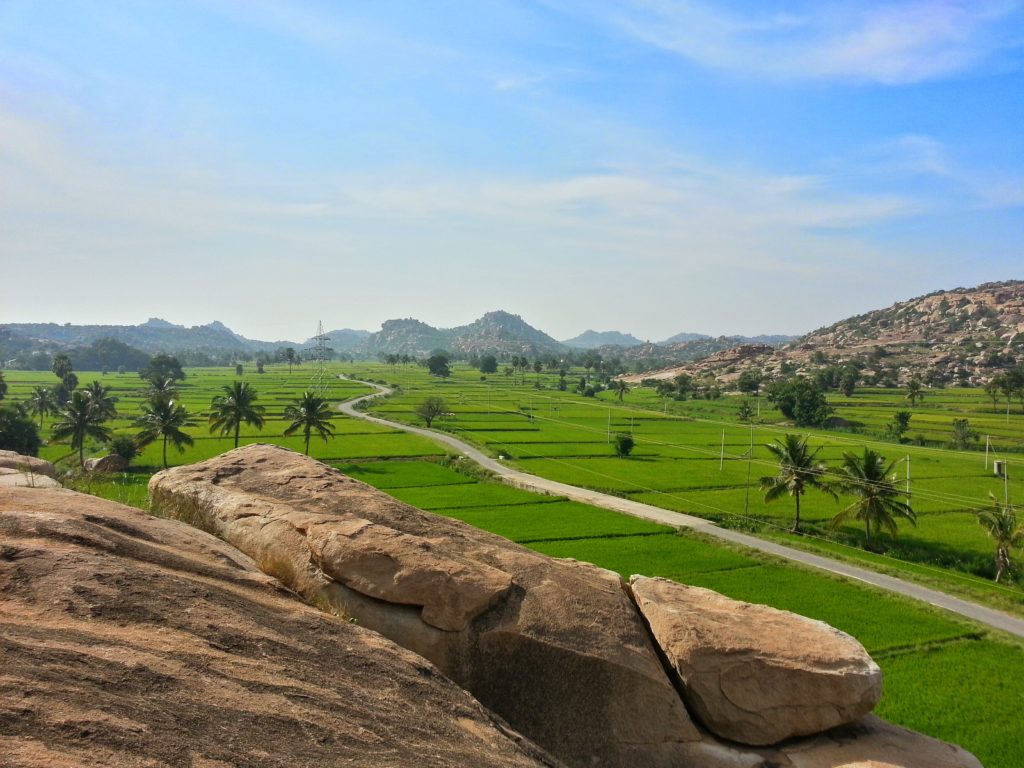
September to March: The season in Hampi starts in September and peaks in December/January and ends by March. This is the time when the weather is the best in Hampi and allows you to spend more time outdoors. It can get really crowded towards December end and January. So make sure to plan your travel ahead of time.
April & May: The weather is unforgiving in the summer months of April and May. Most businesses that depend on tourist inflow shut down for these months in Hampi. Many guest houses, resorts and hotels run special promotion and drop prices as much as 30 – 50% during this time.
June to August: The temperatures drop during these months, but since it is still considered off season, the prices are low. The entire landscape transforms with the monsoon and there is lush greenery. This is a good time to visit Hampi if you are looking for a budget trip.
Things to remember
- Bring a good pair of walking shoes – There will be a lot of walking involved to cover different heritage sites at Hampi which is spread over a large area. A comfortable pair of shoes will make it easier for you.
- Carry a Shawl or Scarf – It can be used to cover your head when the sun is beating down on you, some places do not have shade. When entering temples or villages you can use it to cover midriff, shoulders or chest area.
- Carry water bottles, sunglasses, sun protection lotion, hat/cap while you go out to participate in a tour or sightseeing.
- Carry Identity Card – If you are an Indian national then carry a government authorised ID card. For foreign nationals please carry your Passport, Visa and Insurance documents.
Related Articles
Rise of the vijayanagara empire and its capital city, goa to hampi – everything you need to know, leave a reply.
- Visual Story
The Stone Chariot – Before & After
Duarte barbosa’s first person account of his vijayanagara visit, old pictures of hampi, top 10 things to do in hampi, mango tree hampi – the most beloved restaurant of hampi, mahanavami celebrations in vijayanagara, explore hampi tours.
- +91 9606156857
- [email protected]
Quick Links
Sign-up to receive updates, articles and offers in your inbox.

- Travel Info
- Stay Review
- Travel Deals
Hampi Travel Guide For 2022 | Everything You Need to Know Before Going to Hampi

Hampi Travel Guide ; the place connotes images of colossal and intriguing ruins spread over vast acres of land, evidence of the bygone era of grandeur, pomp, and splendor.
A place with fascinating stories to tell; Hampi beckons every tourist to visit and drown in the mysterious beauty of its rugged landscape, monolithic structures, intricately carved monuments and the fascinating and weird arrangement of its huge boulders.
Table of Contents
Why you must make hampi travel plan.
Hampi which was once the base of the powerful Vijayanagara Empire has been declared as a UNESCO World Heritage Site since 1986. It is one of the must-visit sites in Karnataka and draws hordes of tourists always of the year. And why not!
Hampi tourism is all-encompassing: history, natural beauty, mythology, sightseeing, cultural fulfillment, and one of the best examples of the tech-savvy minds of the rulers of those days.
Hampi -Located on the banks of the tempestuous Tungabhadra in central Karnataka, Hampi can be a dream world for every photographer, history enthusiast, and all those seeking a place to de-stress. With a host of places to visit in Hampi and the surrounding region, your visit will be a bright moment.
Hampi for One Day Trip – Must See
Hampi is a UNESCO World Heritage Site known for its rich history and stunning architecture. Here are some of the must-visit places in and around Hampi:
- Virupaksha Temple: This is the main center of pilgrimage at Hampi and is considered the most sacred sanctuary. The temple’s history dates back to the 7th century.
- Vitthala Temple Complex: Famous for its iconic stone chariot, musical pillars, and the Hampi Bazaar, Vitthala Temple is a masterpiece of architecture and a photographer’s delight.
- Hemakuta Hill Temple Complex: Explore the numerous small temples and shrines scattered across this rocky landscape. The sunset view from Hemakuta Hill is breathtaking.
- Achyutaraya Temple: This temple dedicated to Lord Vishnu is known for its impressive architecture and carvings.
- Lotus Mahal: Located in the Zenana Enclosure, this beautiful structure is a fine example of the Vijayanagar style of architecture.
- Elephant Stables: Admire the grandeur of the Elephant Stables, a row of domed chambers where the royal elephants were once housed.
- Matanga Hill: For a panoramic view of the Hampi landscape, trek up Matanga Hill, especially during sunrise or sunset.
- Tungabhadra River Coracle Ride: Experience a coracle ride on the Tungabhadra River, offering a unique perspective of the Hampi ruins.
If you’re looking for places similar to Hampi regarding historical and architectural significance, consider visiting Badami, Pattadakal, and Aihole .
Along with Hampi, these places form the UNESCO World Heritage site known as the “Group of Monuments at Hampi, Badami, and Pattadakal.” They are all within a reasonable distance of each other and showcase the evolution of Chalukyan architecture.
A BLEND OF ANCIENT & MODERN CULTURE
Hampi used to be a bouldering ruin town of north Karnataka only for those in the know but not anymore. Hampi has in recent time exploded in popularity amongst the backpackers community, and many foreigners travel to India individually to check out Hampi. Make sure to take an experienced local guide with you if you are new to Hampi since rocks can be pretty tricky.
November, December & January is the best time of the year for bouldering in Hampi. It’s better to avoid the hot and dry season from March to June. Make sure you have the right gear & keep plenty of water before you venture out. You can usually rent mats & moped (trim down version of bikes) from your guesthouse and go exploring the amazing piles of rocks littering the town.
GETTING TO THE BASICS
Hampi serves as a rejuvenating weekend getaway to residents of Bangalore provided you set out very early in the morning. And believe me, the trip always turns out to be a fulfilling and rewarding experience. You move out with a bagful of memories of the sheer magnificence of the place; inspiring, tragic, centuries-old remains of the erstwhile Vijayanagar Empire!
HOW TO REACH HAMPI?
There are several ways you can get to Hampi and the common point in all is Hospet, a bustling town offering a lot of travel connections. Many road and rail routes pass through this town from several major cities in and around the area.
By Rail : For rail commuters, the nearest rail station is Hospet Junction which is 13 km from Hampi. Several overnight trains ply from Bangalore, Goa, Hyderabad, Mysore and so on to this place. Local buses ply from the railway station to the bus depot and further ahead to Hampi. In this context, you need to be alert for rickshaw drivers who will charge you exorbitantly for a very dusty and tiring ride.
By Road : There are a couple of options here. Buses of Karnataka State Road Transport Corporation operate daily from Hospet to Mysore, Bangalore, Gokarna, etc.
From Hospet, again the local buses take you to your destination. Private operators also offer a direct overnight service to Hampi from places in Goa or Gokarna. However, there is no return service provided by them.
The third option is to drive your own vehicle or reach via a tourist vehicle from a city like Bangalore, Mysore, Hubli, etc. Hampi to Bangalore covers about 353 km and takes about seven to eight hours depending upon your speed. The route is quite enjoyable as it passes through some beautiful farmlands, vineyards and in general, lovely countryside.
By Flight : The nearest major airport is Hubli which is at a distance of 143 km from Hampi. Then again you must take the roadway to reach Hampi.
You can also resort to the Jindal Vijaynagar Airport near Bellary which is situated about 40 km from Hampi. The airport is connected to major cities like Hyderabad or Bengaluru through twin-engine, turboprop airlines meant for short-haul distances.
BEST TIME TO VISIT
The ideal time to visit Hampi is the period from November to March as these are the periods of best weather and times when you can immerse in the spirit of the colorful cultural and musical activities that take place here. The Hampi Festival, for one, is a three-day festival normally held around November and is the time when the entire ruins come alive with dance, music, drama, puppet shows and varied kinds of fireworks.
A classical music festival is held around the months of January or February to commemorate the birth of poet Purandaradasa. Another event that can be of great interest to you is the Virupaksha Car Festival that is held in March or April. It is one of the largest of all and symbolizes the yearly marriage ceremony of the goddesses and gods.
PLACES TO STAY IN HAMPI
There are several options of Hampi accommodation ranging from star rated resorts to budget hotels in Hampi . The luxurious setting can be obtained in Hospet which boasts of premium hotels like Royal Orchid Central Kireeti or the opulent Orange County Hampi Resort located in Kamalapura. Some of the other Hampi resorts stay includes the Kishkinda Heritage Resort Hampi, Hampi’s Boulders and Clark’s Inn, etc.
On the other hand, places to stay in Hampi which include clean, decent guesthouses or budget hotels are localized either near the main bazaar and the bus stand or Virupapur Gadde which lies on the river’s other side. This is often referred to as Hippie Island and draws a lot of backpackers who choose this area for their Hampi to stay .
THINGS TO DO IN HAMPI

Besides visiting the travel hotspots in Hampi, there are a couple of other interesting things to do. Given below is a list of them.
- Chilling on the Backpacker’s Island is one of the favorite activities for most of the backpack travelers. The island stands in the center of the river and is one of the star attractions in the Hampi tourism Many guest houses, coffee places, and restaurants flourish here, and you can have your fill of them along with a relaxing stint in a hammock.
- Getting involved in the bathing ritual of the elephant residing in the Virupaksha Temple is another activity. It is an hour-long ritual where the elephant is bathed in the river. Tourists are welcome to give a helping hand in return for gifts like bananas.
- Bird lovers can have a field day watching some rare bird species, flamingos and pelicans at the Ankhasamudra bird sanctuary.
- You can also go for a boat ride on the river waters. Coracles are the name of the bowl-shaped boats that take you on a leisure ride through Tungabhadra waters reaching out to some of the unseen temples with beautiful carvings. However, the ride charge is pretty steep; it almost costs about a thousand rupees for an hour or less.
- Visiting a local village, the likes of Anegundi; mingling with the locals, eating their food, getting to know their lifestyle and overall obtaining an enriching experience.
- Cycling is another activity that is very much alive here. People, especially foreigners, take bicycles on rent and roam around with a map on their own.
PLAN YOUR HAMPI ITINERARY
You need to plan your sightseeing in Hampi well if you want to have your fill of everything or I would rather say almost everything as a single visit will fail to leave you satiated. The sightseeing areas can be divided into two parts; the Royal Centre and the Sacred Centre which lie within a 3 km distance from one another. The Sacred Centre includes temples and other religious sites while all structures related to the former royalty lie in the Royal Centre.
As such you need to set aside a minimum of three days if you want to cover almost all the travel spots. There are several options to carry on your sightseeing. If you are a practiced walker then you can cover the area on foot. Go equipped with water, don a hat, apply some sunscreen and explore to your heart’s content.
You can also hire a bicycle or a moped for the day. You will need to offer something as a security to the owner. The third option is to hire an auto-rickshaw for the entire day or on a personal basis. Tours are also organized by bus operators as a feature of their larger package.
However, in all cases do not forget to hire a guide as he alone will be able to recreate the magic of the past. Authorized guides are available who will take you around and explain the importance and history of the places.
They will add some spice to the story sometimes, but it is still nice to listen to their explanation which brings the grandeur and royalty of the place alive. They will charge around INR 1500-2000 and remember you can negotiate with them and find a mutually beneficial plan.
RECOMMENDED PLACES TO VISIT IN HAMPI
As mentioned above, the Sacred Centre of Hampi includes several temples that are all must-visit sites. Before embarking on your temple journey, however, remember that the temples remain closed for visitors between 12.30 pm and 2 pm. This will help you to plan your sightseeing accordingly. Most of the Hampi temples provide for free entry though some may charge a nominal fee for phones or cameras. Following is a brief on a few of them.
TEMPLES & STATUES- HAMPI’S PAST GLORY
- Virupaksha Temple: This is the only religious site where rituals are still carried on today. One of the largest and oldest structures this edifice stands tall at a height of nine stories with its impressive golden tower capping the top. Lord Shiva is the main deity of this temple.
- The Stone Chariot: A huge chariot in stone with intricate carvings adds to the beauty of the Vithala temple. One of the three chariots found in India, this one leaves you awestruck at the depth of the artisans’ skill.
- Monolith Bull: The imposing monolith Bull can be reached by climbing a few stairs as the Hampi Bazaar ends. The bull is a huge piece carved out of a single rock and has a shrine enclosing it.
- Achyutraya Temple: As you climb further up the stairs after the Monolith Bull you reach the Achyutraya temple. Unfortunately, this temple is not in a good shape with no maintenance work in progress.
- Badaviling Temple: This temple dedicated to Lord Shiva includes a huge Shiva Linga carved out of a single stone. It sits in a pool of water and there is a priest sprinkling holy water from the Shiva Linga on to the visitors.
- Statue of Lakshmi Narasimha: Beside the Shiva Linga stands the statue of Narasimha, half man, and half lion. It also dwarfs you with its sheer magnificence and size.
- Sasivekalu Ganesh: A huge statue of Ganesh in stone lies beside the Hemakuta Hill temple’s entrance. This is enclosed by a shrine.
HILLS & HILL TEMPLE AROUND HAMPI
- Hemakuta Hill temple: The Hemakuta Hill temples lie on a small hill which gives an enchanting view of Hampi. Many tourists climb uphill to get an epic view of the setting sun.
- Malyavanta Raghunath Temple: This temple lies on Malyavanta Hill and has priests chanting hymns and prayers there. A huge boulder that is located within the temple structure is a big tourist attraction in addition to the beautiful sunset that can be viewed from atop. The entrance is easily accessible by autos and cars.
- Monkey Temple: A temple dedicated to the Monkey God, Hanuman, the temple can be accessed by climbing almost 600 stairs.
- Matanga Hill: The Matanga hilltop offers a panoramic view of the town and some stunning views of the sunrise or sunset. You can start off early before the heat catches up with you and go equipped with a bottle of water and a protective cap.
STRUCTURES THAT YOU SHOULDN’T MISS
- Lotus Mahal: Shaped in the form of a lotus this was a separate enclosure meant for the royal ladies of the Vijayanagara dynasty. Located within the Zenana Enclosure, it is one of the few buildings that have remained intact to date.
- Elephant Stable: A huge row of domed chambers which housed the elephants of royalty at one point of time, is also in quite a good shape today. A favorite haunt for the shutter-happy tourist, this place is a not to be missed site.
- Royal Enclosure: Spread across vast acres of land, this was the base of the Vijayanagara Empire. Imposing structures of the ruins still draw throngs of tourists to the site.
ON A FINAL NOTE

Hampi is a place you bid goodbye to with your mind totally amazed at the awesome collection of monuments spread across the entire area. Every boulder there is entrenched with a meaning.
Some have helped to create majestic hills of boulders, some have taken the form of ruins belonging way back to the Middle Age, some have gone towards the building of temples and others utilized for carvings. Hampi stands truly unique and magnificent among the heritage sites of India!
Should you be considering to visit the historical Hampi, do check out on Karnataka tourism official website for all details and information
OUR VIBRANT COMMUNITY
I invite you and your friends to join and grow our effort in creating India’s biggest travel community to discuss, celebrate and help the best of travel & life. Please join!
Dear readers, I hope the blog post answered some of the questions about the Hampi tourism guide . Do you still have a question? Feel free to comment or rate us by clicking the 5 stars.
Share This Amazing Location!
About the author: lakshmi vijayadas.

Related Posts

Free Camping Site Near Bangalore | Our Day Camping Experience

Bangalore to Coorg in 2023 | The Best Way to Travel From Bangalore To Coorg

AiholeTravel Guide | Experience the Essence of Evolution through Architecture.
Any contact for guide in Hampi, please?
Maybe you can try – Ravi (94805 69320), who is highly recommended on trip advisor, Virupakshi (94803 19244). Virupakshi’s enthusiasm coupled with his knowledge of the Vijaynagar empire & dates of events, interest in archeology, and ability to weave a story that reaches the facts as it goes along
I wanted to express my heartfelt appreciation for the time and effort you put into your blog. If you want stay in this beautiful place, connect with us to book a luxurious stay at evolveback hampi, Contact us for more details Website: https://evolvebackhampi.com/ Contact: 6366366971
Very simple and effective information for hampy
Session expired
Please log in again. The login page will open in a new tab. After logging in you can close it and return to this page.
Cookie Consent
From Prathyush
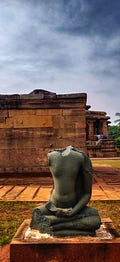
On Hampi, A Travel Essay
Once the capital city of a thriving empire, this is how hampi unfolded for me.

I got lost in Hampi. A coddled, ruined city in Western India (Karnataka), Hampi was carved into life in the 14th Century, nestled between steep, stone mountains that reach recklessly for the powder blue cosmic ceiling and curled around by the perennially boisterous and unfordable River Tungabhadra. There were, thus, strategic reasons to build, here, the ancient capital city of the Vijayanagara Empire, founded in 1336, with nature protecting it, making it difficult for incursions and impossible for invasions, and a watered land for agriculture to thrive — paddy, banana, sugarcane, chilli. The paddy fields that, even today, grow with charming abandon on both sides of the narrow road — a fresh, bright, licked green when I was visiting — is a breeding ground for flies, which at night, under the harsh, illuminating headlamp of a bike look like beads of glistening light darting towards you. My first night at Anegundi 1 — opposite Hampi, this was the Northern outpost of the Vijayanagara Empire, on the other bank of the River Tungabhadra, a thriving village with an ATM today — after a grueling 17-hour train, perched pillion on my friend’s scooty curving along the roads with only the headlamp and the melting moon as guides, I thought those insects were fireflies. But when they whipped against my skin with a pressure unlike the delicate lightness of a firefly, I corrected my assumption and my stance, hiding my face behind my friend’s frame.
There were also cultural, mythical reasons to build an ancient capital city here. This was, it is believed, Kishkinda, the city where monkeys of the epic poem Ramayana lived; where Rama, searching for his abducted wife Sita, meets and enlists the help of the monkey King Sugriva and his army. The caves where events of the mythic epic took place are treated as backdrops of factual relevance, neatly explained in helpful, steel tablets of information outside caves — this was where Sugriva lived in exile; this was where Shabari, the woman who served Rama sweet fruit by first biting into it to check for sweetness, lived; this was where Rama's wife Sita dropped her jewels as she was being abducted, the lashing of her sari as she was taken creating an imprint on the cave that can still be seen today, distinguished by its quartz composition. Outside Shabari’s cave, to which I bicycled in a huff, with a hunch, I met a tired sadhu. He was from Mangalore, a nearby city, where he weathered the pandemic. He was in Hampi for a few weeks, a stopover. He would soon go on to Nepal, but he was worried about his visa. Would he need one, he asked me. He didn’t need tickets to travel on trains, his saffron garbs and one jhola was ticket enough. No inspector or collector ever asked him for tickets, only blessings. He jumps onto and off trains. He had been everywhere, he told me. Chennai? Oh the people were so rude. Calcutta? What lively Mrinal Sen film societies! When I told him I came from Mumbai, he told me that before becoming a sadhu, he tried his luck at the merchant navy like his brother. Rejected, dejected, he did the next best thing he knew. I asked him about his brother. He shrugged his shoulders. He asked me about how the movies are these days. I didn’t know where to begin. He began yawning, a puppy digging into his bag, and I took my leave.
This is a city, I soon realized, where myth melts into facts with an unquestioning ease, you would be a fool to parse them apart. Even the name Hampi is charged with mythic significance. A devout beautiful damsel, Pampa, also the ancient name of the River Tungabhadra, seduced Shiva into betrothal. She became Parvathi, and he become Pampapati — the Lord of Pampa. ‘Hampi’ or ‘Hampe’ is a Kannada form of Pampa.
An architecture student I befriended on a hot afternoon confidently told me, while checking for the pitch of the musical pillars by knocking her rings against those ornate but weathered stone columns at the ruined Achyuta Raya Temple — consecrated in 1534, one of the last grandiose temples of the Vijayanagara empire before its fall — that one of the reasons the Vijayanagara Empire ended, defeated in the 1565 Battle Of Talikota by the Deccan Sultans, leaving Hampi desolate and ruined, was a curse. The head of King Ramaraya was raised on a stake, and the troops of the victorious Sultans knocked heads off shoulders, pushed women and craftsmen into slavery, smashed sculptures, and burnt buildings. Some say the bacchanal lasted 5 months. Some say a year. What it must have felt like, to get up in the morning, every morning, and see before you a city to ruin?
It is fitting that an empire that began mythically in the imagination would end like that too. It is said that Harihara and Bukka, the brothers who founded the Vijayanagara Empire, had seen a hare standing up to and fighting a jackal at Hampi. A place where the soil urges even the weak to stand up against the strong, this must be where the empire begins. And so it began.
You can contradict facts, but how do you contradict convictions? I nodded as the student took me around to a Hanuman temple on the banks of the river where worship is still offered, where the edges of circular yantra of the main temple image is bordered with monkeys eating each other’s tails in an infinite iteration. This temple, Yantrodharaka Anjaneya, is supposed to be where his powers were most potent, the student told me before sending me off to a rocky cliff on the other side, where stones are strewn about, some engraved with 15th Century sculptures, and some with 21st Century debris. It was here that I was lost.
I had walked twenty minutes along the river, from the crowded density of temples to a wilderness of just boulders. Just boulders. Piled one above the other. You could not walk or stroll here. You had to jump, strategically, from one polished stone to the next, making sure you don’t slip and your slipper doesn’t tear. In the cracks between the stones you could sometimes hear hisses. Occasionally a lizard would whip its tale before running away in fear. The sun was lashing hard its noon-light extravagance. Every few minutes, tired, scalded, I would climb the rocks towards the River Tungabhadra and dip my twig dry feet in its cool, eddying waters. It was like thirst being quenched. I couldn’t walk along the river throughout because those rocks were mossy, slippery. I had to keep coming in-land, navigating the dry stones. I was in search of the Kotilinga.
That morning my friend dropped me off on his sputtering bike at a temple before he zoomed off to work, telling me that whatever I saw, I shouldn’t miss the Kotilinga. I trailed through the stone mountains, climbing up, seeing spittles of cactus shooting up from the crevices of rocks, spider webs softly blowing in silken splendour in the early afternoon breeze, and then climbing down the mountain. A long, white hot afternoon lay stretched out ahead of me. I had chanced upon the architecture student, who had shaken some faith into me and then sent me off, and now I was lost. It took me almost an hour to reach this place, where everywhere I look I could only see stones, and through gaps, the bursting river.
It is the first thing you will notice when you enter Hampi. All the granite stone mountains — brown, ochre, grey, pink — that look like they were placed there by some grand architect, polished boulders fitting comfortably into the crevices of other boulders, or piles of rocks that, in the words of a guidebook, “seem to have been thrown down by some primeval cataclysm”. But this was all nature. The granite terrain here is one of the most stable, formed under the Earth’s surface 3-3.5 billion years ago, then pushed up, then weathered down by wind, rain, sun, that make the big boulders look like they are perched precariously, about to fall off, onto your head. But they are secure where they are.
The Kotilinga I was in search of is an elusive thing. My friend told me nothing about it, just that I had to see it. The student, who had been living here for a month told me that it was only after a few visits to the area, that the Kotilinga — literally, a crore Lingas, the penis-shaped symbol of Shiva — showed itself. All these Lingas are carved into the stone floor, and so can’t be seen from a distance. The architect pointed at a bunch of rocks in the great distance and told me, behind those you will find it. There was no one else to guide me. No road marker. After almost an hour, I thought of giving up. I saw a ruined temple on top of the stone deluge and climbed up towards it, wondering perhaps with a top-view I could spot the Kotilinga. I couldn’t.
Instead, I saw this sculpture of Anantashayana, Vishnu resting on his bed of snakes on the cosmic ocean, with his two wives Sridevi and Bhudevi at his feet, and Brahma emerging from a lotus that is tethered to Vishnu’s navel. I was reminded of a folk tale my professor told me, of how before Vishnu would make love to his wife, he would shut the lotus so Brahma, the creator of the world, would curl up into the lotus to give Vishnu the privacy he needed. How old could this sculpture possibly be? Just strewn about, in the middle of nowhere, a sculptural marvel. As I dipped my feet, again, into the cool river, on the other bank I saw a sculpture of a Nandi, the bull of Shiva, nestled between stones.
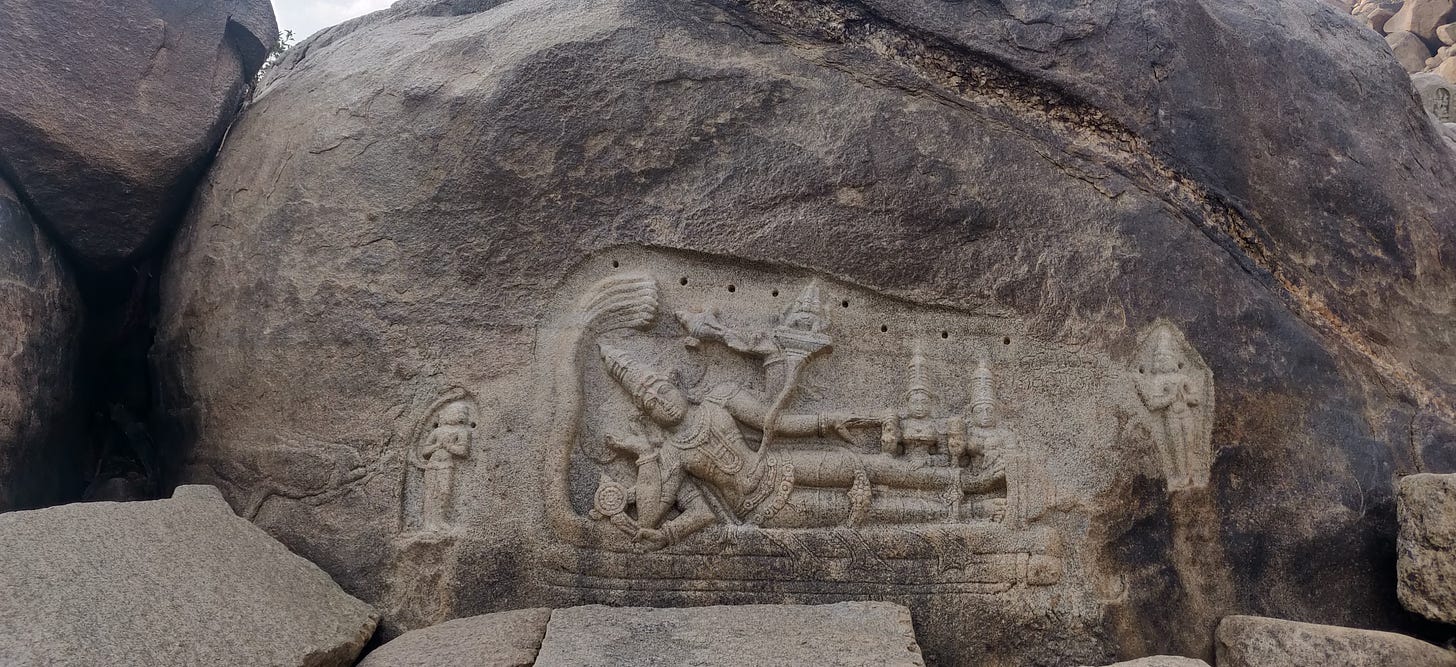
In the evening, when I told me friend I couldn’t find Kotilinga, he told me that wasn’t the point. It was that feeling of abandoned, unrestrained beauty with bursts of history that he wanted me to see, and most importantly, feel. No guide will tell you to walk this path, strewn with as many falls as hisses. The architect also only found this place when she saw a bunch of local kids smoking weed on a rock. She assumed, this must be Kotilinga. She wasn’t wrong.
I often wonder what to do with history and heritage. What do we get by preserving it the way we preserve it today, by keeping it within manicured lawns, promoting it through well produced ads that energize a churn of tourists who walk around, sometimes bored, sometimes weeping, sometimes like me — both. Hostels and hotels mushroom, heritage rooms with expensive service come up, a boom in local employment selling coconut water, sugarcane juice, soda, cigarettes. In Aihole, a town with 6th Century ruins nearby — to reach which my friend and I had to take four buses, from Gangavati near Hampi to Kushtagi, from Kushtagi to Ilkal, from Ilkal to Amingarh, and from Amingarh, in one of the most rickety kilometers of bad road, finally to Aihole — an autodriver told me how the local heritage hotel was being built by keeping the local villagers out. It was being built for years, refurbishing an old fort, and not a single villager was even allowed to peek inside. Is this part of the preservation project? What are we preserving? For whom? For what? Walking around we would see men and boys sitting around the veranda of these temples which are strewn about, smoking, speaking, or on Sunday mornings we would see women lashing soaped clothes on these rocks. Is living among 6th Century ruins like it were part of your house not another kind of preservation we should cherish and let be?
I wonder, too, 600 years or 1600 years from, when people look back at the 2000s, what will they see? The author Parmesh Shahani had told me about freshlimesoda, a website he had started in the early aughts, and spent years curating and populating. The website is now ether, all the writings on it, disappeared. While trying to help him research his book Queeristan, I tried to get access to these old articles. No luck. They just don’t exist anymore. Imagine if the internet breaks down tomorrow — what will remain? The architect told me that Krishnadevaraya, the most celebrated Vijayangara king, valued stone more than gold. For gold can be melted away, but stone stands through time, even if it stands weathered, it still stands. 600 years later, we’re still visiting it like a tomb to pay our respects.
Architect Rahul Mehrotra often talks about impermanence in architecture as vital. He uses the Kumbh Mela as an example. How every few years, for the mela, an entire city erupts by the banks of the rivers, a temporary city, which after the devotees recede becomes mud and which the monsoons flood into nothingness, to be resurrected again in a few years. This, he finds the clarion call of sustainable architecture. To be willing to not hold onto anything. To create, comfortable with destruction.
The weathering of these monuments added a veneer of poetry to the sculptures one could not have planned for when creating. When I had seen Edward Munch’s The Kiss in the San Francisco Museum Of Modern Art (MOMA), something within me felt unsettled, invited, moved. The thickness of desire was suddenly palpable — two lovers melting into one in an act of eros. In the temples of Aihole, and nearby Badami and Pattadakkal 2 the sculptures of men and women in erotic embrace were often weathered by time. Each feature of theirs, chiseled to perfection in its epoch, lay melting into the stone it was carved out of, and the lovers melting into one another. Unlike Munch, who crafted the melting, here, the sculptor was not just the artist, but time herself. I see a sculpture of a seated Buddha, but his head is cut off, one of his arms missing, his legs crossed, and the cumulative effect was of deep calm. Which author do I praise for this production of serenity?

I often didn’t know what I was grasping at or for. The first two days I was moved by the men standing in Tribhanga — a standing position, used liberally in Odissi dance, where the body bends in one direction at the knees, the other direction at the hips and then the other again at the shoulders and neck. These were masculine gods — not just masculine but fiercely masculine, like Veerabhadra and Bhairava — standing in Tribhanga, often considered feminine. Their hands on their hips. I used to stand like this as a child, a habit that was sucked out of me and ditched over the years, preferring a broad, puffed chest.
Sometimes I would stare at Mahisasuramardhini — the goddess spearing the buffalo demon dead — her face so serene in an act so violent. My friend told me that this was the sculptural greatness, a feature that showed poise, grace, and restraint even in the most violent of acts. That was the ideal. Nonchalance towards life. I saw men and women kissing in sculptures, their body melting away into vines and arabesques that would further melt into the flat polished rock. How many more decades before all of this becomes flat, featureless slabs of stone? Are we the last? Does it matter?
Before taking a bus to Hubbali, from where a bus to Bombay awaited, my friend and I went to Mahakuta, a temple in Badami. We are both convinced we hallucinated what happened next. A marriage was taking place, the Haldi ceremony underway, where not just the bride and groom, but every guest was caked from head to toe in bright yellow turmeric, with a headgear of fragrant flowers. A woman passed by me, the diamond pinprick of light from her nose ring startling me amidst all the yellow. She looked like the portraits of Goddess Amman we had in our home. Big eyes. There was a temple tank, where you give 5 Rupees to get in. The water was warm even the air above it was a frigid winter. We didn’t plan for it, but we dipped. Later, I tried squeezing every drop of water from my underwear before putting it in my bag, worried what the impending hours of travel would do to it. Finally, in Bombay, it smelled sour.
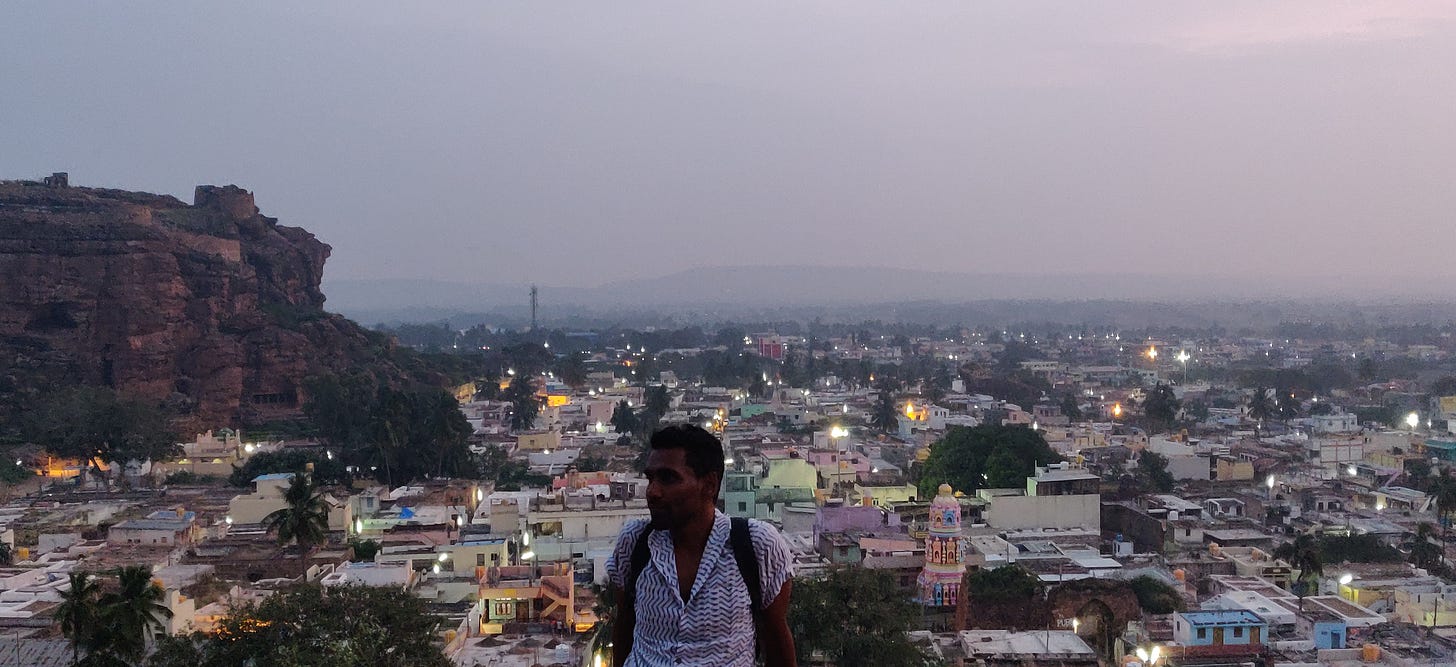
You could travel between Anegundi and Hampi by taking a ferry or a coracle across the river, but since the rains just bloated and flooded the fields and dams, the ferries were not running and you had to take a bus that would wind all around the terrain.
This was how an auto-driver described, rather succinctly, the difference between the architecture of Aihole, Badami, and Pattadakkal, cities in Western India (Karnataka) where the Chalukya Dynasty bloomed into cultural and political prominence between the 6th and 8th Centuries CE — “Aihole … primary school, Badami… secondary,” and after a brief moment to think of how he wants to take this analogy forward, “Pattadakkal… full college!” What began as a series of experiments in temple building — from hacking into the stone mountains carving cave temples to free standing structures with identifiable aesthetics — and sculptures that commenced at Aihole, the commercial center, continued at Badami, the capital of the Chalukyas, and culminated at Pattadakkal, the ceremonial center of the Chalukyas. All of this has been acknowledged by and manifested into manicured lawns and clean toilets by UNESCO’s bestowal of World Heritage Site status on Pattadakkal in 1987.
Ready for more?
Essential Hampi – A Brief Guide to Hampi
The perfect break from India’s bustling cities, our brief guide to Hampi looks at how to get the best out of your visit to Hampi.
This is a guest post contributed by Karen Turner of Wanderlusting K . All photos in this post are copyright to Karen unless otherwise stated.
This post may contain compensated affiliate links. More info in our disclosure .
Visiting Hampi, Karnataka
One of my favorite places that I visited in India had to be Hampi.
This ancient city destroyed by the Mughal empire was one of India’s biggest medieval cities with more than 500,000 residents. It was long covered up by banana plantations, however, its recent UNESCO recognized status is likely to draw visitors to its quiet beauty.
Hampi truly still shines as a destination for history lovers, wannabe Lara Craft archeologists, and Hindus looking to step back in time. I hope that these Hampi tips help you prepare for your trip go off without a hitch.
How to get to Hampi
If you’re visiting Hampi, it’s easy to take the overnight train to/from Bangalore or Mysore. (It is possible to fly from Bangalore or Mysore to Hubli, which is three hours away.)
The train does not run every day, so be sure to check the schedule. Those looking for a bit of comfort will want to book first-class for a bit more privacy and the ability to lock the door at night while you’re sleeping. If you can sleep well under any conditions, second-class AC or third-class AC work well enough and save you quite a bit of money.
Your train will arrive at Hospet Junction, which is the closest station to Hampi . We paid 1,600 rupees for our one-way journey in third-class air-conditioning on the train from Mysore to Hampi and 4,000 rupees for a one-way train journey in first-class for two people.
From the train station, it’s a 20-40 minute ride with a rickshaw to Hampi Bazaar. This newly constructed village surrounding the ruins was constructed after UNESCO officials said that the village of Hampi was too close to the ruins. It’s otherwise a very quiet and peaceful place surrounded by banana plantations and sugarcane plantations. It’s hard to imagine the ruins as you travel here by rickshaw. We were picked up by our guesthouse with a smiling driver with a card for a small fee.
If you’re travelling from Goa to Hampi you can take the Howrah Express train from Vasco da Gama station in Goa to Hospet, passing through the stunning Dudhsagar waterfalls. If trains are full, there are several bus services available, the most recommended AC Volvo service being run by Paulo Travels . Search and book train tickets here .
Or you can book a tour from Goa such as this one .
How Long to Spend in Hampi
We spent two full days and one night in Hampi, with arriving in the morning and departing in the evening on the second day. It was just enough time, but I’d recommend giving yourself more time, especially if you’re a climber.
Three full days and two nights would have been perfect as two days felt rushed, or three nights if you really want to slow down and savour the experience.
Where to Stay in Hampi
Accommodation at Hampi is split between Hampi Bazaar which is close to the ruins and home to most of the budget accommodation, or Hospet has some more upmarket options.
Accommodation in Hampi Picks:
– Gopi Guest House (Budget) – Great views on a budget – click here for rates
– Padma Guest House (Budget) – Alternative great value option in Hampi Bazaar with air conditioning – click here for rates
– Evolve Back Hampi (Luxury) – Beautiful award winning high end accommodation, in the grounds of a palace just 4km from Hampi – click here for rates
We stayed at Gopi Guest House , which took care of all the details for us from our pick-up at Hospet to finding us a driver to explore the ruins to our final drop-off with an ATM detour. They also happily fed us drinks with an incredible view of Virupaksha Temple to savor as you enjoy a fresh mango juice.
Listening to the temple music as the sunset was absolutely one of the most memorable moments of our trip. Gopi Guest House was a quintessential Indian guest house: The basics with air conditioning with warm hospitality.
For a bit of luxury, look outside of Hampi Bazaar at hotels such as Evolve Back Hampi .
Visiting the Temples at Hampi
Hampi is absolutely beautiful to explore, however, you’ll be exposed to the sun quite a bit as there’s little shade. Be sure to wear sunscreen and bring plenty of water with you.
Hampi is a sprawling site of 3.2 acres.
Although you could walk it, enter the 21st century and hire a rickshaw to take you around. We hired a driver via our guesthouse for one day to wait for us outside of the temples as we explored them on your own.
You can pick up books in town about history and guide yourself, or you can opt for a true guide who will walk you around the sights who will accompany you in your rickshaw. You’ll pay less for simply a rickshaw driver.
Be warned that the rickshaw drivers can be a bit overly enthusiastic outside the site and you’ll be asked by what seems like a million drivers if you need a ride if you pop out of a temple without a driver next to you.
If you have a bit of a fear of monkeys, Hampi can be a bit of a challenge as monkeys are in many parts of the park, however, they were not generally aggressive. Still, take caution in interacting with monkeys.
One of the most famous temples in Hampi is the Monkey Temple , the birthplace of Hanuman. Not surprisingly, there are lots of monkeys. Many people come here for the view close to sunset although be careful and watch out for sunglasses and other shiny things that the monkeys like to grab.
The Vittala Temple and the most famous monuments of Hampi are included in the Hampi ticket, which costs 600 rupees for foreigners (2019) and less for Indian nationals. This also includes admission to the Lotus Mahal and the elephant stables, definitely a highlight. I also loved the step-well.
Similarly, it might be worthwhile to step into the impressive Virupaksha Temple , a beautiful 7th-century temple. The shoe fee is 2 rupees although there is a camera/video fee.
It should be noted that the Virupaksha Temple has a temple elephant. The temple elephant stands all day blessing pilgrims to this temple and a deeper dig into the animal welfare of temple elephants led me to choose not to get an elephant blessing. Please research this issue! If you want to see Lakshmi in a happier environment, she takes a bath in the mornings in the river–and she is a typical elephant at this moment.
Any decent guide will cover most of the attractions in one day. I found the architectural museums less interesting than the actual sights, but those into history might enjoy them more. I especially loved the quiet Underground Shiva Temple, which gave me some serious Lara Croft vibes.
Many of the temples in Hampi are free to visit, so be sure to ask your guide to cover all of the paid admission sites (e.g. Lotus Mahal) within one day to maximize your ticket. You can visit the rest on a second or third day. It’s said that UNESCO will be making more notable changes in the coming years to Hampi to make it more tourist-friendly.
Practical Tips for Hampi
Hampi Opening Hours : Most temples and sights are open from morning until dusk. After this point, security guards will kick out everyone who is around. Although various things online mentioned about sunrise and sunset, be aware that access might not be allowed if it’s too dark out. The view from sunset point Hemakuta was lovely without being too far from Hampi Bazaar.
What to Wear for Visiting Hampi: You’ll be walking a lot while in Hampi, so be sure to wear comfortable shoes with a good grip. You’ll be walking up boulders, within abandoned temples, and along stone paths, which can be slippery if wet. Although many of these temples are abandoned, visitors should still be aware that these are still religious sights important to many Hindus and Indian visitors. It’s best to cover up with a long breathable skirt or loose trousers. The heat might get to you, even in winter!
Solo Female Travel in Hampi: Solo female travelers should be okay in Hampi, however, they should be careful exploring more remote parts of Hampi on their own. Some caves and temples can be very dark/remote. It’s very easy to meet fellow travelers at guesthouses, so don’t be afraid to strike up conversations as it will bring down the price and allow you to have a travel companion.
Money at Hampi : Most importantly, we highly recommend bringing all the cash that you think that you’ll need with you. We spent over 5,000 rupees ($70 USD) for two full-days with touring Hampi, all meals, all drinks bouldering for one, transit to/from the station, and our accommodations with a view of the temple. There are ATMs in Hospet and notably, the State Bank of India ATM is the best for foreign cards.
Where to Eat & Other Things to do in Hampi
We had a nice thali lunch at Green Restaurant where you can sample the local vegetarian specialties. Western options were also available here and food was prepared with filtered water. This is close to the Lotus Mahal.
In the Hampi Bazaar, my favorite restaurant was Mango Tree Restaurant with its reclined seats, comfy pillows, and delicious juices. It should be noted that alcohol is illegal in Hampi.
Across the river, you’ll find Hippie Hampi or the village of Virupapura Gadde. You can cross the river in a traditional riverboat for a small amount. Many of the more hippie-oriented things are on this side of the river, including Hampi’s most famous places to boulder. The rocks surrounding Hampi are famous for bouldering.
While in Hampi, you’ll want to look up Hampi Adventures (next to Pradeep Campsite) . Tom is a great climber who intimately knows many of the bouldering routes, so call him at least a day before to see if you can come with if you can boulder. (Tom and Jerry used to run a bouldering outfit together, but have now split off into Golden Boulders and Hampi Adventures just down the road from each other. Both are located across the river from Hampi Bazaar.
You can rent all the essential bouldering equipment (crash pads, chalk, shoes) from them, but bring your own exercise clothes!
Final Thoughts
Overall, Hampi was a dreamy destination away from the hustle and bustle of other Indian cities. If you are visiting the south of India, it is worth making a detour for Hampi, especially once you experience your first sunset here…
This is a guest post by Karen Turner from Wanderlusting K, an adventure travel blog. All photo copyrights belong to Karen Turner unless otherwise stated. The usage of these images without permission for commercial usage is NOT permissible.
Soul Travel India
Passionate about all things India travel - journeys of transformation and discovery, local experiences, and getting under the skin of India.
1 thought on “Essential Hampi – A Brief Guide to Hampi”
- Pingback: 10 India VIRTUAL TOURS to take now | Soul Travel India
Comments are closed.
Copyright Soul Travel India 2022, All rights reserved. This website uses compensated affiliate links.
Skip to navigation
India: Hampi
My software archaeology sites
Mark Moxon's Software Archaeology
Elite on the BBC Micro and NES
Aviator on the BBC Micro
Revs on the BBC Micro
Lander on the Acorn Archimedes
My writing sites
Mark Moxon's Travel Writing
Walking Land's End to John o'Groats
Tubewalker: The Tube, on Foot
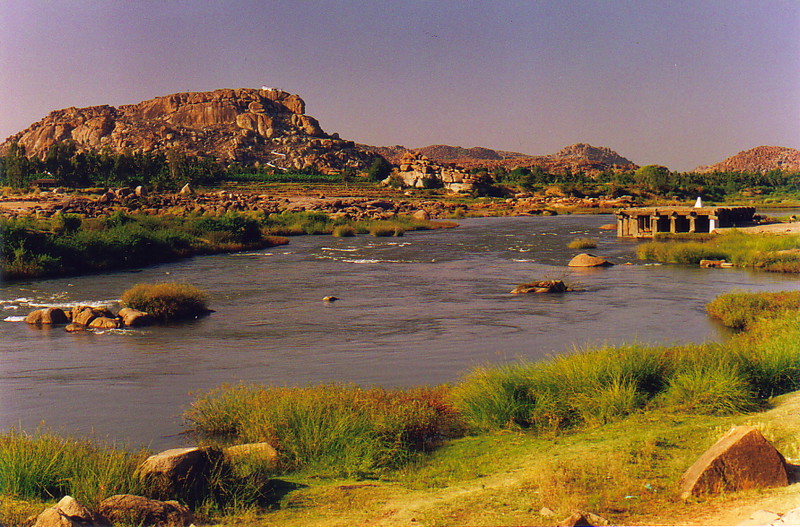
A night-train ride northwest of Bangalore , Hampi seems to exist in a sphere of its own, a self-contained combination of timeless natural wonder and historical human impact. Here the ruins of ancient civilisations pepper the rocky landscapes while restaurants pander to the requirements of the tourist classes, and all the time the slow turbulence of the Tungabhadra River meanders along the valley floor, only months away from the raging tumescence of the monsoon.
Describing the atmosphere of Hampi is as difficult a task as describing the allure of the city lights or the hypnotic attraction of dance music, but there is no doubt in every visitor's mind that Hampi has a special something , even if putting your finger on that something is impossible. For some it is the stark beauty of the igneous rock formations that dominate the landscape as it shivers under the heat haze of the midday sun; for others it is the different sense of time, a disconnection from the hustle and bustle of modern India – indeed, the modern world – as cows ramble past the stone steps where colourfully dressed women beat the dirt out of their washing; and for others it's Hampi's proximity to the beach state of Goa, resulting in the availability of luxuries like king-size cigarette papers and wonderful tourist trinkets while managing to remain an outpost of primitive culture.
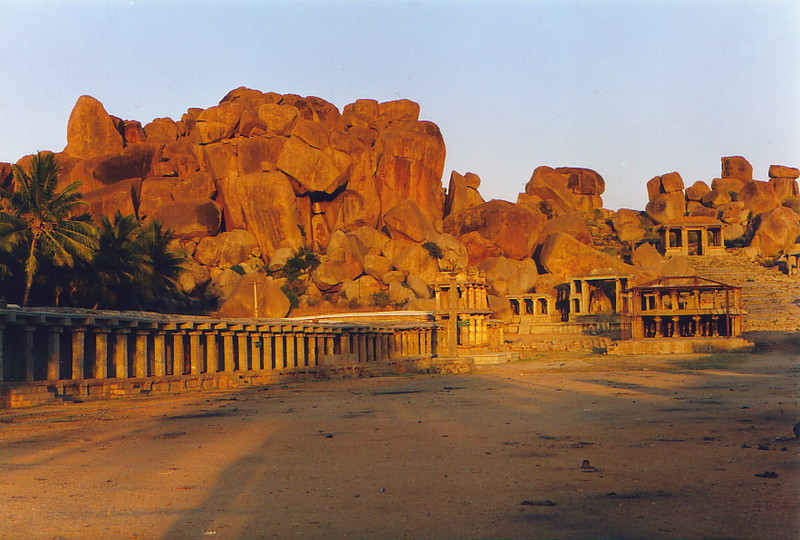
Because the little town of Hampi is surrounded by one of the most extensive and varied collections of ruined buildings this side of Delphi, I decided to employ the services of a guide, a young man called Chandra who turned out to be a particularly good find. During the course of two half-day tours, he managed to transform a collection of dilapidated stone constructions into a living, breathing world of bazaars, incense, rituals, royalty, engineering genius and warring nations, a feat achieved by combining his encyclopaedic knowledge of local history with an evocative delivery, a talent unusual in someone so young. As a one-on-one guide he brought Hampi alive, recreating the scenes from 500 years ago when the Europeans were tentatively reaching out their colonial intentions towards the east, the Muslims were methodically invading India from the north, and the Vijayanagara Kingdom was thriving in the Hampi area. I normally scorn guides, but this time it turned out to be a good move.
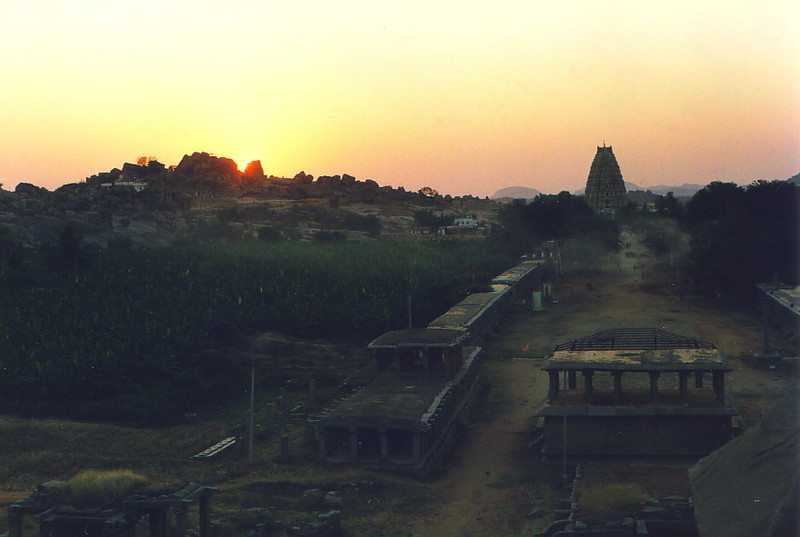
On the other hand, touring Hampi in the incredibly sweltering afternoon sun did make me think that if I saw yet another temple, I'd probably kick it. After a while lingams and gopurams begin to look exactly like all the other lingams and gopurams you've ever seen, and so it was with the temples of Hampi. But this is where Hampi wins hands-down over other sites, because behind each ruined building is scenery that bewilders.
In a geological pattern echoed by the rock sculptures of central Australia , Hampi's landscape is volcanic in origin; as the volcanic exudate cooled it cracked along vaguely orthogonal lines which, when exposed to the vagaries of weathering, wore down into piles of rounded boulders the size of houses. The resulting mountains of rocks are stacked up in gravity-defying balancing acts, with boulders seemingly about to roll down onto the town while stone slabs look as if a slight push will slice them like bread off a loaf, taking with them banana trees, coconut palms and electric cables.
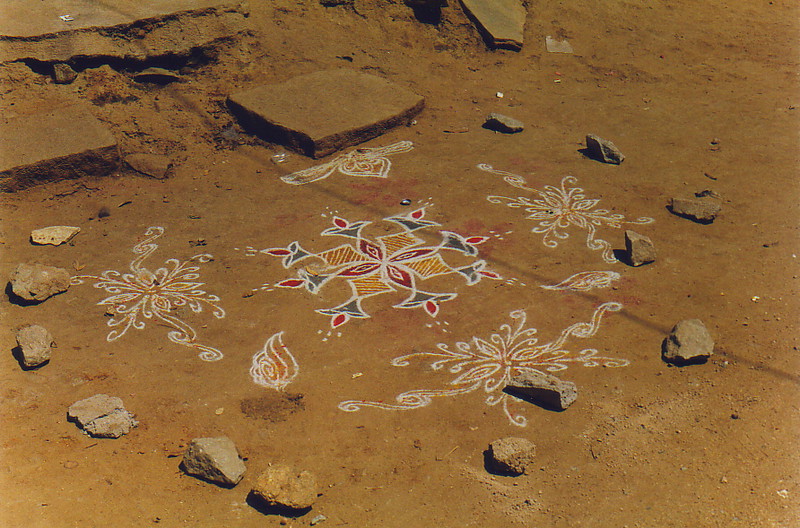
Electric cables, indeed; for Hampi, while an historical tour de force , is an attraction that's positively ripe for the milking. The number of visitors who flock to see the sights is on the increase, and simply looking at my two-year-old guidebook's description of accommodation and restaurants shows how much has already changed. But for once the onset of the clumsy boot-heels of tourism doesn't concern me greatly; to destroy the unique atmosphere of Hampi you would have to defile a stunningly large area of inhospitable Martian landscape, and more buildings won't manage that. And Hampi is hardly the place where the clubs of Goa or the high-rises of the hill stations would work; the people just don't seem to have drunk from the cup of mammon that the Goans have drained. This is, without a doubt, a godsend.
Images of Hampi
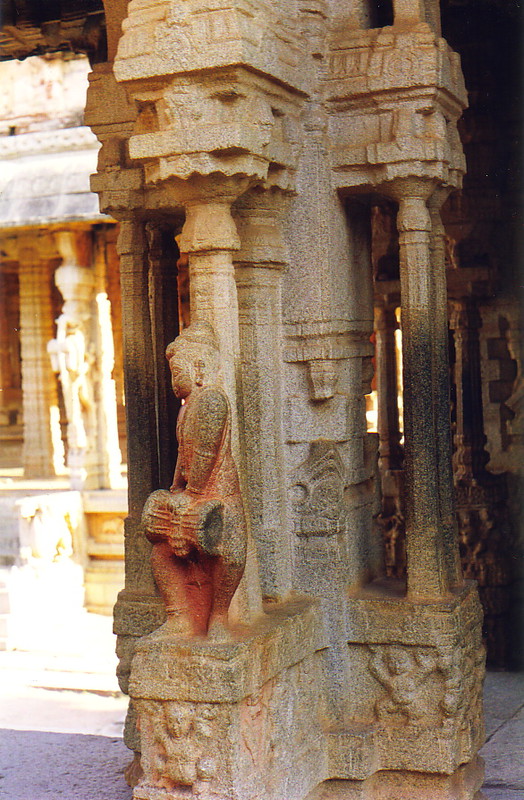
As with all fairly long stays, I happily slipped into the lifestyle. In Hampi the mañana ethos is stronger than in most places, and yet again I found my plans slipping gently away. Highlights of my lounging in Hampi follow, in no particular order:
Have you ever heard a musical temple? Neither had I before Chandra took me to the World Heritage Vitthala Temple. Here, tapping certain stone pillars produces harmonics that can only be described as ethereal, and it's something that's quite impossible to imagine until you hear a tune being tapped out on a stone carving of a drum. Discovering this sort of architectural genius really makes you really think about modern life; modern man could probably build such a temple out of granite if he so desired, but it could only be achieved with the aid of computers and science, systems that the builders of Hampi couldn't have dreamed of even in their most hallucinogenic phases. The same goes for the Pyramids, Stonehenge, the statues of Easter Island, the palaces of the Aztecs, the megaliths of the Bada Valley and so on. Do you ever get the feeling that by learning so much, we forget even more?
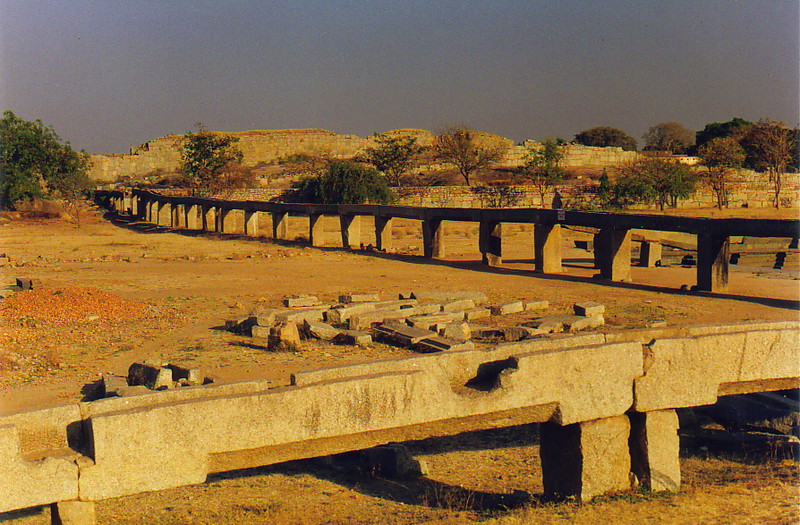
Other astounding architectural wonders pointed out to me by the vivacious Chandra were a comprehensive aqueduct system for filling the city's water tanks and bathing pools; underground temples used for secret meetings, where bats now inhabit the dank water-lined corridors while shafts of sunlight slice through the gloom; ancient water-based air conditioning on the first floor of the queen's pad; and a refractive light trick that reflects a gopuram 's image upside down on the wall inside the temple. I could describe the fascinating history of the area and all the quirky clashes of Jainism, Hinduism and Islam that are reflected in the architecture, but plenty of better-informed scholars have written on that topic. In the case of Hampi, it's best just to go there and see it for yourself.
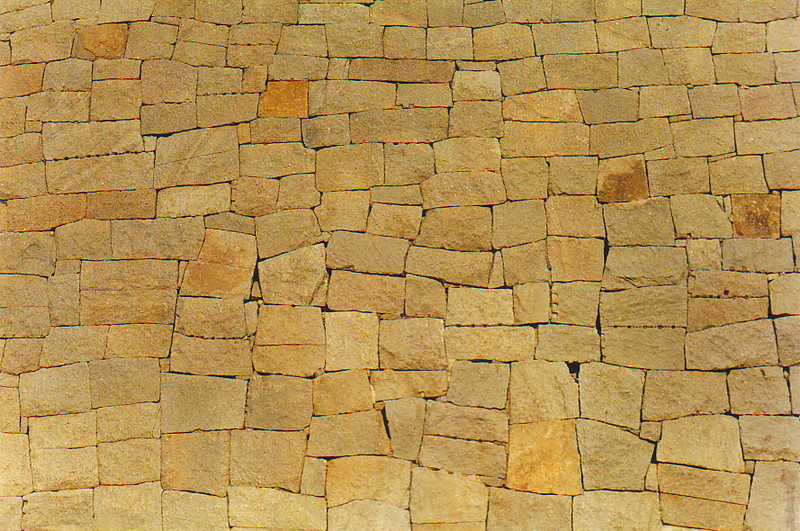
The local tribeswomen have resurrected their traditional dress in a wonderful combination of aesthetic concern and wily tourist appeal. These women, normally fairly ancient, get around in costumes that look as if they've smothered themselves in glue and rolled around the floor of a pantomime seamstress's sewing room. Chunks of mirrors offset the garish pinks and purples, monstrous nose studs clash with whole families of arm bands, and all the time they're trying to persuade you to shell out for handbags that would have made early Pink Floyd fans suck in their breath at the savage colour schemes. If Blue Peter was into fashion, this would be the result, and it's a gloriously kitsch sight.
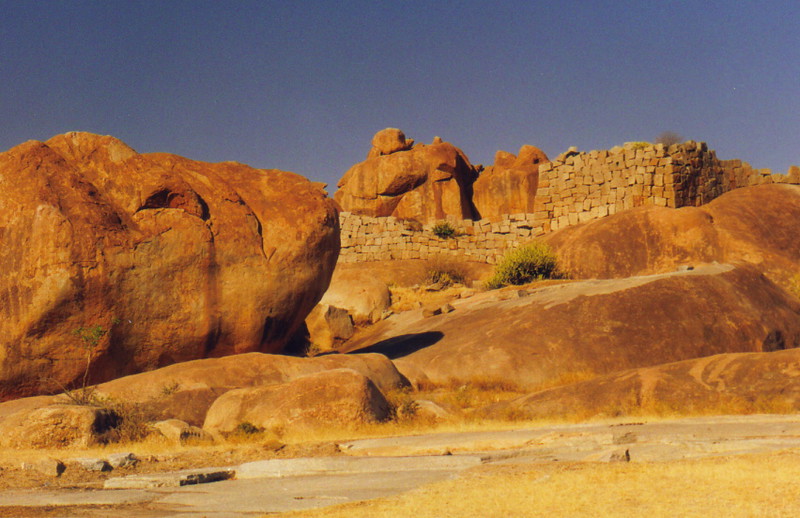
Also quite aware of the deep pockets of tourists, crazy sadhus – wandering holy men who live an ascetic lifestyle – roam the streets with their wild eyes and wilder claims, and herds of wonderful postcard-selling children ply the restaurants with their excellent English and smiles that keep on shining well beyond their departure. If these little charmers are typical of the next generation of Indians, then this country's got a rosy future.
Why is it that just as soon as you have met some of the most warm-hearted and interesting people on your whole trip, they have to disappear into the folds of the travellers' trail, and always too soon? In Hampi I met and waved goodbye to a whole group of great people who instantly struck a chord. Kenny, Ross, Kirsten, Mark, Leslie, Mark and Sharon... and don't forget the locals, a collection of coyly intelligent bundles of fun who turned the whole event into one long festival of singalongs, culinary experiments and familial closeness. Maical, Lakshmi, Ali and countless others didn't just enliven Hampi, they personified it. And, as if I need to mention it, people smile back in Hampi. Not for the first time do I find myself hoping that I'll meet them all again, some sunny day.
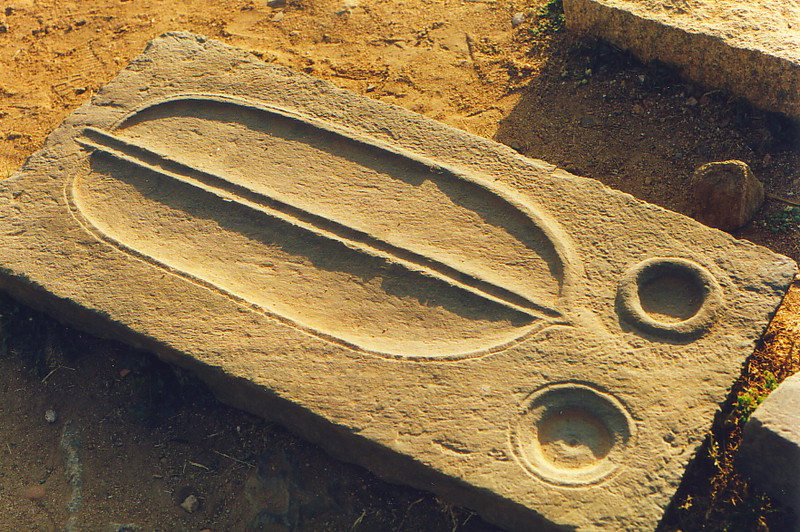
I finished reading Sophie's Choice and I actually felt tears welling at the cataclysmic outcome of the novel. Perhaps it was the fact that I identified heavily with the narrator, but it moved me; the only other book I remember affecting me like this was a series that I read as a child, some five or six books whose names I forget and whose contents I only vaguely remember. After completing the last book and reading of the death of a character who had permeated each of the stories, I felt for the first time the icy grip of a master storyteller killing off a character who's become almost real. Sophie's Choice came along at a time when I was really beginning to rediscover my passion for all things literary, and if anything it has solidified my hopes to become a writer. If only I could produce the matchless prose of William Styron, I would feel I had achieved my life's ambition...
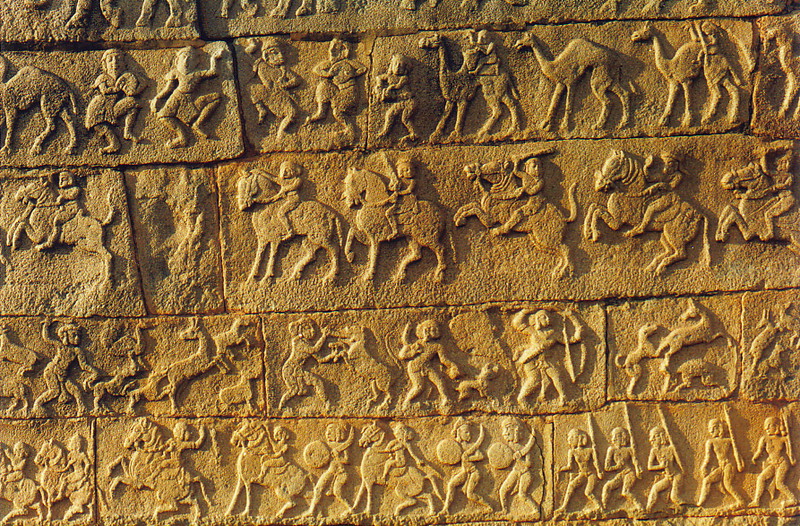
As if to remind me who's the boss, another bout of vomiting and diarrhoea struck me down five days after I arrived in Hampi, taking me by surprise me after a month and a half of reasonable health. I lay knocked out in my room, writhing in a turmoil of half-remembered dreams, sweat-wrung sheets and subterranean homesick blues, hoping for nothing more than a visit from somebody. Unfortunately I twisted in solitude, feeling far more than just lonely; I felt forgotten. However, it turned out that there was no reason to feel lonely, at least as far as illness went. During my eight-day stay absolutely everyone in the group went down with something, from the mildly uncomfortable to the serious, so there's clearly a hygiene problem in Hampi, especially at this time of year when water is scarce. (And, just like in Puri , my illness coincided with enforced vegetarianism, because Hampi is a no-meat zone on account of its religious significance; bring on the chicken, I say.)
The sunsets in Hampi are indescribably beautiful, so I won't.
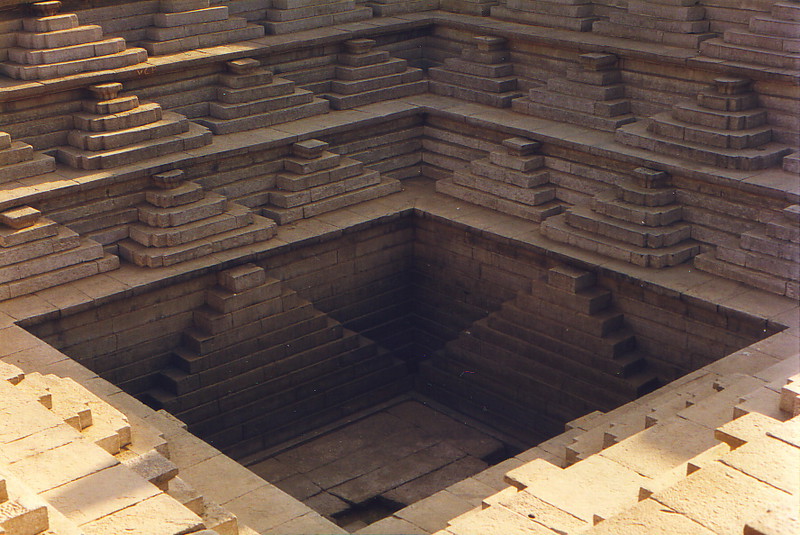
Try crossing a river in a coracle and you'll never again be scared by amusement park rides. Over the river from Hampi are more restaurants and hotels, where they even serve alcohol (though I stuck to the lassi, given my illness); you reach them by entrusting your life to a wood-and-tar contraption that redefines the word 'basic'. At night the coracles are beached by the riverside, overturned into a family of giant turtle shapes that leave behind perfect circles of fertile grass. On the other hand, entrusting your life to Charon isn't as crazy as floating down the river in an inflatable rubber tube, which is a popular way of seeing the landscape. I would have gone, but I found watching the tourists float past from my vantage point in the riverside restaurants far more relaxing than the prospect of getting wet myself. Besides, I kept thinking that I could always do that tomorrow...
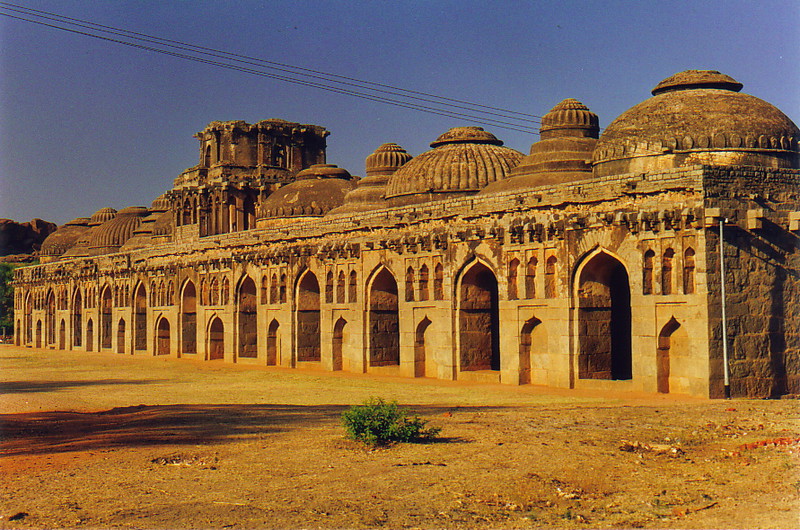
It seems that Hampi has every type of Indian weirdness available, all crammed into one small town. There's an ashram being built on the hills overlooking the eastern end of the bazaar; there's a crazy palmist down by the river with orange robes, a huge beard and a little hut, who can be seen wandering around the town with his portable radio on full blast; there's a local homeopathic doctor who will cure all your ills for Rs50, asking questions like 'What qualities do you most admire in your friends?' instead of 'Now, where exactly does it hurt?'; there are restaurants serving bhang lassi by the river, and extremely strong ones too, judging by the local populace ( bhang lassi is a marijuana milkshake, and is the closest thing I've ever found to Anthony Burgess's 'moloko with knives' from A Clockwork Orange ); and there are dogs, pigs, cows and chickens wandering around everywhere, eating each other's faeces and generally having a ball. It sounds just like everywhere else I've been in India, doesn't it?
And to cap it all, I was lucky enough to be in Hampi for the Holi Festival , and I can't think of a better place to spend it...

Exploring Hampi as a Solo Traveler: The Complete Backpacking Guide

traveller Shreya
Hampi solo travel tops the bucket list for most if not all backpackers. The name ‘Hampi’ did not ring a bell for many travellers till the past few years. But as of late, this culturally rich village has become a favourite pick among passionate backpackers and solo travellers.
On your Hampi solo travel, make sure to feel the travel-friendly vibes of this culturally rich yet modern locale. Hampi is actually a village that is set in Karnataka, on the banks of the river Tungabhadra in southern India. In my current blog, I will share my experience with all of you along with the budget required, places to stay, eat and visit for sightseeing.
An escape to the once magnificent capital of the Vijayanagar empire will prove to be a remarkable experience. You can expect to witness only the remains of what was once a prosperous site. Hampi is hence with due respect referred to as the ‘City of Ruins’.
Hampi Solo Travel
Hampi solo travel is worth every bit, not just in terms of money, but also for the time that one would spend there. It is a unique destination for what it has to offer. The mammoth boulders and ruins of the temples and palaces are bound to set one wondering about the past of the village. It is for this reason that this locale is sprawling with travellers throughout the year.
I went on a backpacking trip to Hampi recently and fell in love with it the instant I landed there. I’m sure any passionate traveller planning a trip to Hampi will feel the same way.
Perks of Hampi Solo Travel and Backpacking
In case you’re wondering as to whether Hampi solo travel is a good idea or not, let me tell you – it surely is a worth-it idea.
Let me elaborate on why is Hampi a favourite backpacking destination for solo travellers below.
Now that you know why Hampi solo travel is a good idea, I’d like to share some essential travel information about the place.
The information is based on my own personal experience. It will be hugely helpful for first-time travellers from India as well as abroad.
Ideal Time and Duration of Visit for a Solo Trip to Hampi
Hampi is hot and humid most times of the year. You will face scorching heat in summer owing to its landlocked location. Therefore, the best time to visit Hampi is between November to January, when temperatures are not soaring.
A place like Hampi is great for laid-back souls who can easily spend over a week there. In case you are on a time crunch, two days are enough to cover the main places.
If you really want to uncover the hidden places in Hampi during your Hampi solo travel, I would recommend spending a minimum of three to four days in the region.
Location and Accessibility of Hampi
Hampi sits on the southern bank of river Tungabhadra in the south Indian state of Karnataka. It is almost equidistant from Bengaluru, Hyderabad and Goa, all of which are roughly about 5 to 7 hours away.
If you’re a passionate road adventurer, you can even visit Hampi from Mumbai via AH47. Hampi is a 13-hour drive from Mumbai. The roads are well-maintained and the drive is scenic for a road trip to Hampi.
The city nearest to Hampi where you disembark if you are travelling by bus or train is Hospet, which is just 13kms away. You may take a local bus (15 INR per ticket and a 45-minute ride) or an auto (100 INR and a 20-minute ride) to get to Hampi from Hospet.
Budget Places to Stay in Hampi
Hampi is not the place if you are hoping for a luxurious holiday. Plush hotels are available in and around Hospet but not in Hampi. Moreover, you are undermining your Hampi solo travel experience if you are not staying within the village.
Homestays in Hampi
You will find plenty of homestays and locally owned guesthouses in Hampi. They offer basic rooms with a bed, fan and WiFi. A slightly nicer guesthouse might have a TV and AC in the room, but it’s a rare find.
Hostels in Hampi
As a backpacker’s destination, one might expect to come across hostels in Hampi . But the reality is that you don’t need hostels because you can easily get a private room at a minimal cost.
Guest Houses in Hampi
The top picks for guesthouses in Hampi on either side of the river are mentioned in the table below. The side of the river that you decide to stay on is a personal choice, as both have their own pros.
If you are on the temple side, you will see a village style-setting with narrow streets, local shops, more eateries and a higher number of locals. If you are looking for a relaxed atmosphere with tiny huts and a great view, you should stay across the river.
I would personally recommend spending a couple of days on both sides.
Based on my own travel experience, let me share the names of some decent guesthouses on either side of the river.
Guest Houses located at the ‘Temple’ Side of Hampi
Now, coming to the other side.
Guest Houses located on the Other Side of the River in Hampi
No place is good for travellers without good food. Right? So it is important that you hit some decent eateries on your Hampi solo travel experience.
Best Places to Eat in Hampi
You can pick from a plethora of eating joints in Hampi.
Most guesthouses on the temple side have roof-top restaurants. Guesthouses on the other side have bigger restaurants overlooking the river, with an Indian-style sitting.
The food that you’ll be served will always be fresh, but might not be the best in taste.
Recommended Eating Places in Hampi
Israeli food is a common offering by most restaurants and is a must-try. Other popular cuisines found in Hampi include Indian, Kannada, Chinese and German.
Here is a list of the recommended restaurants in Hampi.
It is extremely crucial for solo travellers and backpackers to plan their budget in advance when it comes to exploring a new place. Hampi will come across as budget-friendly to travellers from India as well as outside.
Budget for Hampi Solo Travel
You might have figured by now that Hampi is not a very fancy place. Hampi solo travel is more about local experiences, thus proving to be a cost-effective trip.
A three-day trip to Hampi can be planned on a budget of under 5,000 INR (70 USD or 61 EUR). I am sharing an estimate of the amount that you must allocate for each parameter to help you plan and manage your expenses.
As a traveler, you should know a few important aspects of Hampi beforehand. They will help you ease your trip.
Things to remember – Hampi Solo Travel Tips
Based on my Hampi solo travel experience, I’d like to share a few handy tips with you.
My time in Hampi has been spent in exploration and hence knowing the place better. During the time of my stay, I could connect to the region in a deep manner.
Hampi Solo Travel –A Mix of Learnings
The transformation of the opulent site of Hampi to its remnants took me in awe. The place spoke loudly to me the tales right from the Vedic age. I was taken back to the bygone era. It was an interesting concoction of history, mythology and religion, making my Hampi solo travel an enriching experience.
Rich Historic Folklore and References about Hampi
Hampi’s historical highlight is the Vijayanagara Dynasty in Southern India which flourished in this very place. Hampi served as the capital of this greatest Hindu kingdom of all time for over 200 years. The temple complexes, mandapas, shrines, and numerous monolithic structures and monuments in Hampi date back to the Vijayanagara Empire.
Folklore tells us that Hampi finds mention in the mythological epic of Ramayana . The mythical vanara or the monkey kingdom called Kishkinda is none other than this sacred site. Ram, Lakshman and Hanuman (characters from the Indian epic of Ramayan) are believed to have frequented this place in search of Sita (Ram’s wife in the Ramayana) before they headed to Lanka. The monkey king Sugriva was also believed to have resided in Hampi and had a cave dedicated to his presence.
Hampi – The Sacred Land of Hindus
The religious significance of Hampi is immense since it is considered as a sacred land for Hindus. The name Hampi was derived from ‘Pampa’, now called Tungabhadra, the river that passes through the village.
Lord Shiva married the Pampa, the daughter of Brahma, and titled himself Pampapati. Devotees of Lord Shiva are the oldest worshipers of temples and shrines dedicated to him in Hampi.
During the peak of the Vijayanagara Empire, temples dedicated to Lord Vishnu were built. The grandiose temples from this age are all worshipped by the Vishnu devotees. Both cults – Saivites and Vaishnavites to this date are still in practice in Hampi.
Must-Visit Attractions on your Hampi Solo Travel Escapade
The ruins of Hampi were discovered in the early 1800s. There have been ongoing excavations on the site ever since, suggesting the original settlements of the village belong to the 1 st century.
Hampi is today considered to be one of the largest archaeological wonders of India. The group of monuments at Hampi are a UNESCO World Heritage site since 1986.
Out of the countless temples and monuments that exist in Hampi, the following are the ones that you should not miss out on.
Other popular places of interest include the Octagonal Bath, Stepped Tank, Underground Shiva Temple, Badavilingi Temple, Anjanadri Hill and Sugriva’s Cave.
Hampi solo travel is a treasured experience. It is one of the most unusual places to visit and it won’t let you down.
You’ll be back from your Hampi solo travel or backpacking experience with memories to cherish for life. You could even head back to Hampi year after year, which I can almost guarantee you will.
Go ahead and plan your Hampi backpacking tour – the boulders are calling!
Happy Wayfaring.
THIS POST IS AN EXCLUSIVE PROPERTY OF BUDGET WAYFARERS. ANY INDIVIDUAL OR ASSOCIATION INDULGING IN PLAGIARISM WILL BE DEALT WITH STRICTLY . IF YOU WANT TO USE INFORMATION FROM THE ARTICLE ABOVE, KINDLY QUOTE THE SOURCE.

Solopassport
Is Hampi Worth Visiting? Complete Travel Guide to the Fascinating Heritage Site (2024)
Experience the allure of Hampi, where ancient ruins intertwine with vibrant culture. Discover why this destination is a must-visit, offering a journey through history and adventure. Uncover the secrets of Hampi’s fascinating heritage sites and immerse yourself in its timeless charm. Find out if Hampi is worth the journey and embark on an unforgettable exploration of this captivating destination.
Hampi holds a special place in my heart as one of Karnataka’s most captivating destinations for lovers of ruins, history, and culture. Having visited twice, I continue to uncover new insights with each visit. The timeless ambience and the preserved essence of bygone eras make Hampi remarkable.
Page Contents
PIN for later reference – Is Hampi Worth Visiting?
This article may contain affiliate links, meaning if you decide to purchase via my links, I may earn a commission at no additional cost to you. For complete information, please see our affiliate disclaimer here .
Disclaimers:
- The prices mentioned in the post are valid only at the time of publication. Ensure that you check the booking websites for up-to-date information and prices.
- My opinions and views are unbiased. If the post is a collaboration, then they are specifically mentioned.
- Ensure that you check the relevant websites for up-to-date information on COVID protocols.
- For any adventurous activities, please note that there is a risk that can be dangerous. Ensure you read the terms and conditions recommended by individual agencies and do them at your own risk.
- For visas, it is best to see the embassy website for changing rules.
- While using the recommended guides, auto-drivers or taxi drivers, do your due diligence and trust your judgement.
About Hampi
Hampi, nestled in the Karnataka state of India, is a UNESCO World Heritage site renowned for its Group of Monuments. Once the thriving capital of the 14th-century Vijayanagara Empire, this fortified city attracted traders from distant lands, making it possibly the wealthiest town in India. Tragically, after succumbing to defeat by a coalition of Mughals, Hampi lay in ruins, its monuments bearing witness to a bygone era.
The best time to visit Hampi is during the winter, from November to February, when the weather is mild and pleasant, making it ideal for exploring the sprawling ruins and scenic landscapes. The annual Hampi festival in November further enhances the visitor experience with its cultural performances, music, and art exhibitions.
Also, Read why Karnataka must be on your bucket list
Exploring Hampi’s vast array of monuments and nearby Anegundi requires ample time. To fully immerse oneself in the historical treasures of both locations, a minimum of three full days is recommended, with a dedicated day reserved for exploring Anegundi.
Did you know that Hampi is one of the places where you can see Karnataka’s Dance Form, Yakshagana ?
About Vijayanagara Empire
Referred to as the Karnataka Kingdom, the Vijayanagara Empire was founded in 1336 by the brothers Harihara I and Bukka Raya I of the Sangama dynasty. Situated in the Deccan Plateau of South India, the empire derived its name from its illustrious capital, Vijayanagara. Renowned for its luxury, the empire captivated European travellers with its wealth and prosperity.
Important Information
- Hampi’s fame largely rests on its ancient ruins, resulting in many structures and statues being damaged or destroyed over time.
- Entrance to most monuments in Hampi is free of charge.
- Visitors should anticipate intermittent internet and network connectivity in the area.
- Please note that only vehicles with yellow plates are permitted within Hampi.
- Due to the vast size of specific enclosures, exploring Hampi often entails significant walking as it’s the primary means to see these historical sites.
Temples and Ruins of South Hampi
Sunrise on mathanga hill.
Mathanga Hill stands as the pinnacle of Hampi, offering unparalleled vistas, especially during sunrise. The ascent to the summit spans approximately 2 kilometres, rewarding trekkers with breathtaking panoramas encompassing Hampi town.
Sree Virupaksha Temple
One of the temples still used for worship and intact in Hampi is the Sree Virupaksha temple. Built in the 7th century by Lakkan Dandesha, the temple is dedicated to Lord Virupaksha, a form of Shiva.
Saasivekaalu Ganesha
Carved out of a single rock, the Saasivekaalu (mustard seed) Ganesha is around 8 feet tall and built in 1500 AD. It is a cute monolithic statue of Lord Ganesha and is kept in the open pavilion.
Lakshmi Narasimha and Badava Linga
At a height of 6.7 metres, the Lakshmi Narasimha is the monolithic fourth incarnation of Lord Vishnu. The Narasimha idol is seated on the giant coils of Adishesha , the sacred snake of Lord Vishnu. As per Lithic record, the statue was consecrated by priest Krishnabhatta in 1528 AD.
Just next to Lakshmi Narasimha is the Badava Linga. Standing tall at 3 metres, the Badava linga is also a monolith of Shiva Linga. According to legend, the Badava linga was commissioned by a poor woman.
Akka Tangi Gudda
Akka Tangi Gudda (meaning Stone Sisters in Kannada) is a natural arrangement of gigantic rocks standing at the site for ages. According to legend, the two rocks were two sisters who once visited Hampi during its glory. They became jealous and started talking ill about the town. The reigning deity came to know about this and turned the two sisters into stones. It is also called the Jealous sisters of Hampi.
Hazara Rama Temple
Built in the 15th century, the Hazara Rama Temple was once a private temple for the Kings of the Vijayanagara Empire and is dedicated to Lord Rama. The temple has stunning relics of the stories and scenes from the Hindu mythological story of Ramayana.
Zenana Enclosure
Zenana enclosure is a structural complex that has tall walls on four sides of the complex. The structures are in the Indo-Islamic style of architecture.
Lotus Mahal
Also called Chitrangini Mahal, the Lotus Mahal is a two-storied structure used as a residue place for the royal family of the Vijayanagara Empire. It was specifically built for the women of the royal family.
Elephant Stables
Constructed in the 15th century in Indo-Islamic architectural style, the Elephant stable was built as a stable for state elephants. It has eleven large domed chambers interconnected with arched openings.
Tenali Rama Pavilion
Very close to the Archaeological Museum and Zenana enclosure is the Tenali Rama pavilion. The small stone structure reminds visitors of the notable and funny poet Tenali Ramakrishna, who wrote poems about the Vijayanagara Empire.
Archaeological Museum
Dedicated to the ruins of Hampi, the archaeological museum is a great place to see all the excavated structures and sculptures.
- The museum is open between 10 AM and 5 PM every day.
Royal Enclosure
The vast fortified Royal enclosure was the seat of power for the Vijayanagara kingdom. It housed as many as 45 buildings and spread over 59000 square metres.
Queen’s Bath Place
Used by the king and his wives, the Queen’s bath place is an outdoor pool with fantastic architecture of pillared corridors and decorated windows.
Sree Vitthala Temple
Famous for the stone chariot and musical pillars, Sree Vitthala temple is my favourite temple complex in Hampi. Built during the 15th century, the Vitthala temple is one of the largest temples in the Vijayanagara Empire. It is dedicated to Lord Vishnu in the form of Vitthala.
- Temple is open between 8:30 AM and 5 PM every day.
- The ticket purchased for the Zenana enclosure can be used here.
- The main gate is around 1 kilometre from the temple. Only some carts, driven by women, can drop visitors from the gate to the temple and back for a small price (INR 20 for one way).
Seven Bazaars of Hampi
Back then, there were seven bazaars (markets) in Hampi where traders would shop for various things, including precious gems. Today, they all lie as ruins where some platforms can be seen. The names of the seven markets are:
- Krishna bazaar.
- Paan Supari bazaar.
- Virupaksha bazaar.
- Achyuta bazaar.
- Vittala bazaar.
- Malyavanta bazaar.
- Varadarajammana bazaar.
Temples of North Hampi (Kishkinda)
The best way to go to Kishkinda is by crossing the Tungabhadra River from South Hampi to the other side on a coracle or a ferry. The ferry is shared, and the one-way crossing costs INR 30 and 50. And the coracle ride is private, and the cost for one-way crossing is between INR 150 and 200.
Once you cross the river, you can hire a two-wheeler for INR 500 per day or an auto rickshaw for INR 1500 per day. The owner of the two-wheeler rentals here is nice and friendly. To hire a two-wheeler, you need to produce your valid government ID.
Anjanadri Betta
Known to be the birthplace of Lord Hanuman, the Anjanadri betta is a fantastic place to visit. A small temple at the peak also has a floating stone supposedly used to make Rama Sethu. It is also a sunset point and provides panoramic views of the Tungabhadra River.
- The visitors have to climb 575 steps to reach the peak.
- Plenty of parking is available, and the parking fee is INR 5 for a two-wheeler.
- Be careful of monkeys; there are a lot of them.
Chintamani Temple
Dedicated to Lord Shiva, the Chintamani temple is famous for the spot where Rama had aimed and shot his arrow to kill Baali during the fight with Sugreeva. The temple is located right on the banks of the Tungabhadra River, and one can go down to the river to sit by it and enjoy the cool breeze.
Previously known as Kishkindha, Anegundi is a village on the banks of the Tungabhadra River. According to mythology, Anegundi is the place where monkeys lived in Ramayana.
Shabari Cave and Pampa Sarovara
Shabari’s Cave is where Shabari, the devotee of Lord Rama, used to live and perform her tapasya. It is right next to Pampa Sarovara, a lake in the Koppal district and is considered one of the five sacred lakes in the district. Pampa is where Goddess Parvathi performed penance to show her devotion to Lord Shiva.
Sanakpura Lake
A beautiful place to ride a coracle is Sanakpura Lake. It is a small lake formed by the backwaters of Tungabhadra Dam. With spectacular sunset views, it is a perfect place to relax and wind up the day.
- The coracle ride costs about INR 350 to 500 per person for 30 minutes.
- Watch out for otters. I saw a couple of them.
Cafes of Hampi
Mango tree café.
One of the most famous cafes in Hampi, right next to Virupaksha temple, is the Mango Tree café. The ambience, staff and the food are all very nice. I visited this café several times and had a great time each time.
Whispering Café
A very chilled-out and unique café is the Whispering café. It is on the other side of the Tundabhadra river in Anegundi. The seating arrangement is on the floor with beds everywhere, providing a very relaxed atmosphere. The food is delicious and keeps up the mark, too.
Shopping in Hampi
Banana fibre products.
I accidentally discovered the banana fibre products in Anegundi. The local women of the village have been employed to make banana fibre products such as handbags, bowls and toys. This is to provide employment to the women and empower them.
The ropes are created using banana stems. And these ropes are, in turn, used to weave and make products. A lot of manual effort and hours go into making a single product. Even though the products are a bit expensive as they are manually made, they are beautiful and worth buying.
Hampi Bazaar
Hampi Bazaar is a popular store where auto drivers take visitors for shopping. They have a variety of products, including special oils and scarves. The banana fibre products are also sold here but at an elevated price. Hampi Bazaar is great for buying souvenirs and other things, as everything is available under one roof.
Local shops
Hampi has a lot of local shops that sell souvenirs, clothes, books and other things. The shopkeepers sell the products at a higher price, so ensure to haggle.
Traveling within Hampi
The best way to commute is by hiring a two-wheeler. However, there is only one bike rental company in Kamlapura, as the government have stopped all the other bike rental companies. The guy renting out the bike at Kamlapura is arrogant, so I decided to commute to Hampi in an auto-rickshaw.
Auto Driver Details
I was in touch with many auto drivers but used the services from Anil Kumar (picture below). He was very friendly and knowledgeable. I liked the way he managed and took care of me. I highly recommend him for travelling to Hampi.
- Name: Anil Kumar.
- Contact number: +91 93808 74964.
If Anil is not available, then you can use the below auto drivers too:
- Vijay: +91 73534 45992.
- Basava: +91 63618 31968.
- Bimesh: +91 73489 09857.
Stay in Hospete and Hampi
I have listed the below accommodation options sorted by cost (descending from expensive to budgeted).
Evolve Back Luxury Resort
The most expensive of all the options mentioned is the stay at Evolve Back Luxury Resort . Located 4 kilometres from Hampi, the Evolve Back Luxury Resort is a mini Hampi, replicating the entrances, stone-paved boulevards and hallways.
- The cost for a room is around INR 25,000 to 28,000 per night.
Vijayashree Resort and Heritage Village
The second time I visited Hampi, I stayed at Vijayashree Resort and Heritage Village . Spreading across 20 acres of land, this property is located about 20 kilometres from Hampi. The rooms are spacious and well-maintained. It is a beautiful place to stay if you have your vehicle to commute to Hampi. Even though I enjoyed my stay, I did not cherish the food. I felt the food was limited and tasteless.
- The cost for a room is around INT 5000 to 7000 per night.
Gopi Guest House
If you are a budgeted traveller, staying in Hampi is the best choice. Gopi Guest House is right next to Virupaksha temple and is a great place to stay. The room is small, but the guest house is very conveniently located.
- The cost for a room is around INR 750 to 900 per night.
Pushpa Guest House
Pushpa guest house is cheaper than the Gopi guest house. It is a small place where backpackers or budgeted travellers can stay at affordable prices. It is also conveniently located near Virupaksha temple.
- The cost for a room is around INR 500 to 750 per night.
How to Get to Hampi?
Hampi does not have an airport of its own. The nearest domestic airport is at Bellary. The Bellary airport is around 60 kilometres from Hampi.
Hampi is around 340 kilometres from Bangalore, and it takes about 6 hours by road to reach Hampi. The route has toll roads and is towards Nelmangala.
- Note: Only yellow-plate vehicles are allowed inside Hampi.
By Public Transport
Hospete is the closest town that is accessible by public transportation. Hospete is around 20 kilometres from Hampi. Many trains and buses operate between Bangalore and Hospete.
Is Hampi Worth Visiting?
Hampi, a UNESCO World Heritage site nestled in the heart of Karnataka, is an example of the glorious Vijayanagara Empire that once reigned over South India. With its awe-inspiring Group of Monuments, Hampi is a destination that beckons travellers from far and wide, inviting them to explore its rich history, vibrant culture, and stunning architectural marvels.
Founded in 1336 by the visionary brothers Harihara I and Bukka Raya I of the Sangama dynasty, the Vijayanagara Empire flourished as a beacon of wealth, power, and innovation. Its capital, also known as Vijayanagara, served as the epicentre of a thriving civilization that attracted traders and travellers from across the globe.
Today, Hampi is a living testament to this golden era of South Indian history. The ruins of Hampi’s majestic temples, palaces, and marketplaces transport visitors back in time, offering a glimpse into the empire’s grandeur and magnificence. From the iconic Virupaksha Temple to the majestic Vittala Temple with its famed stone chariot, every corner of Hampi is steeped in history and mythology, waiting to be discovered.
But Hampi is more than just a repository of ancient ruins; it is a vibrant living heritage site that pulsates life and energy. The local communities that call Hampi home add depth and character to the visitor experience, offering insights into traditional customs, art forms, and way of life.
Hampi is undoubtedly worth visiting for anyone who is passionate about history, culture, and adventure. Whether you’re an avid explorer, a history buff, or simply seeking solace amidst ancient ruins, Hampi promises an unforgettable journey through time and tradition.
Is Hampi Safe for Solo Female Travellers?
Hampi is very safe for solo female travellers. I travelled to the place alone during my second visit, and all the people were friendly and nice. However, I had a problem at the Hospete bus stop, where a man tried to make unnecessary gestures. I complained to the person at the information desk, after which I was made to sit in the office till my bus arrived. In Karnataka, if you have a problem, the best solution is to be vocal about it so the people around you can help you out in the situation.
Download the Emergency Plus app for any unforeseen situations. The app does not require a mobile network; it shows your location. This is useful to inform the emergency services in case of any emergency. If you are a tourist, always have good comprehensive travel insurance to cover yourself in case of any emergency.
Closing Notes
Hampi must surely be on your list when you visit India. It is a place to be if you love history and architecture. I highly recommend Hampi, one of the must-visit places in Karnataka.
Have you visited Hampi? What did you love about that town? Let me know by writing to me at [email protected] .
How can you support me? You know how much I love coffee, so you can buy me a coffee – Buy me Coffee! Or you can purchase from one of the below travel resources without any extra charge to you: Travel Resources Book your flight on Skyscanner.com or Trip.com Reserve your accommodation on Stay22 Reserve your stay at a hostel on HostelWorld Use RentalCars or DiscoverCars for hiring self-driven cars Book your tours and travels or purchase tickets on Viator or GetYourGuide For a universal SIM card, use DrimSim Buy comprehensive travel insurance on SafetyWing and WorldNomads
If you liked this article and if it was helpful in your planning or traveling, do share, tweet, or pin this post. Follow me on Instagram | Facebook | YouTube | Twitter | LinkedIn
Do you have a question? Do you want any suggestions and tips for travel, hikes, and scuba dives? Use the Subscription box below to sign up and get updates by email.
Learn how to plan more, travel more, & live more
Get valuable travel tips and tricks, travel inspirations and listen to my stories in your inbox.
Raksha Nagaraj is a versatile content creator, skilled writer, and dedicated blogger. With a passion for travel ingrained in her adventurous spirit, she has journeyed through over 50 countries across all seven continents.
Embracing the thrill of exploration, Raksha thrives as an intrepid solo traveler, constantly seeking new experiences. Her adventurous pursuits extend to the depths of the ocean as a certified Rescue scuba diver, and to the heights of mountain trails as a regular trekker.
With a wealth of global experiences under her belt, Raksha brings a unique perspective and expertise to her writing, inspiring others to embark on their own extraordinary journeys.
You cannot copy content of this page!
Automated page speed optimizations for fast site performance

Mastering the Art of Travel Writing: Tips for Students
D o you love writing and traveling? Do you dream about seeing the world and discovering hidden gems in every country you go to? Then you might have considered becoming a travel writer. Even though this is one of the dream jobs many students have, it comes with challenges too. Mastering the art of travel writing is not hard, but you have to put in a lot of dedication, effort, and time. This is a captivating genre that allows you to share your experiences, observations, and adventures from your journey. Writing about travel is what you, as a student, might aspire to.
So, you are probably looking for some tips and tricks on how to get started. What is travel writing? Are there more types of travel writing? Learn more about some travel writing tips that can enhance your craft and help you create engaging stories. While some spots can inspire you to write fascinating posts, you can take matters into your own hands and improve your skill.
Immerse Yourself in Traveling
Well, you cannot be a travel writer if you are not traveling. This is why it is essential to travel extensively. Explore distinct places , cultures, and landscapes. Get to know the locals, talk with them and find out more about the local traditions and social norms. Every country is different from another one. And even though some beliefs or lifestyles might be similar, there are so many things that tell them apart. And you can learn more about this by traveling and talking with locals too.
However, as a student, you have academic responsibilities too. Getting an education in school is not only about attending classes or what notes you take during teaching but about writing essays and assignments too. And traveling around the world is time-consuming, which might make you fall behind your deadlines. Thankfully, there are essay writers for hire, essay writers that are skilled and professional and can help you complete your assignments. Getting some much-needed help will help you follow your passion and travel around the world. This way, you will gather experiences you can write about.
Maintain a Travel Journal
To write a travel short story or an article for your blog, you need to travel. But you also need to observe the peculiarities of every place you go to. You may not have time every day to write an article, but there is a solution. You could maintain a travel journal. Have it with you everywhere you go.
Write down your thoughts, impressions, and experiences while they are still fresh in your mind. This way, you make sure you do not forget anything worth mentioning. When you will sit down and write your articles later, this journal will be an invaluable resource.
Take Photos
If you want to become a travel writer, you have to write, of course. But photos can add more value to your travel stories or articles. So, whenever you can, aim to capture high-quality photos . Learn more about the art of photography to complement your words with images.
Read Widely
Besides practicing the art of writing more and traveling around the world, you could hone these skills by reading too. It is known that reading helps you expand your vocabulary as you learn new words that will help you convey the message effectively.
But, reading what other travel writers have published will help you learn more about writing techniques. How do they tell a story? How do they hook you and capture your attention? Reading widely does not mean that you will end up copying others. It just serves as a source of inspiration that will help you develop your unique voice.
Honesty and Authenticity
Many students who are aspiring to become travel writers think that they only have to share positive experiences from their travels. Indeed, when you discover new places and cultures, everything you see might be through some pink lens.
However, readers appreciate honesty and authenticity. So, help them see your experience through your eyes. Do not be afraid to share the parts of the trip that were not as pleasant. This will help them have a clear idea of what to expect from specific places. They are looking for genuine insights.
What to Keep in Mind?
Writing about traveling and trips around the world is an art. To excel in this craft, not only do you need to improve your writing skills, but also gain as much traveling experience as you can. For those who might not have the time or expertise, there are paper writers for hire who specialize in travel content. However, do not forget that travel writing is a journey in itself. Embrace the process, keep practicing, and let your passion for exploration and storytelling shine through your words.
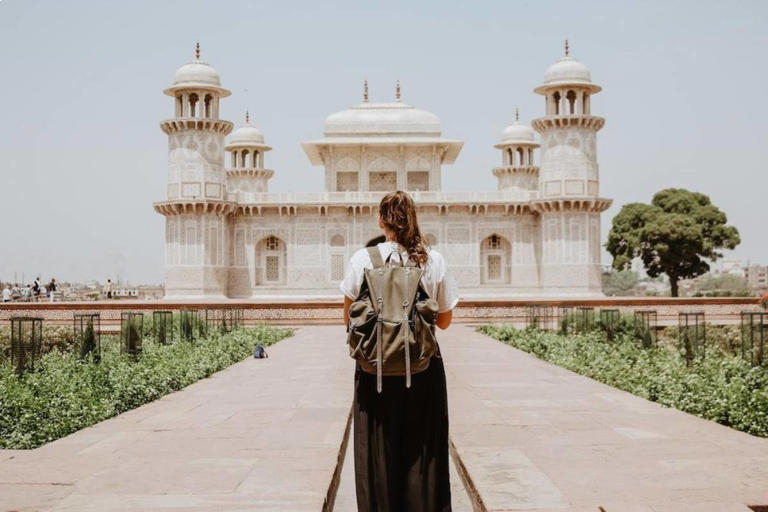
- Share full article
Advertisement
Supported by
Critic’s Notebook
Are These Really ‘the World’s 50 Best Restaurants’?
The places on this year’s “50 Best” list are endurance tests, theatrical spectacles, monuments to ego and — the two most frightening words in dining — “immersive experiences.”

By Pete Wells
To be media literate these days is to understand that no ranked list, whether it is the “100 Greatest Drummers of All Time” or the “35 Cutest Dog Breeds to Ever Exist,” should be taken too literally. We all know that the cuteness of the Maltipoo and the awesomeness of Keith Moon are matters of opinion.
When it comes to parsing the annual dining survey known as The World’s 50 Best Restaurants, though, you really have to open your mind. Forget asking whether these establishments are the best in the world. The bigger question is: Are they restaurants?
Consider some of the highest-ranking winners from this year’s edition , which was announced Wednesday night in a ceremony at the Wynn Las Vegas that began with feathered and painted dancers twirling light sticks to electronic dance music on a darkened stage.
Gaggan , in Bangkok, was named not just the ninth-best restaurant in the world but the single best restaurant in Asia. The chef, Gaggan Anand, greets diners at his 14-seat table facing the kitchen with “Welcome to my … .” completing the sentence with a term, meaning a chaotic situation, that will not be appearing in The New York Times.
What follows are about two dozen dishes organized in two acts (with intermission). The menu is written in emojis. Each bite is accompanied by a long story from Mr. Anand that may or may not be true. The furrowed white orb splotched with what appears to be blood, he claims, is the brain of a rat raised in a basement feedlot.
Brains are big in other restaurants on the list. Rasmus Munk, chef of the eighth-best restaurant in the world, Alchemist , in Copenhagen, pipes a mousse of lamb brains and foie gras into a bleached lamb skull, then garnishes it with ants and roasted mealworms. Another of the 50 or so courses — the restaurant calls them “impressions”— lurks inside the cavity of a realistic, life-size model of a man’s head with the top of the cranium removed.
Now, among the 50 Best are a number of establishments where they let you see a menu written in real words and order things you actually want to eat. Some of these, like Asador Etxebarri in Spain and Schloss Schauenstein in Switzerland, are hard to reach. Nearly all are very expensive. Still, there are places on the list where a relatively normal person might eat a relatively normal dinner and go home feeling relatively well-fed.
But the list is dominated by places that normal people can’t get into, where the few diners who will go to almost any length for reservations will go home feeling bloated and drunk. They are not restaurants, or not just restaurants. They are endurance tests, theatrical spectacles, monuments to ego and — the two most frightening words in dining — “immersive experiences.”
Whether the World’s 50 Best seeks out these spectacular spectaculars or has simply been hijacked by them is impossible to tell . The list’s website is a model that should be studied by anyone who wants to arrange words that sound important and don’t mean anything.
On the subject of what it takes to win the attention of the 1,080 “independent experts” who make up the organization’s voting body, the website has this to say: “What constitutes ‘best’ is up to each voter to decide — as everyone’s tastes are different, so is everyone’s idea of what constitutes a great restaurant experience. Of course, the quality of food is going to be central, as is the service — but the style of both, the surroundings, atmosphere and indeed the price level are each more or less important for each different individual.”
Well, that clears up that .
The World’s 50 Best Restaurants and its spinoff awards, by now almost too numerous to count, weren’t always so rarefied. In the early years, when the list was being published by Restaurants magazine, the editors saw it as a kind of anti-Michelin, and took pride in recognizing spots that would never, ever make Michelin’s little red guidebooks. Carnivore, an open-air meat buffet in a suburb of Nairobi, Kenya, came in at No. 47 in 2003.
No. 1 on the list that year, though, was the Spanish restaurant El Bulli, which set a standard for kitchen experimentation, highly manipulated food, restless change and marathon tastings to which the highest end of the business is still in thrall. The more famous the list became, the harder it was for a place like Carnivore to land a spot. Nobody much noticed, because the game that El Bulli played was starting to become the only one that mattered.
Today the list is dominated by tasting-menu restaurants, and every year those menus seem to get longer and more unforgiving. There are more courses than any rational person would choose to eat, and more tastes of more wines than anyone can possibly remember the next day. The spiraling, metastasizing length of these meals seems designed to convince you that there’s just no way a mere 10 or 15 courses could contain all the genius in the kitchen.
One well-traveled diner told me about a recent, four-hour meal at Disfrutar , in Barcelona — No. 1 this year. He said he was “blown away” and at the same time he never wants to go back. “It was an assault, and not fun,” he said.
Visits to the kitchen and other locations around the property, once an entertaining surprise, are now almost mandatory in any restaurant that aspires to a place on the list. The formula for success is so well-known that the structure of a meal in these restaurants is weirdly, depressingly conformist, even though you’re supposed to be amazed by the originality of it all. Once a revolt against stuffy, conservative dining hierarchies, the World’s 50 Best Restaurants now rewards a different kind of stuffiness and conservatism.
The contradiction at the core of the list is that it has become a publicity machine that directs enormous amounts of attention and business toward some of the least-accessible dining rooms in the world.
The chefs may fool themselves into believing that they’re operating idea factories, that they’re offering intellectual journeys and emotional wallops. But they’re really just competing for votes on a listicle that will reduce whatever they achieve in the dining room to strings of clichés on the World’s 50 Best Website. Table by Bruno Verjus , this year’s third-best restaurant, offers “stunning wine and incredible food.” A meal at Disfrutar is “the dining experience of a lifetime.”
That sounds stunning! And incredible! You know, though, the thing I’m wondering about this experience of a lifetime is whether I’m going to have a good time. But that’s not a question the World’s 50 Best Restaurants is set up to answer.
Follow New York Times Cooking on Instagram , Facebook , YouTube , TikTok and Pinterest . Get regular updates from New York Times Cooking, with recipe suggestions, cooking tips and shopping advice .
Pete Wells has been the restaurant critic for The Times since 2012. He was previously the editor of the Food section. More about Pete Wells
More on Food and Dining
Keep tabs on dining trends, restaurant reviews and recipes..
Breezy and adaptable, we’ve rounded up 100 easy summer recipes that can be on the table in 30 minutes or less.
Basting your steaks with butter is the secret to perfectly cooked meat at home. Here’s what to know about this hot restaurant trick .
Whether a food brand gets special protection hinges on complicated legal calculations. How good are you at spotting a real trademark? Take our quiz .
The most hotly anticipated restaurant opening in Los Angeles this year might be a sandwich shop from the “Vanderpump Rules” world .
Eating in New York City
Pete Wells, our restaurant critic, ranked his top 100 restaurants in New York City .
One family has owned Totonno’s, the beloved Coney Island pizzeria, through fire, flood and a pandemic. Now the business is up for sale .
Peter Pan, a Brooklyn doughnut shop born in the 1950s, conjures more than memories for the illustrator Rachelle Meyer.
A Times food editor documented the high, the low and the mid from a week’s worth of TikTok restaurant suggestions.
IELTS Exam Preparation: Free IELTS Tips, 2024
- elektrostal'
Take IELTS test in or nearby Elektrostal'
There is no IELTS test center listed for Elektrostal' but you may be able to take your test in an alternative test center nearby. Please choose an appropriate test center that is closer to you or is most suitable for your test depending upon location or availability of test.
Closest test centers are:
Make sure to prepare for the IELTS exam using our Free IELTS practice tests .
Moscow, Russia
Students international - moscow cb, students international - moscow, british council bkc-ih moscow, vladimir, vladimir oblast, russia, students international vladimir, obninsk, kaluga oblast, russia, british council bkc-ih obninsk, nizhny novgorod, nizhny novgorod oblast, russia, students international - nizhny novgorod, british council bkc-ih nizhny novgorod, voronezh, voronezh oblast, russia, british council bkc-ih voronezh, veliky novgorod, novgorod oblast, russia, lt pro - veliky novgorod, kazan, tatarstan, russia, students international - kazan, british council bkc-ih kazan, st petersburg, russia, lt pro - saint petersburg, students international - st petersburg, saratov, saratov oblast, russia, students international - saratov, british council bkc-ih saratov, petrozavodsk, republic of karelia, russia, lt pro - petrozavodsk, students international - petrozavodsk, kirov, kirov oblast, russia, students international - kirov, samara, samara oblast, russia, students international - samara, british council bkc-ih samara, volgograd, volgograd oblast, russia, students international - volgograd, british council bkc-ih volgograd, rostov-on-don, rostov oblast, russia, students international - rostov-on-don, syktyvkar, komi republic, russia, students international - syktyvkar, perm, perm krai, russia, students international - perm, british council bkc-ih perm, ufa, republic of bashkortostan, russia, students international - ufa, british council bkc-ih ufa, kaliningrad, kaliningrad oblast, russia, students international - kaliningrad, lt pro - kaliningrad, krasnodar, krasnodar krai, russia, students international - krasnodar, stavropol, stavropol krai, russia, students international - stavropol, astrakhan, astrakhan oblast, russia, students international - astrakhan, magnitogorsk, chelyabinsk oblast, russia, ru069 students international - magintogorsk, yekaterinburg, sverdlovsk oblast, russia, students international - ekaterinburg, british council bkc-ih ekaterinburg, chelyabinsk, chelyabinsk oblast, russia, british council bkc-ih chelyabinsk, students international - chelyabinsk, murmansk, murmansk oblast, russia, students international - murmansk, tyumen, tyumen oblast, russia, students international - tyumen, omsk, omsk oblast, russia, students international - omsk, novosibirsk, novosibirsk oblast, russia, british council bkc-ih novosibirsk, students international - novosibirsk, tomsk, tomsk oblast, russia, british council bkc-ih tomsk, students international - tomsk, barnaul, altai krai, russia, students international - barnaul, other locations nearby elektrostal'.
- Zheleznodorozhnyy
- Orekhovo-Zuyevo
- Sergiyev Posad
- Podol'sk
- Novo-Peredelkino
- Ryazan'
An Overview of the IELTS
The International English Language Testing System (IELTS) is designed to measure English proficiency for educational, vocational and immigration purposes. The IELTS measures an individual's ability to communicate in English across four areas of language: listening , reading , writing and speaking . The IELTS is administered jointly by the British Council, IDP: IELTS Australia and Cambridge English Language Assessment at over 1,100 test centres and 140 countries. These test centres supervise the local administration of the test and recruit, train and monitor IELTS examiners.
IELTS tests are available on 48 fixed dates each year, usually Saturdays and sometimes Thursdays, and may be offered up to four times a month at any test centre, including Elektrostal' depending on local needs. Go to IELTS test locations to find a test centre in or nearby Elektrostal' and to check for upcoming test dates at your test centre.
Test results are available online 13 days after your test date. You can either receive your Test Report Form by post or collect it from the Test Centre. You will normally only receive one copy of the Test Report Form, though you may ask for a second copy if you are applying to the UK or Canada for immigration purposes - be sure to specify this when you register for IELTS. You may ask for up to 5 copies of your Test Report Form to be sent directly to other organisations, such as universities.
There are no restrictions on re-sitting the IELTS. However, you would need to allow sufficient time to complete the registration procedures again and find a suitable test date.
SHARE THIS PAGE
The reading, writing and listening practice tests on this website have been designed to resemble the format of the IELTS test as closely as possible. They are not, however, real IELTS tests; they are designed to practise exam technique to help students to face the IELTS test with confidence and to perform to the best of their ability.
While using this site, you agree to have read and accepted our terms of use, cookie and privacy policy.
Elektrostal, Russia
Essential elektrostal.

Elektrostal Is Great For
Eat & drink.

- Apelsin Hotel
- Elektrostal Hotel
- Apart Hotel Yantar
- Mini Hotel Banifatsiy
- Restaurant Globus
- Amsterdam Moments
- Cafe Antresole
- Viki Cinema
- Statue of Lenin
- Park of Culture and Leisure
Expedia Rewards is now One Key™
Elektrostal, visit elektrostal, check elektrostal hotel availability, popular places to visit.
- Electrostal History and Art Museum
You can spend time exploring the galleries in Electrostal History and Art Museum in Elektrostal. Take in the museums while you're in the area.
- Cities near Elektrostal

- Places of interest
- Yuri Gagarin Cosmonaut Training Center
- Central Museum of the Air Forces at Monino
- Peter the Great Military Academy
- History of Russian Scarfs and Shawls Museum
- Ramenskii History and Art Museum
- Bykovo Manor
- Pekhorka Park
- Balashikha Arena
- Malenky Puppet Theater
- Drama Theatre BOOM
- Balashikha Museum of History and Local Lore
- Pavlovsky Posad Museum of Art and History
- Saturn Stadium
- Church of Vladimir
- Likino Dulevo Museum of Local Lore
- Orekhovo Zuevsky City Exhibition Hall
- Noginsk Museum and Exhibition Center
- Fairy Tale Children's Model Puppet Theater
- Fifth House Gallery
- Malakhovka Museum of History and Culture

IMAGES
VIDEO
COMMENTS
Hampi group of monuments are UNESCO World Heritage site and are an architectural wonder. Here is a complete Hampi Travel Guide for travellers. ... We have been travelling together since the last 15 years and writing independent and personal travel content since 2014. Travel is one of the best teachers and through this blog, we aim to share our ...
Below I have highlighted a few Hampi travel tips, like how to get to Hampi, and a bit about the bouldering scene in Hampi! Books to read on Hampi. ... Will Hatton is the founder of The Broke Backpacker and has been writing for the site since January 2013. He has been on the road for more than a decade, travelling to far-flung lands on a ...
This post is a Hampi Travel Guide that contains a detailed Hampi 2-day Itinerary. Hampi, a temple town in Karnataka is a UNESCO world heritage site situated on the banks of the Tungabhadra river. ... I'm Soujanya Rai, an Indian-origin Germany-based techie following her passion for travel, photography, and writing. I have a love affair with ...
1. Explore the Ruins. The city of Hampi is a labyrinth of ancient ruins, and exploring Tomb Raider style was our favourite thing to do during our visit. The remains of sacred temples, shrines and monuments stand proudly among unexplainable rock formations, creating a landscape that is almost other-worldly.
How to Reach Hampi. Flight: Toranagallu (11 km), Bellary (61 km) and Belgaum (191 km) are the nearest airports to Hampi. However, since flights are limited to these locations, it would be best to fly to Bangalore (351 km) and then take a bus or hire a car and drive for around 6 hours to Hampi. Book your flight here.
Essential Travel Guide for Visiting Hampi in Karnataka. The Evocative Ruins of One of India's Greatest Hindu Kingdoms. Laid-back Hampi was the last capital of Vijayanagar, one of the greatest Hindu kingdoms in India's history. The area has some amazing ruins, intriguingly intermingled with large boulders that dot the landscape.
How to travel within Hampi: The most convenient way to travel in and around Hampi is by auto. The daily fare of an auto is around INR 1000. Don't forget to bargain a bit. You can rent a scooter and bike at INR 200 - 300 per day depending on the type of vehicle. You can also rent bicycles at INR 100 - 150 per day.
Profound History of Hampi - UNESCO Heritage Site. Hampi is located within Bellary district of Karnatak. Hampi is the erstwhile capital of the Vijayanagara Empire that sprawled and ruled in the 14 th century. The city now stands true to its once bustling wealthy and grand status on the banks of the Tungabhadra River with numerous temples, architectural ruins, stone bridges, trading, green ...
How much budget is required for travelling to Hampi. Some other tips for travelling to Hampi. Things to do in Hampi. 1 . Visit sacred Virupaksha Temple in Hampi. Virupaksha templeis one of the oldest functioning temples in India and is dedicated to Lord Shiva. The temple is the main centre of pilgrimage in Hampi.
9. Hampi Stone chariot. The stone chariot is by far the most impressive excavation site of Hampi. It's the flagship tourist attraction and the reason why most people are drawn in to take a visit. The chariot is not just a statue but actually a temple that is dedicated to Lord Vittala, another aspect of Lord Vishnu.
September to March: The season in Hampi starts in September and peaks in December/January and ends by March. This is the time when the weather is the best in Hampi and allows you to spend more time outdoors. It can get really crowded towards December end and January. So make sure to plan your travel ahead of time.
Hampi is a UNESCO World Heritage Site known for its rich history and stunning architecture. Here are some of the must-visit places in and around Hampi: Virupaksha Temple: This is the main center of pilgrimage at Hampi and is considered the most sacred sanctuary. The temple's history dates back to the 7th century.
On Hampi, A Travel Essay. I got lost in Hampi. A coddled, ruined city in Western India (Karnataka), Hampi was carved into life in the 14th Century, nestled between steep, stone mountains that reach recklessly for the powder blue cosmic ceiling and curled around by the perennially boisterous and unfordable River Tungabhadra.
Hampi is absolutely beautiful to explore, however, you'll be exposed to the sun quite a bit as there's little shade. Be sure to wear sunscreen and bring plenty of water with you. Hampi is a sprawling site of 3.2 acres. Although you could walk it, enter the 21st century and hire a rickshaw to take you around.
Kama Sutra The Holi Festival The placid Tungabhadra River gently flows past the ruins of Hampi. A night-train ride northwest of Bangalore, Hampi seems to exist in a sphere of its own, a self-contained combination of timeless natural wonder and historical human impact.Here the ruins of ancient civilisations pepper the rocky landscapes while restaurants pander to the requirements of the tourist ...
Hampi solo travel is more about local experiences, thus proving to be a cost-effective trip. A three-day trip to Hampi can be planned on a budget of under 5,000 INR (70 USD or 61 EUR). I am sharing an estimate of the amount that you must allocate for each parameter to help you plan and manage your expenses.
Hampi Bazaar. Hampi Bazaar is a popular store where auto drivers take visitors for shopping. They have a variety of products, including special oils and scarves. The banana fibre products are also sold here but at an elevated price. Hampi Bazaar is great for buying souvenirs and other things, as everything is available under one roof. Local shops
Hampi or Hampe (Kannada:), also referred to as the Group of Monuments at Hampi, is a UNESCO World Heritage Site located in Hampi (City), Ballari district now Vijayanagara district, east-central Karnataka, India. Hampi predates the Vijayanagara Empire; it is mentioned in the Ramayana and the Puranas of Hinduism as Pampa Devi Tirtha Kshetra. Hampi continues as a religious centre, with the ...
Hampi is a great place to spend a few days wandering around and discovering the rich, vibrant history while also having a bit of 'you' time. Hampi hosts Hampi Utsav every year during first week of November. It is a visual delight as all the monuments/ruins are lit at night and it is a cultural extravaganza of dance and music. 2010 marked 500 ...
Mastering the art of travel writing is not hard, but you have to put in a lot of dedication, effort, and time. This is a captivating genre that allows you to share your experiences, observations ...
map to travel: Medvedkovo. Wikipedia. Photo: Antares 610, CC BY 3.0. Notable Places in the Area. Babushkinskaya. Metro station Photo: Aborisov, Public domain. Babushkinskaya is a Moscow Metro station in the Babushkinsky District, North-Eastern Administrative Okrug, Moscow. Sviblovo.
The places on this year's "50 Best" list are endurance tests, theatrical spectacles, monuments to ego and — the two most frightening words in dining — "immersive experiences."
The International English Language Testing System (IELTS) is designed to measure English proficiency for educational, vocational and immigration purposes. The IELTS measures an individual's ability to communicate in English across four areas of language: listening, reading, writing and speaking. The IELTS is administered jointly by the British ...
A mix of the charming, modern, and tried and true. See all. Apelsin Hotel. 43. from $48/night. Apart Hotel Yantar. 2. from $28/night. Elektrostal Hotel.
Travel Guide. Check-in. Check-out. Guests. Search. Explore map. Visit Elektrostal. Things to do. Check Elektrostal hotel availability. Check prices in Elektrostal for tonight, Apr 20 - Apr 21. Tonight. Apr 20 - Apr 21. Check prices in Elektrostal for tomorrow night, Apr 21 - Apr 22. Tomorrow night.